Introduction

If you ask all the photographers, which single prime lens they would choose if they could own only one lens in the world, the majority would say the 35mm, and most of the rest would say a fast 35mm. This is because it is one of the most versatile prime lenses. Although it’s a wide-angle lens, it is sometimes referred to as the alternative normal lens because it is so close to the standard focal length that it does not distort the subject much. With such lenses, you can also get a good background separation with a nice bokeh. They are useful in almost all kinds of photography, especially in everyday photography, street photography, environmental portraits, landscapes, weddings, events, and travel. Additionally, it works well for stitched astrophotography.
Its popularity has led to numerous 35mm lenses being produced by various manufacturers from the early days of photography to the modern era. In this article, I will compare six of them, from vintage to old to new. Let’s have a look together!
Sample Images


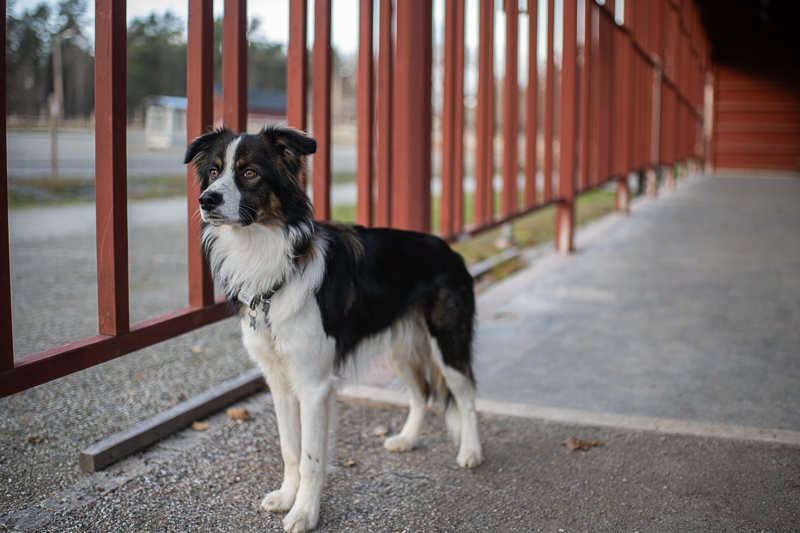


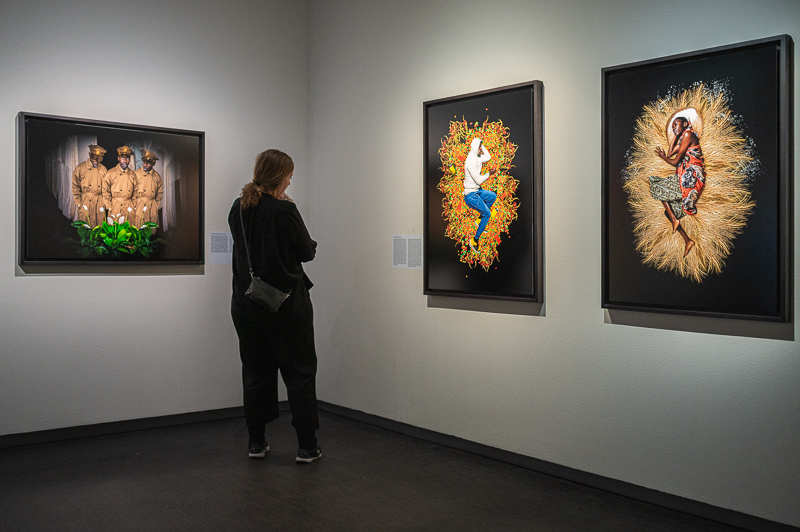

Most of the sample images in this review and many more can be found in higher resolution on the following links: Zeiss 35/14 HFT, Pergear 35/1.4, Tamron 3571.4 USD, Sigma 35/1.4 HSM Art, Nikon 35/1.4 Ai-s, Nikon Z 35/1.8 S.
Contents
Disclosure / Contenders
The lenses in the comparison are two vintage lenses, a modern but similar to the vintage lenses, two new AF lenses designed for DSLR, and a modern mirrorless lens
- Carl Zeiss Distagon 35mm 1.4 HFT (CZ)
- Pergear 35mm 1.4 (PG)
- Nikon Nikkor 35mm 1.4 Ai-S (NA)
- Tamron SP 35mm f/1.4 Di USD (TU)
- Sigma 35mm f/1.4 HSM Art (SA)
- Nikon Nikkor Z 35mm 1.8 S (NZ)
The Zeiss 35/1.4 Distagon and the Nikon 35/1.4 Ai-s were kindly provided by our reader Christian G. The Pergear 35/1.4 and the Sigma 35/1.4 HSM Art were kindly provided by our reader Nikolaus B., the Tamron 35/1.4 UST was kindly provided by our reader Wolfgang J.
Big thanks to these passionate and helpful people for sending their lenses on loan for this comparison, which would not have been possible otherwise.
Nikkor Z 35/1.8 S, I bought this myself.
Only the Nikkor Z 35/1.8 had the Nikon Z mount, all the other lenses were mounted on the Nikon Z cameras with different adapters:
- Megadap ETZ-21 Pro, Sony E-to-Nikon Z, AF, kindly provided by Megadap
- Viltrox EF-Z, Canon EF-to-Nikon Z, AF, kindly provided by Viltrox
- Nikon FTZ, Nikon F-to-Nikon Z, bought with my own earned money
- Rollei QBM-to-Nikon Z, K&F, bought exclusively for this test with my own earned money
For further info see the “Adapters” section!
All the tests were done on a Nikon Z 7II (unless stated otherwise), sample images were taken with either a Nikon Z 7II or a Nikon Z6.
In the different tests here, I give a ranking between the six lenses depending on their performance compared to each other, from first place to sixth.
Specifications
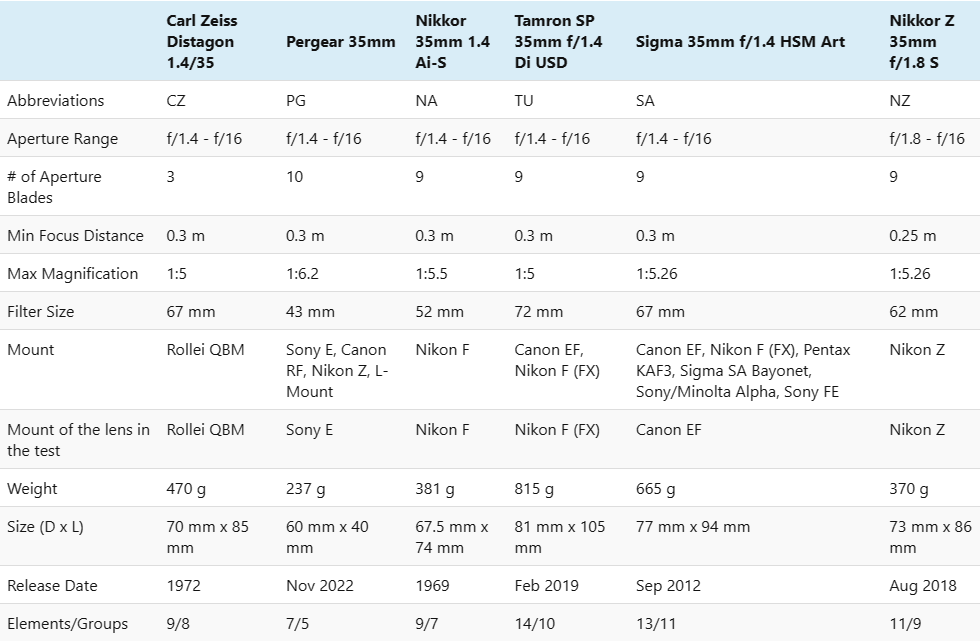
Handling
Carl Zeiss Distagon 35mm 1.4 HFT
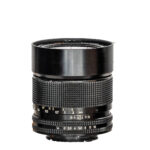
The second oldest lens in this comparison from 1972, is this completely manual lens with no electric contacts, made of ultimate quality and expensive HFT (High Fidelity Transmission) glass for top-of-the-line Rolleiflex SL350 cameras in former West Germany. It has a tight assembly and feels extremely well built and heavy for its size, as there are only glass and metal in the lens.
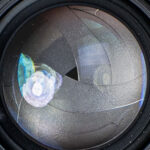 This Carl Zeiss lens has a very rare ingenious iris arrangement with 9 blades, which together form a triangular aperture shape when it is stopped down. It has a floating element design, with the front element completely independent of the other lens elements.
This Carl Zeiss lens has a very rare ingenious iris arrangement with 9 blades, which together form a triangular aperture shape when it is stopped down. It has a floating element design, with the front element completely independent of the other lens elements.
The rubberized focusing ring, which rotates ≈115º, is precise and smooth like a dream—a very well-built mechanical piece of engineering. The aperture ring is clicked equidistantly at every full stop.
Buy it: ebay.com, ebay.de, ebay.co.uk ~$900 (Affiliate links)
Pergear 35mm 1.4
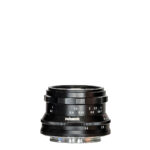 If the number of superlatives was a category this lens would win there. The newest, smallest, lightest, simplest, and cheapest lens with the longest focus throw in the list, is this fully mechanical lens without any electric contacts from a relatively new lens manufacturer. While small and fiddly, it feels well-built with tight assembly of metal. Smooth focusing ring that turns 160º, which is a lot more than the Zeiss. Like the Zeiss, it lacks weather sealing.
If the number of superlatives was a category this lens would win there. The newest, smallest, lightest, simplest, and cheapest lens with the longest focus throw in the list, is this fully mechanical lens without any electric contacts from a relatively new lens manufacturer. While small and fiddly, it feels well-built with tight assembly of metal. Smooth focusing ring that turns 160º, which is a lot more than the Zeiss. Like the Zeiss, it lacks weather sealing.
The aperture ring has the strangest and most confusing click stops I have ever seen; Between 1.4 and 2.8 markings (2 f-stops) there are three click stops but no markings. Between 2.8 and 4 (1 f-stop) two click stops but no markings, so click stops at each one-third of a stop? Then only clicks at each full stop at 4, 5.6, and 8, between 8 and 16 (2 f-stops) there is no click stop at all but a dot marking, supposedly indicating f/11 but no click stop there.
The distance between aperture values is hugely different. I also found out that on my sample the f-stop markings after f/1.4 are not precise, f/2.8 is actually not f/2.8, I measured it to be only f/2, and the same is valid for other f-stops until f/5.6, from which point the markings seem to in accordance to the what they indicate. So, take the values with a pinch of salt, in the tables and tests in this article I write what is given on the lens and not what it actually is.
Buy it: Pergear $123 (Affiliate link)
Nikon Nikkor Z 35mm 1.8 S
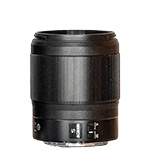
Nikon Nikkor Z 35mm f/1.8 S both seems and feels to be built very well. It is mostly made of plastic but the mounting plate and focusing ring are made of metal. The manual focus ring is wide and nicely damped. It can be programmed to be either a focusing ring, aperture ring, exposure compensation, or ISO sensitivity ring. There is also an MF-AF switch on the barrel. AF is done by a focus-by-wire stepping motor. Autofocus is reliable, precise, and quick. The lens is weather-sealed and the front element has a fluorine coating for repelling moisture and dust.
Buy it: amazon.com, amazon.de, amazon.co.uk $697 (Affiliate link)
Tamron SP 35mm f/1.4 Di USD
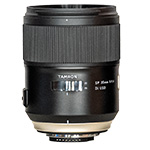 One of the newer lenses in the comparison from 2019 (newer than the Nikkor Z) is this Tamron SP 35/1.4 USD, released on the 40th anniversary of Tamron’s SP line of lenses. Tamron claimed it was their finest lens ever. An AF lens designed for DSLR. It is the biggest and heaviest lens on the list and looks a bit oversized for being a 35mm lens. This lens has weather sealing. The big rubberized focusing ring turns smoothly about 150º and allows for precise manual focusing. It seems to be of metal and looks very well built.
One of the newer lenses in the comparison from 2019 (newer than the Nikkor Z) is this Tamron SP 35/1.4 USD, released on the 40th anniversary of Tamron’s SP line of lenses. Tamron claimed it was their finest lens ever. An AF lens designed for DSLR. It is the biggest and heaviest lens on the list and looks a bit oversized for being a 35mm lens. This lens has weather sealing. The big rubberized focusing ring turns smoothly about 150º and allows for precise manual focusing. It seems to be of metal and looks very well built.
Like the Nikkor Z the AF ring is active during AF, which means you can override the AF at any time. The mechanism is different though, it utilizes Tamron’s USD AF, which is a DSLR typical ring-type motor. Used with an adapter on mirrorless cameras has it its limitations. You can only rely on AF while your subject is in the center area of the frame. On DSLR it is quite reliable and quick like native lenses though. You can see the focus scale through a window on the top of the lens and there is an AF on-off button on the side of the lens.
Buy it: amazon.com, amazon.de, amazon.co.uk $ (Affiliate links)
Buy it: ebay.com. ebay.de, ebay.co.uk $375-$700 (Affiliate links)
Sigma 35mm 1.4 HSM Art
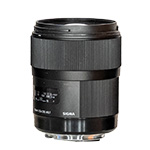 Sigma 35mm HSM Art was a sensation when it was released back in 2012. It was Sigma’s first professional lens in the Art series to mark a new era in Sigma’s lens production of high optical, material and build quality lenses with consistent quality control to avoid sample variances. It looks very nice with a barrel of metal. The focusing ring is large and rubberized, it turns very smoothly with a throw of about 90º, which is the limit for setting the precise focusing.
Sigma 35mm HSM Art was a sensation when it was released back in 2012. It was Sigma’s first professional lens in the Art series to mark a new era in Sigma’s lens production of high optical, material and build quality lenses with consistent quality control to avoid sample variances. It looks very nice with a barrel of metal. The focusing ring is large and rubberized, it turns very smoothly with a throw of about 90º, which is the limit for setting the precise focusing.
The Sigma offers a small window on top for showing a focusing scale and an AF ON-OFF button. It has a full-time manual focus override and utilizes Sigma’s HSM AF, which is a DSLR typical ring-type motor. Used with an adapter on mirrorless cameras it has its limitations. You can only rely on AF while your subject is in the center area of the frame. On DSLR it is quite reliable and quick like native lenses though. The barrel, unlike the Tamron and Zeiss, is of hard plastic (Polycarbonate), this is possibly the reason for its lighter weight.
Buy new: amazon.com, amazon.de, amazon.co.uk, $ (Affiliate links)
Buy used: ebay.com, ebay.de, ebay.co.uk, $420 (Affiliate links)
Nikon Nikkor 35mm 1.4 Ai-S
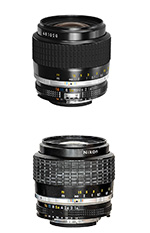 The oldest lens in the comparison (1969), the Nikon Nikkor 35mm f/1.4 Ai-s, from Nikon’s heyday, was found in every photojournalist’s bag throughout the 1970s and 1980s as their standard lens. It has a traditional spherical design with floating elements for close-range correction (CRC). Multicoated (Nikon’s first multi-coated lens back in 1970). As the aforementioned Zeiss, it is mechanically excellent with a smooth and precise manual focusing ring that turns ≈110º, but the focusing is not even, it is certainly due to the age or reparations. Also here we have equidistant aperture click stops at every full stop like the Zeiss—a joy to use if you like fully manual operation.
The oldest lens in the comparison (1969), the Nikon Nikkor 35mm f/1.4 Ai-s, from Nikon’s heyday, was found in every photojournalist’s bag throughout the 1970s and 1980s as their standard lens. It has a traditional spherical design with floating elements for close-range correction (CRC). Multicoated (Nikon’s first multi-coated lens back in 1970). As the aforementioned Zeiss, it is mechanically excellent with a smooth and precise manual focusing ring that turns ≈110º, but the focusing is not even, it is certainly due to the age or reparations. Also here we have equidistant aperture click stops at every full stop like the Zeiss—a joy to use if you like fully manual operation.
The sample I got for the test was repaired and the focusing ring had been replaced, I put an image of how it should look on top and the one I tested on the bottom. It is working and has relatively clean glasses, but on a condition scale of 1 to 10, I would rate it 3, (1 being not functional/defect, 2 having serious scratches, fungus, haze on the glasses).
Buy used: ebay.com, ebay.de, ebay.co.uk $250-$500 (Affiliate links)
When it comes to rating the lenses in this section, the result can vary. I look at the ease of use, size, weight, functionality, and efficiency of operations. As the lenses in this comparison are either designed for film cameras, DSLR, or mirrorless cameras, many of these aspects can dramatically be impacted depending on which kind of camera you are using, and whether you are adapting the lens.
Ease of Use
As I used them on a mirrorless Nikon Z camera I had to use adapters for most of them and that had an impact on the handling, size, and weight. Here is a picture of the lenses with adapters attached.
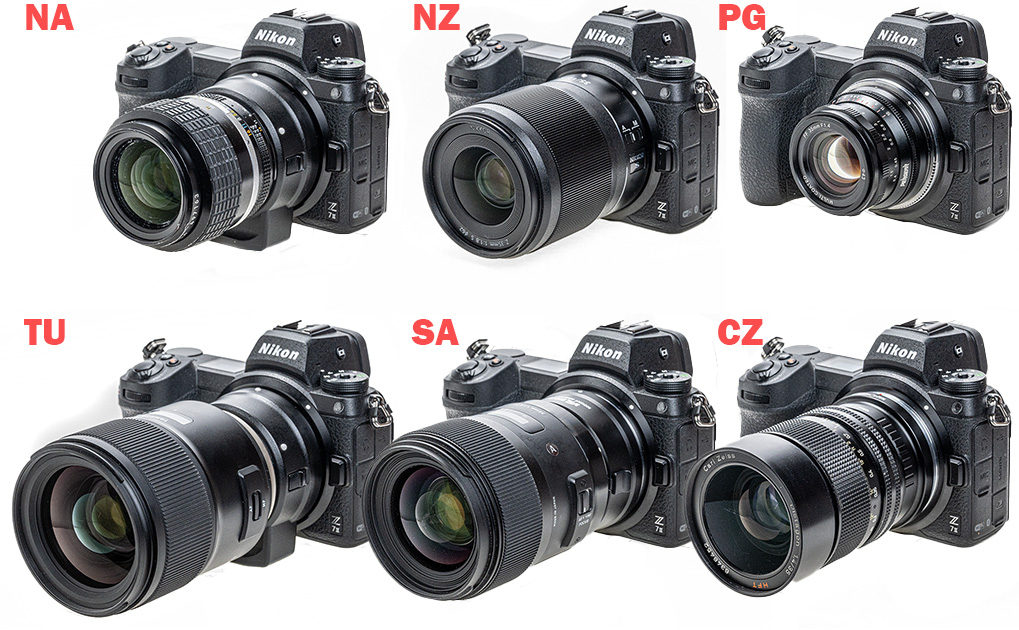
As you can see in this image, the size advantage of Zeiss and Nikon F lenses is turned to the opposite as they get bigger than the Nikon Z lens, when used with an adapter. Also, the hassle of using an adapter has a direct negative impact. So let’s do three ratings to be fair:
On mirrorless cameras (in this case Nikon Z):
- I rate the Nikon Z as the overall and clear winner here, as it is the most versatile with its programmable ring, fast and reliable autofocus, irrespective of where in the frame the subject is, with all-time manual override. It is also the second lightest and smallest of all lenses, and it does not require an adapter (on Nikon Z bodies).
- Pergear (provided it comes in native mount), as it can be used without an adapter and it is so small and light that it is easy to handle and carry in the bag or even pocket at all time
- Sigma is a little larger and heavier than Nikon F, but the AF and aperture control from the camera and also the EXIF info make the overall usage much more enjoyable
- Nikon F (Ai-s), the size and weight in this case win over the rest (provided the focus is even on the sample)
- Zeiss, basic functionality works very nice but it is very heavy for what it is
- Tamron’s monstrous size and weight is a very big disadvantage here
On DLSR:
- Sigma is the winner as it does everything at least as well as the others or not far from the best
- Tamron comes second just because of its size and weight, it seems to have better build quality than the Sigma though
- Nikon Ais, as it does everything the Zeiss does, but is smaller and lighter
- Zeiss
On analog cameras or for manual operation enthusiasts
If you are a fan of manual lenses or you want ease of use and do not care to control the aperture from the camera, then the Nikon Ai-s comes first and Zeiss second just because it’s bigger and heavier.
- Nikon Ais works flawlessly and operates beautifully, is small and light
- Zeiss works and operates like a dream but is larger and heavier than the NA
- Sigma
- Tamron comes after the Sigma just because of its larger size and heavier weight
Optical Features
It is quite amazing that not even two of these lenses have the same field of view. NZ has the widest and the CZ has the narrowest FoV. Another fact is that some of the lenses have a different center of view and the image is a little offset.
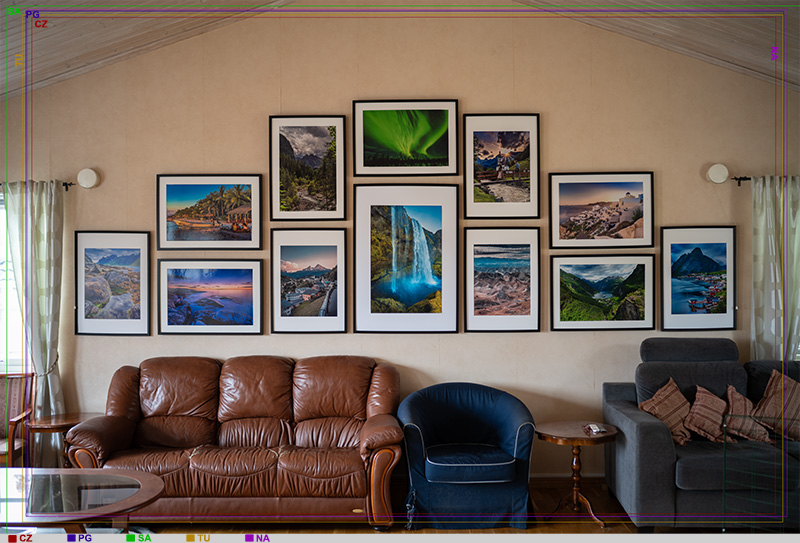
Sharpness (Infinity)

For the infinity sharpness test, we look at three areas of the image, center, mid-frame, and corner, for all 6 lenses from the same spot. To be fair towards Pergear I did not include any images neither for f/2 or f/11, as it is uncertain where f/2 is and it is not possible to select f/11. Also note that for the Pergear, I have used the apertures that are marked on the lens, as for the others.
-
- Wide Open: TU looks best, NZ and SA are about the same, then CZ, NA, and PG, except in the corner where NA and PG swap places and NA comes last.
- f/2: Same placement as at wide open for the three best lenses, then NA, and last CZ. PG not present.
- f/2.8: In the center and midframe the order is TU, NZ, SA, NA, CZ, PG. In the corner, SA comes over NZ with TU still being best and NA falls to the last place
- f/4: NZ seems to get a boost and climbs to the first place. The order for all three points is: NZ, TU, SA, NA, CZ, PG
- f/5.6: Here all the lenses are excellent in the center, NZ looks best as at the previous f-stop, but it seems that SA climbs up one place to the second place and NA also improves to a shared third place with TU. CZ and PG come just after. In the midframe, NZ loses its top position to SA and shares second place with TU, NA/CZ in third place about the same, and PG in last place. In the corner the order changes: TU SA, NZ, PG, CZ, NA.
- f/8: In the center all are excellent, but SA seems to have the edge, the most impressive improvement comes from NA which is as good as NZ and TU. CZ, PG follow. midframe SA, NZ, TU, CZ, NA, PG. Corner TU, NZ, SA, PG, NA, CZ.
- f/11 and f/16: More or less the same story but the diffraction effect steals some of the sharpness
In general TU, NZ, and SA have very good to excellent sharpness in the center, good to excellent in the midframe, and good to very good in the corners. The other three have good to excellent in the center, good to very good in the midframe, and OK to good in the corners.
It is difficult to rank the lenses clearly, but to put some ranking:
WO up to f/4: TU, NZ, SA, CZ, NA, PG
At f/4 – f/5.6: NZ, TU, SA, CZ, NA, PG
At f/8 – f/16: SA, NZ, TU, CZ, NA, PG.
Points: Center: CZ(4), PG(4), NZ(5), SA(5), TU(5), NA(4).
Points: Mid: CZ(3), PG(3), NZ(4), SA(4), TU(4), NA(3).
Points: Corner: CZ(2), PG(2), NZ(3.5), SA(3.5), TU(3.5), NA(2).

Sharpness (Portrait)
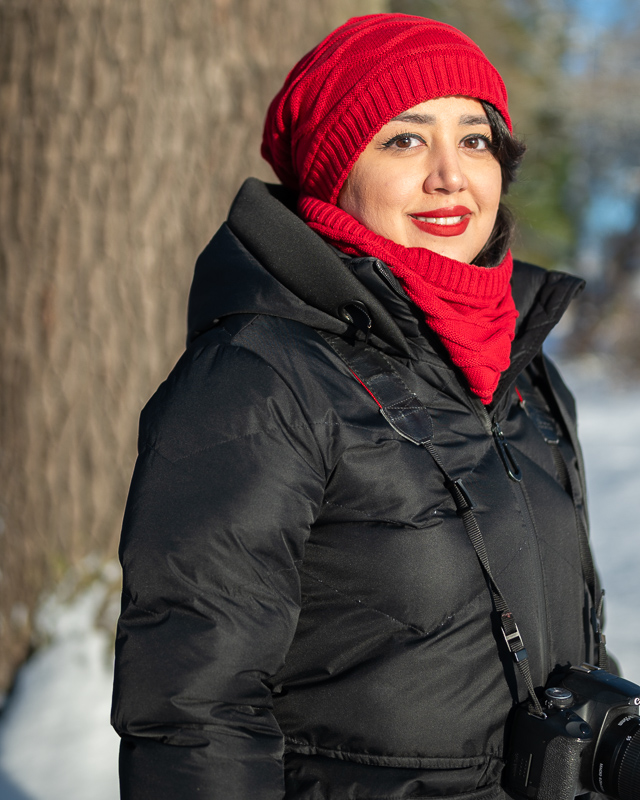
Nikon Z6 | Nikkor 35/1.4 Ai-s | f/1.4Let’s look at the portrait distance (about one meter for 35mm) at the very center (Greta Garbo), the center’s inner periphery (1/3 rule intersection) (Abraham Lincoln), and the center’s outer periphery (mid-frame) (George Washington), points of interest for portraits.
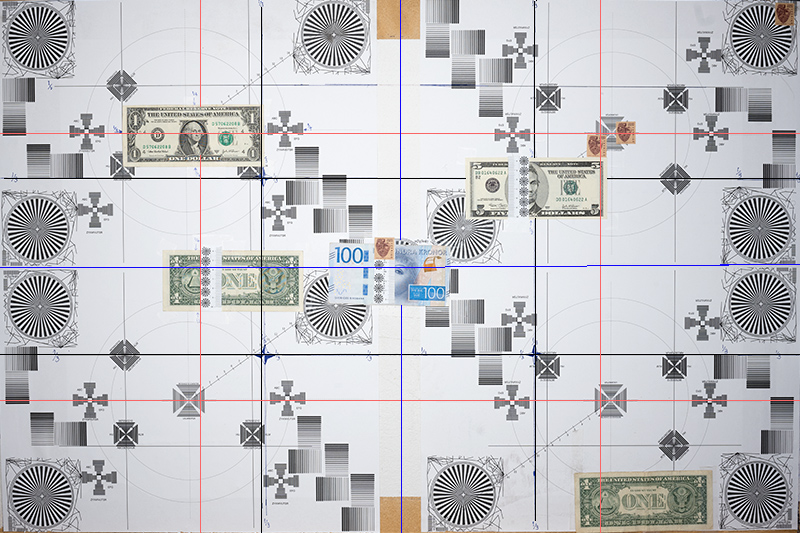
We look at the 4 widest apertures; WO: Wide Open (1.8 for NZ, 1.4 for others), f2, f2.8, and f4.
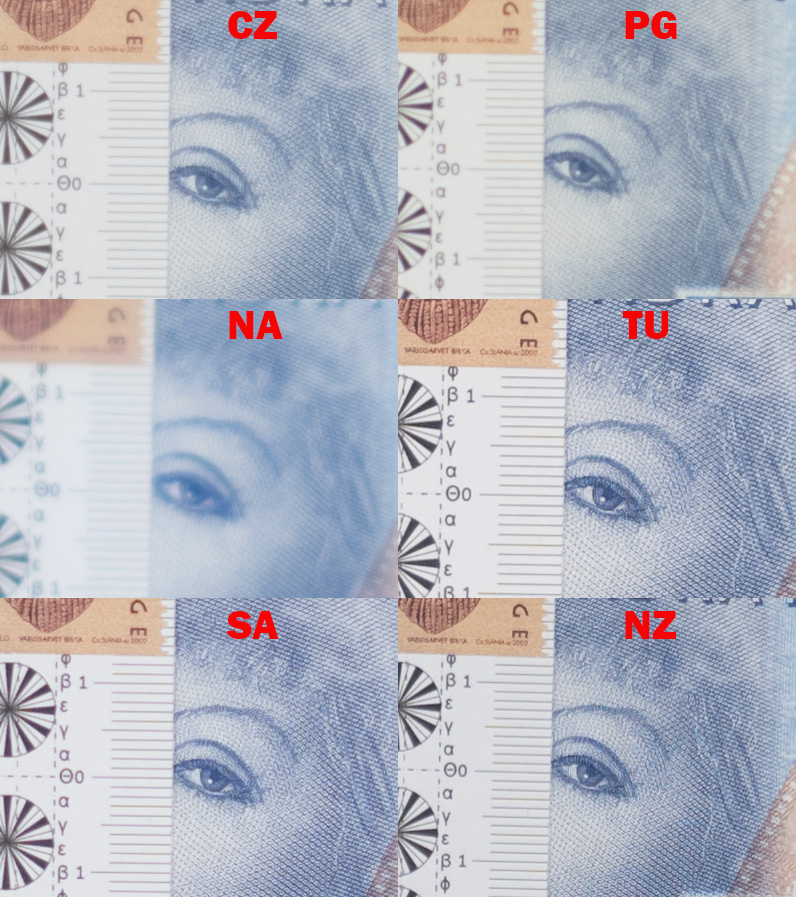
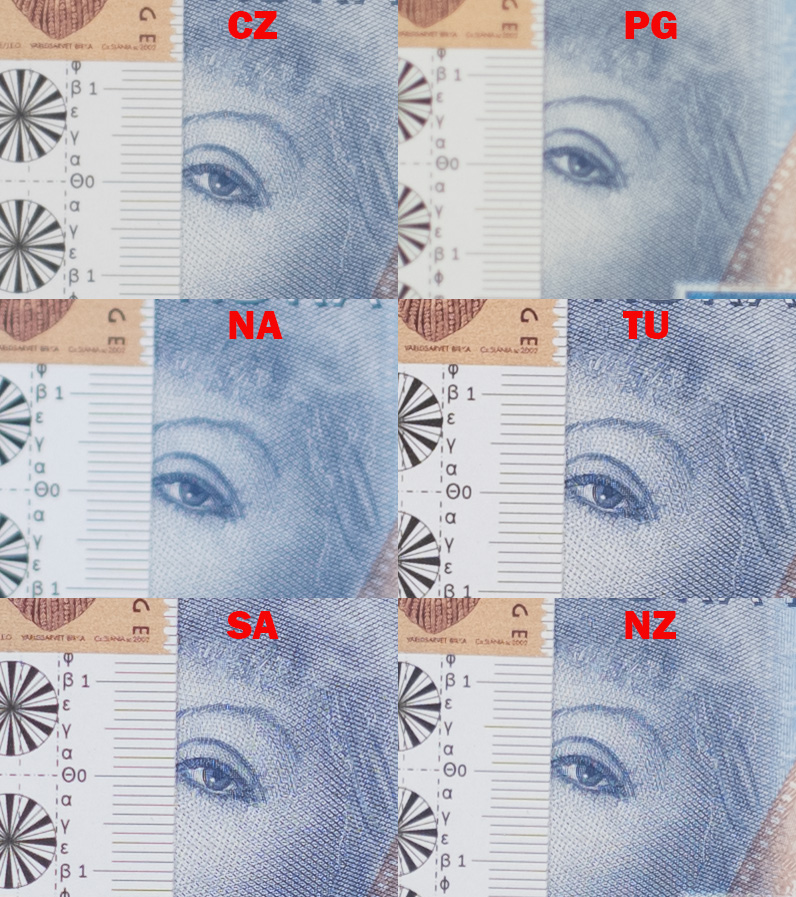
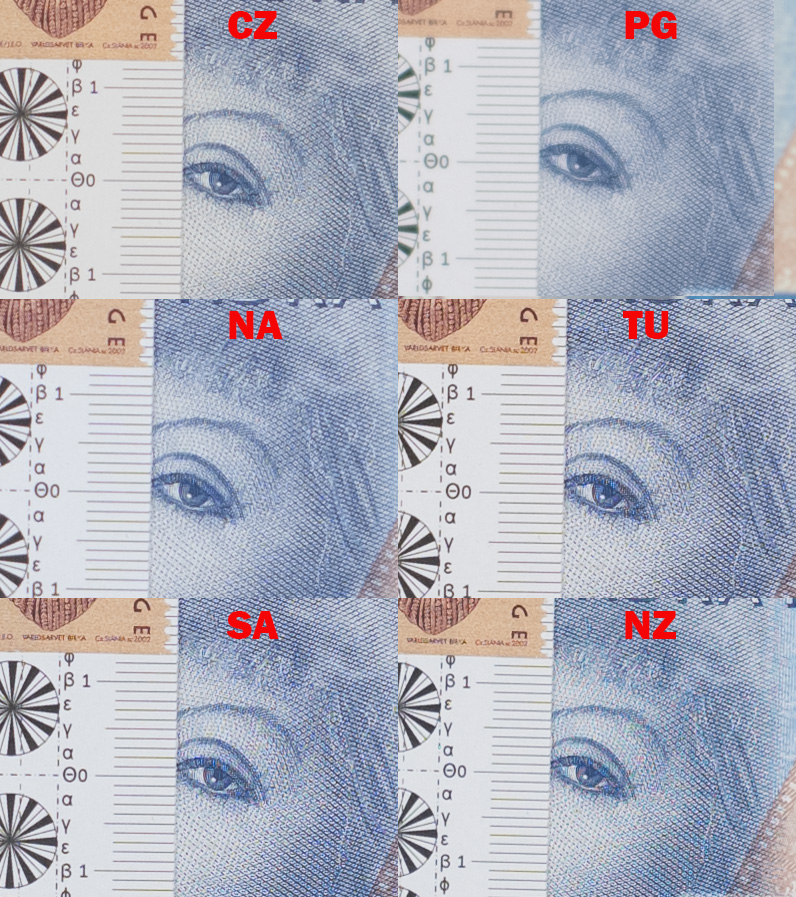
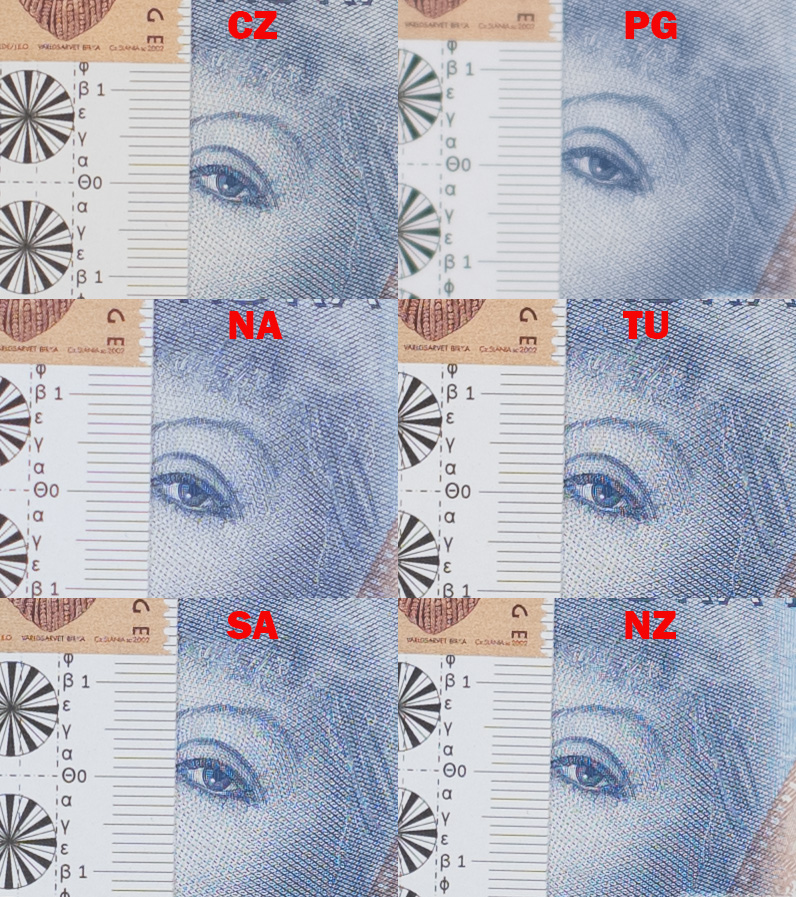
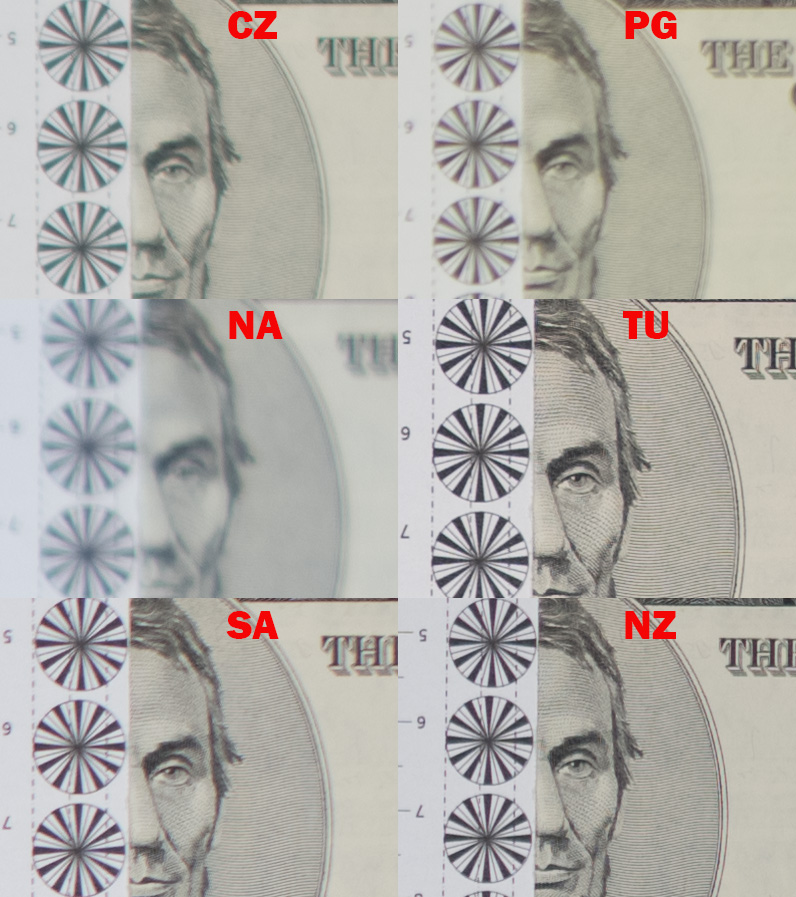
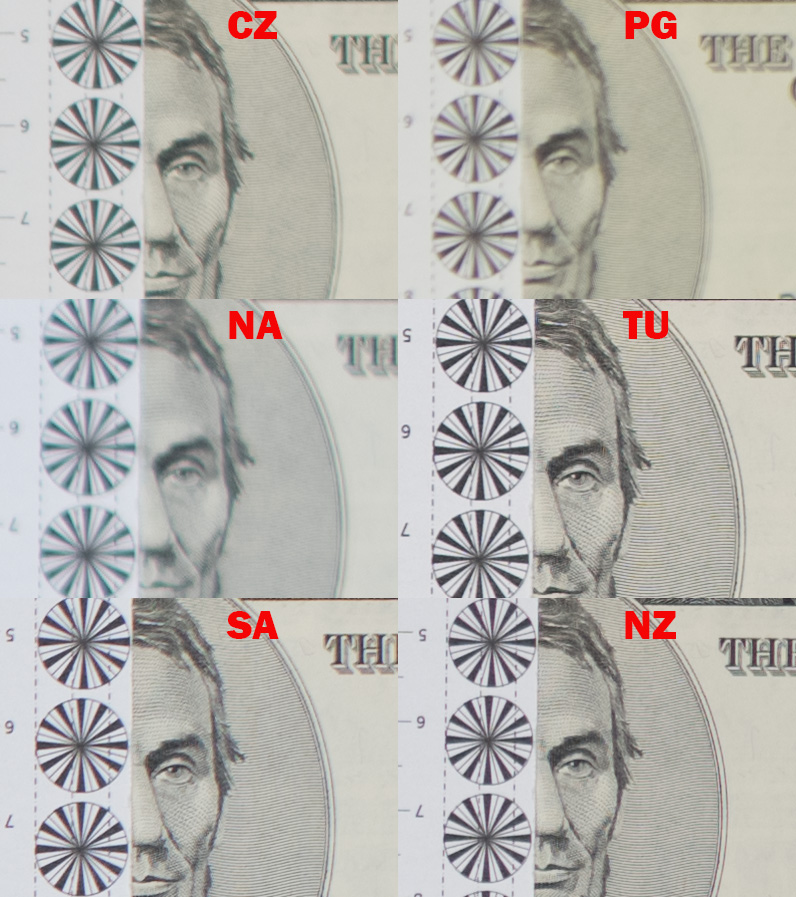
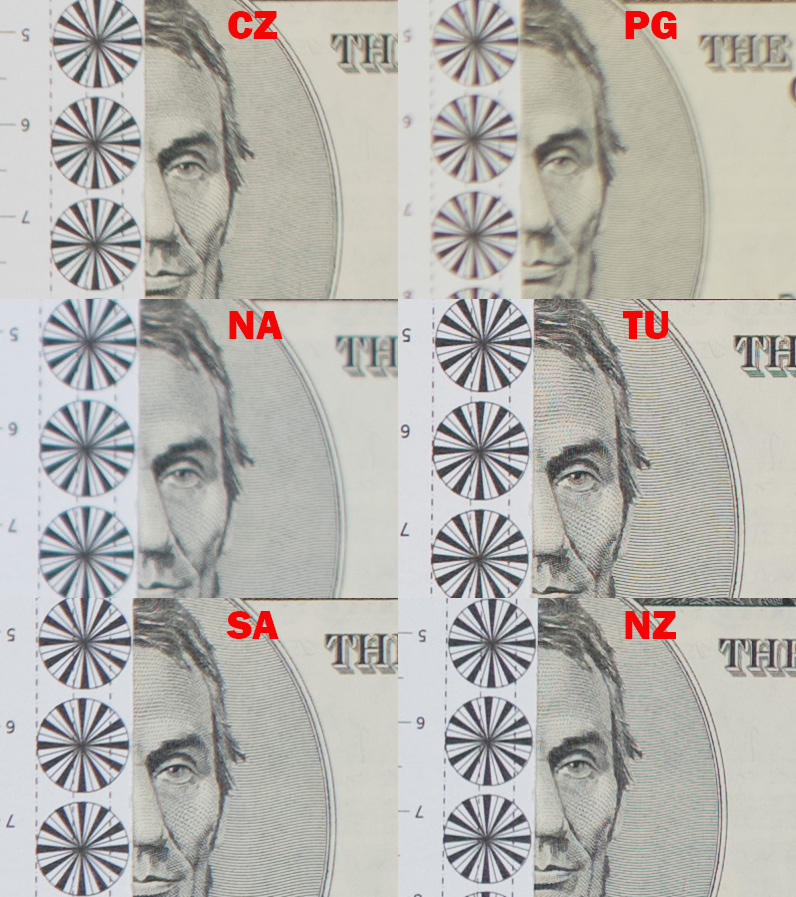
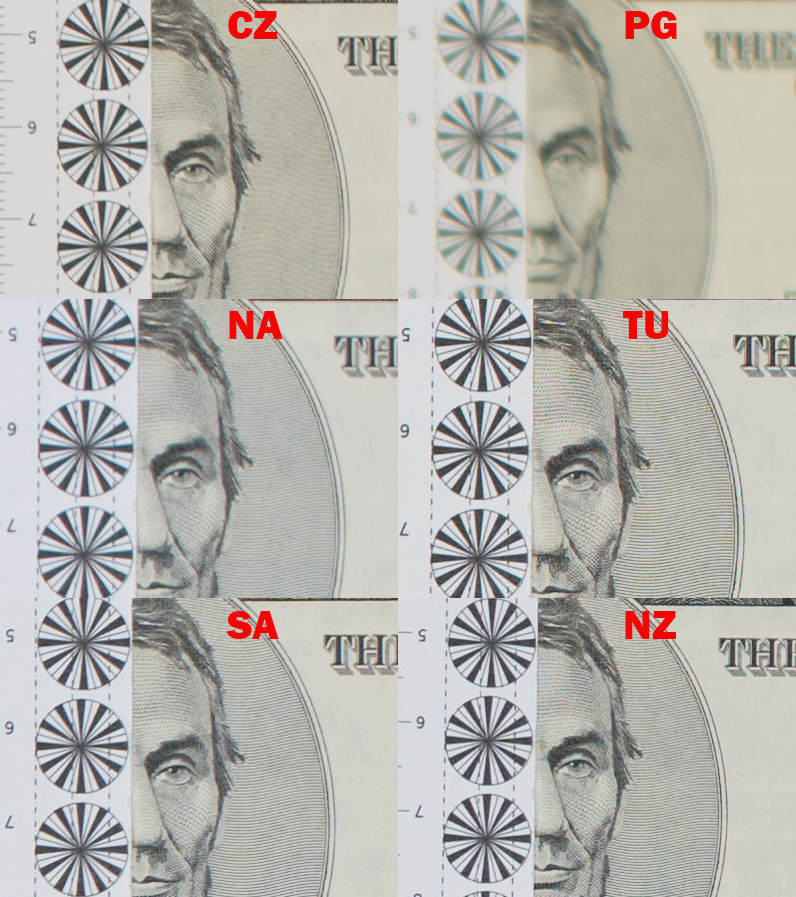
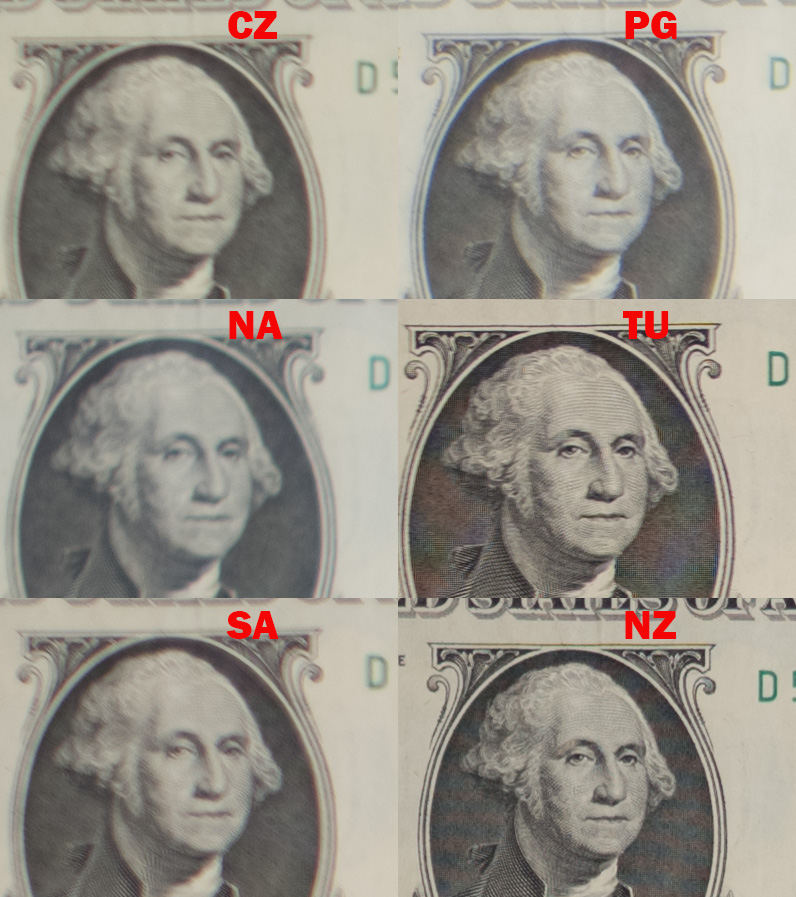
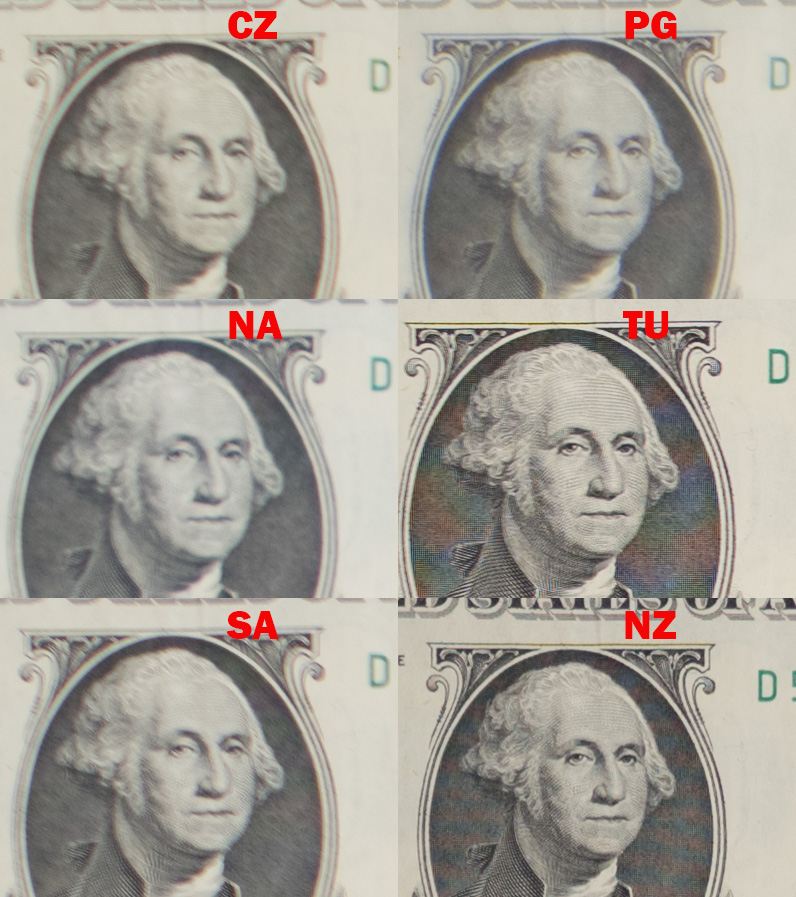
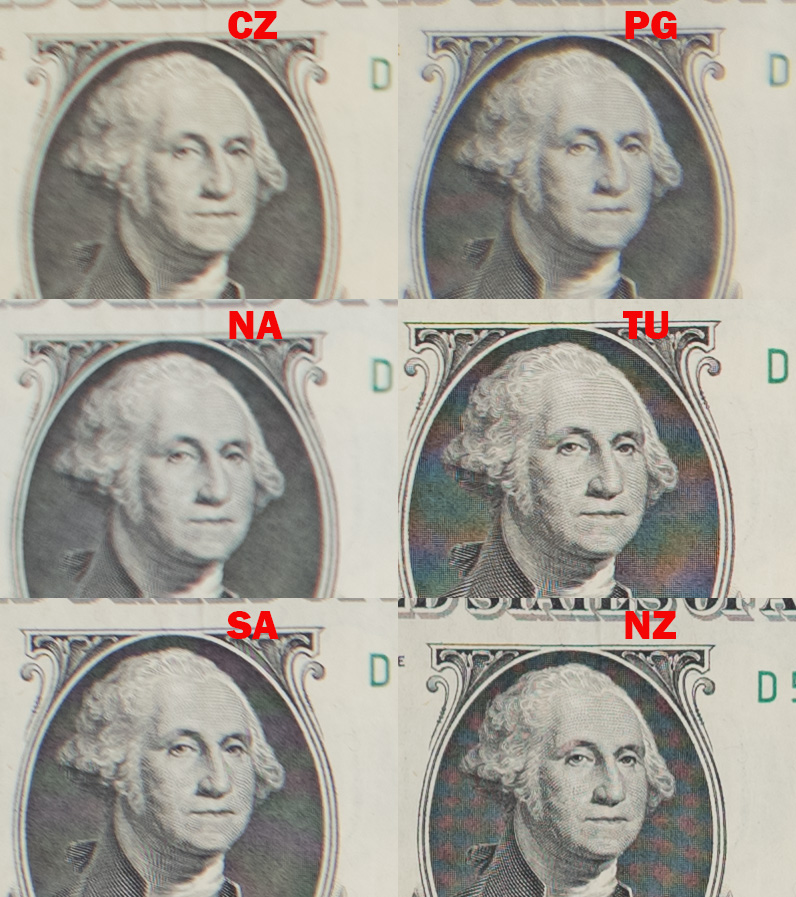
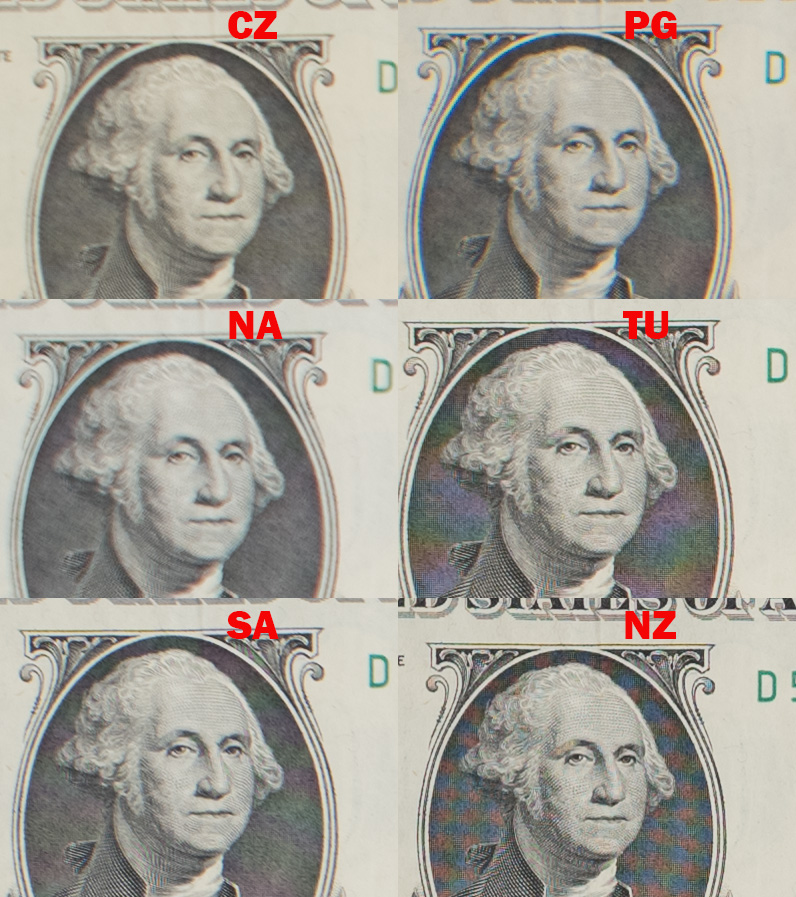
I focused once in the center and took all the pictures as opposed to my normal process where I focused on each point (center, inner center-periphery, and outer center-periphery). I noticed though that the Pergear lens showed an abnormal terrible result in the outer center-periphery, which indicated strong field curvature, then I took a new series of pictures with the Pergear lens only to be fair, where I separately focused on the outer center. When I rate the sharpness with e.g. excellent or good, there may be several that are good or excellent, in which case I mention them in the order from best to worst in that grade.
- Wide Open:
- Center: TU, NZ, and SA are excellent, CZ very good, PG good, and NA soft.
- Inner circle: TU and NZ are excellent, SA very good, CZ and PG good, and NA soft.
- Outer circle: NZ is excellent, TU very good, PG good, CZ and SA just OK, NA soft
- WO Ranking wide open: TU, NZ, SA, CZ, PG, NA
- F/2
- Center: TU, SA, NZ, and CZ are excellent, NA and PG are very good
- Inner: TU, NZ, SA excellent, SA very good, CZ, good, PG, NA just OK
- Outer: TU, NZ excellent, PG good, SA, CZ, NA OK
- F/2 Ranking: TU, NZ, SA, CZ, PG, NA
- F/2.8
- Center: TU, SA, NZ, NA, CZ, excellent, PG very good
- Inner: TU, NZ, SA excellent, CZ very good, NA and PG good
- Out: TU, NZ excellent SA very good, PG good, NA and CZ OK
- F/2.8 Ranking: TU, NZ, SA, NA, CS, PG
- F/4:
- Center: TU, SA, NZ, NA, CZ excellent, PG very good
- In: TU, NZ, SA excellent, NA, CZ very good, PG OK
- Out: NZ, TU excellent, SA, PG very good, NA, CZ OK
- F/4 ranking: TU, NZ, SA, NA, CZ, PG
Overall ranking for the portrait section: TU, NZ, SA, CZ, NA, PG
Points: CZ(4.5), PG(4), NZ(5), SA(5), TU(5), NA(4).

Sharpness (Close-up)
We look at the center of the image, wide open (f1.8 for NZ, f1.4 for others) and at every shared aperture.
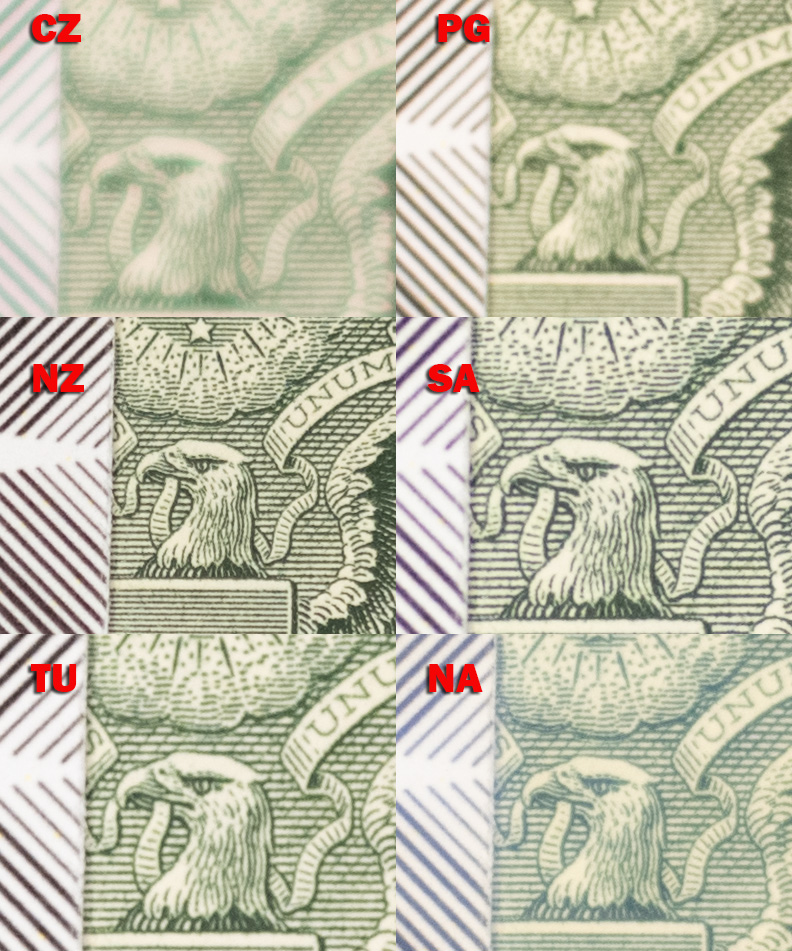
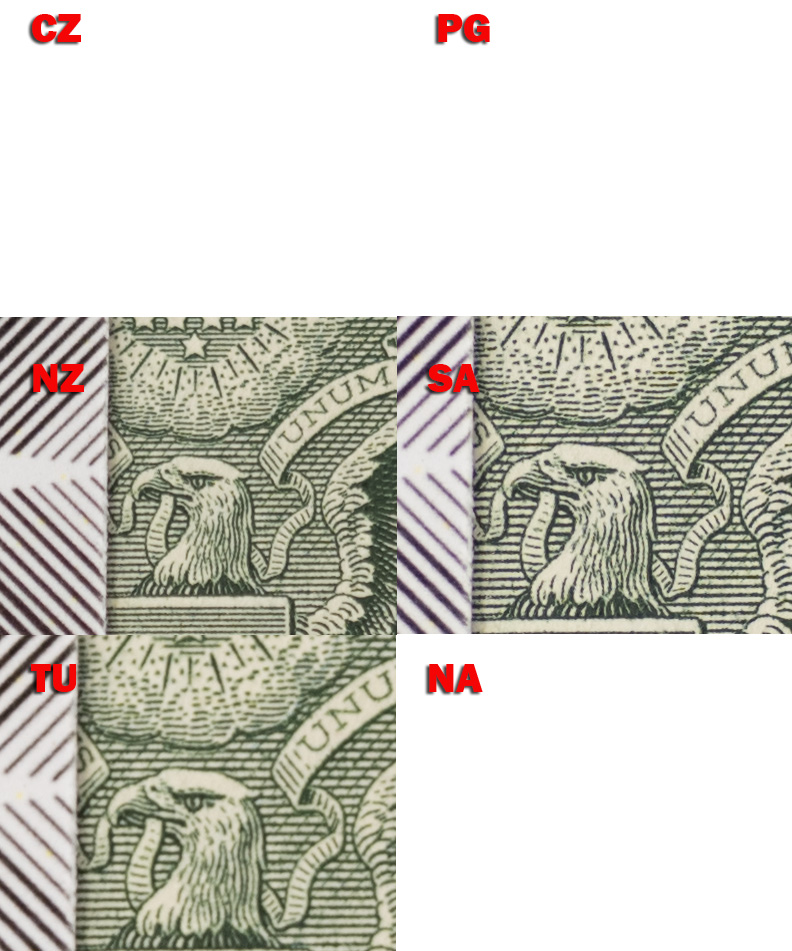
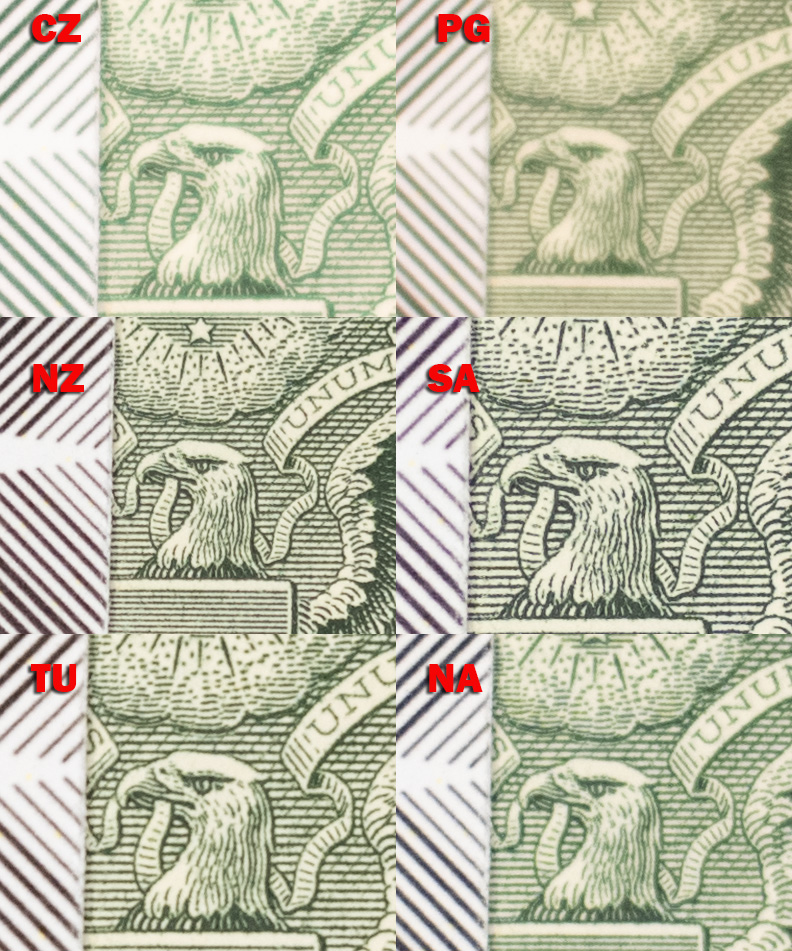
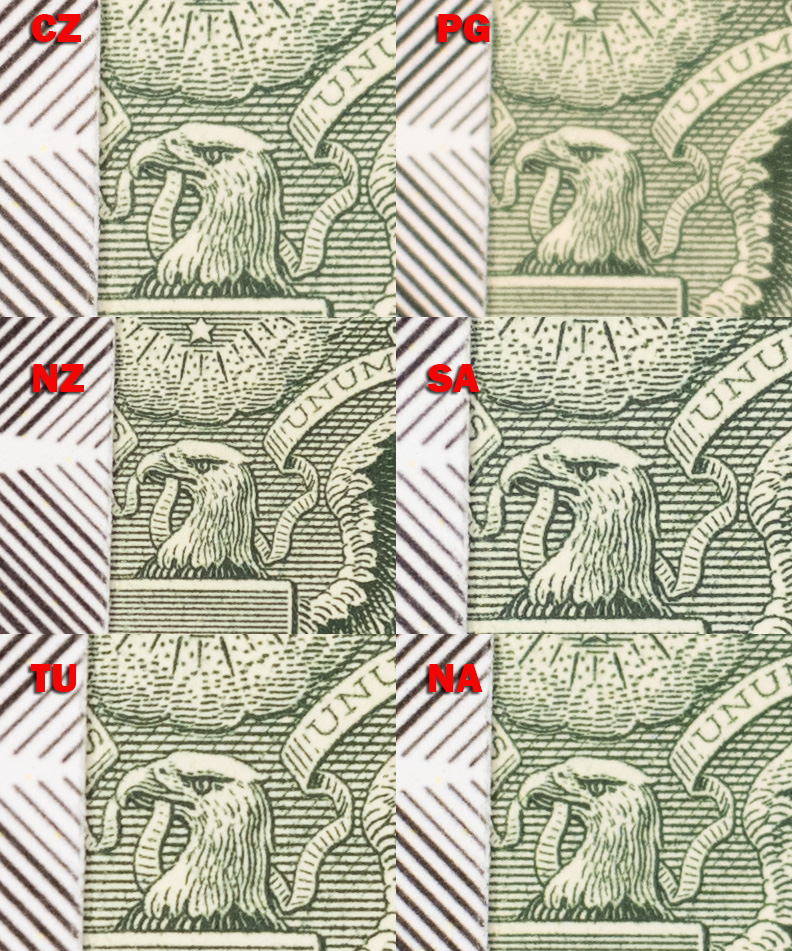
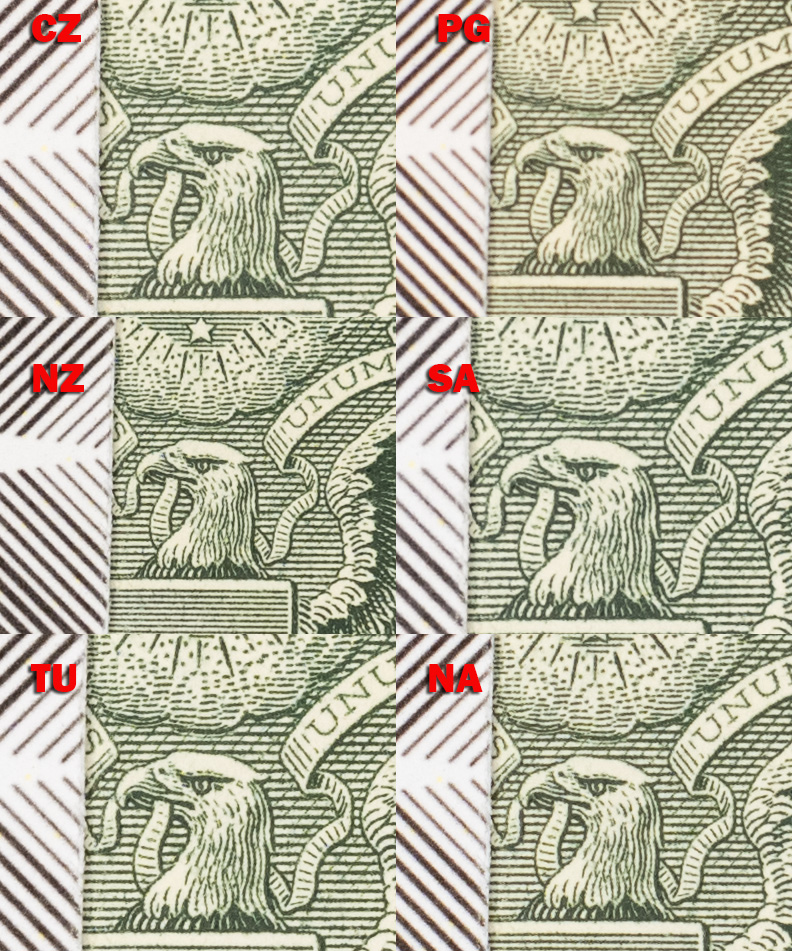
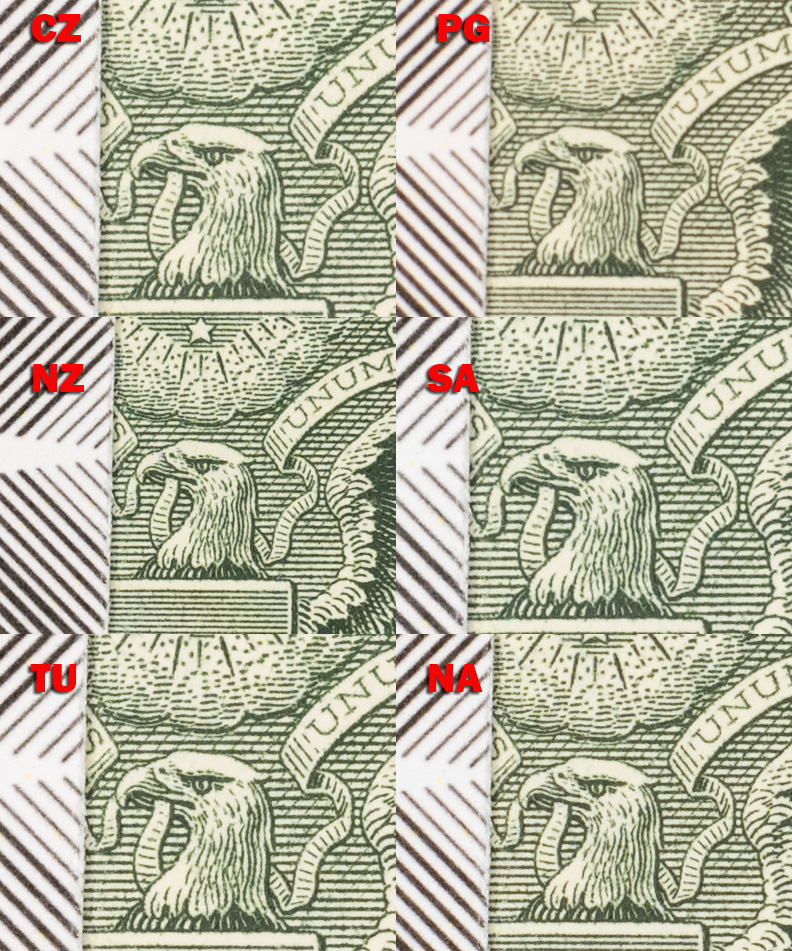
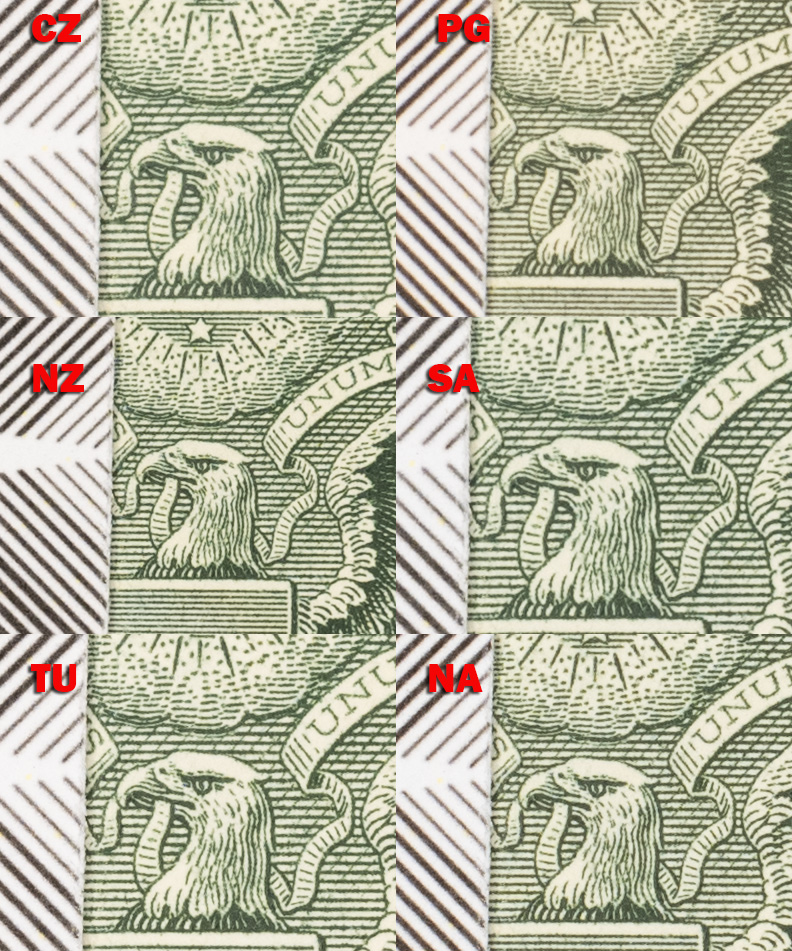
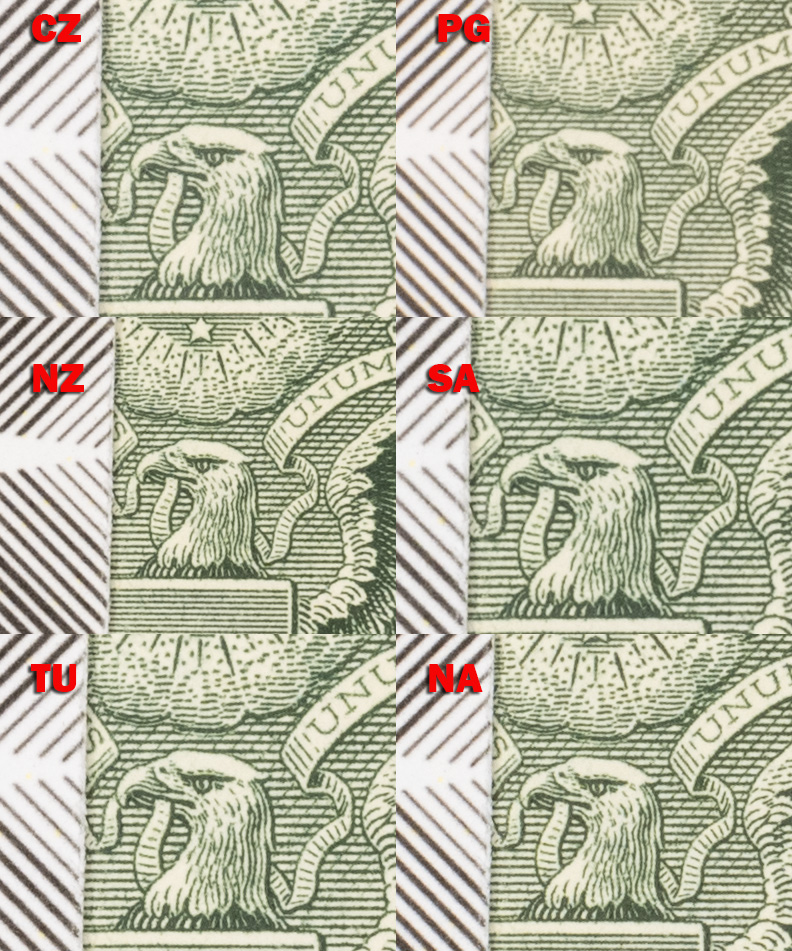
- Wide open (each lens at its widest aperture): NZ excellent, SA very good, TU & NA good, CZ & PG not OK.
Ranking: Nikon Z is the clear winner with excellent sharpness, followed by SA with very good sharpness, NA with good sharpness but weak contrast, TU with OK sharpness but good contrast, CZ, and at last place PG. - To be fair we look at f/1.8 too: NZ & SA excellent, TU very good.
SA made a dramatic improvement to excellent sharpness and takes the first place, followed by NZ, which still is at its widest aperture f1.8, and at last place TU, which has made a moderate improvement. - F/2: Same ranking for the first three places as f/1.8 followed by CZ, NA, and PG in that order. There is a clear gap between the first 2 (NZ and SA) and the rest.
- f/2.8: Overall improvement for all of the lenses. All lenses have excellent sharpness here, PG lacks contrast though
Ranking: Note that we are 2 stops from the widest aperture for all the lenses except for NZ, which puts NZ in a disadvantageous position. Even so, NZ takes the first place, closely followed by SA, which has a better contrast. CS makes a jump and takes the share third place together with TU. NA is closely after and PG is in the last place. - F/4: All lenses have excellent sharpness, while NZ is spectacular.
Ranking: NZ, which now is about 2 stops from its widest aperture, reaches new heights and takes the first place. Surprisingly the oldest lenses CZ and NA climb up the ladder and take a shared second place together with SA and TU. They are so close that it is unfair to put anyone in another place. PG takes the third place. - f/5.6: The competition is really hard here and all of the lenses have excellent sharpness, there are some shades of excellent though. Ranking: in this order: NZ, SA, NA, CS, TU, PG. The very big surprise here is that the oldest lenses (NA and CZ) have gone past the much more modern TU at this aperture, although just by a hair.
- F/8 the ranking is more or less the same
- F/11 diffraction comes in and affects all the lenses.
So, the overall winner in this section would be NZ, followed by SA in second place, and TU, which comes third.
Points: CZ(3.5), PG(3), NZ(5), SA(5), TU(4.5), NA(4).

Lens Distortion
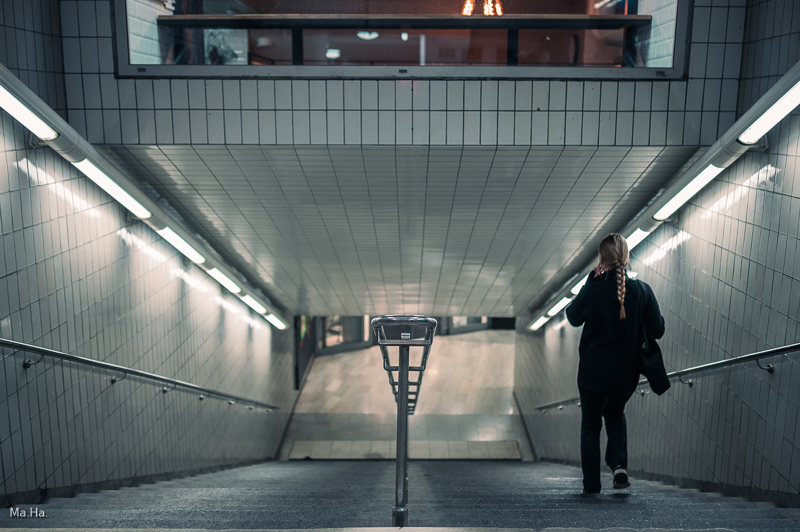
Here we have more than one surprise. The first one is that the oldest lenses fare among the best. CZ together with TU are perfect with no distortion at all. In second place comes NA, which has a negligible pincushion distortion, a +1 in LR/PS fixes that, if you want to, but it is not necessary. In the third place comes NZ, which also has a negligible pincushion distortion. Also here a -2 or -3 fixes it, if you want perfect lines along the edges. The second surprise is that SA has a huge barrel distortion that requires about +9 to correct. It is almost as bad as PG which also requires about +10 to get its barrel-distorted lines straight. So the ranking will be
Ranking: (TU – CZ), NA NZ, SA, PG
Points: CZ(5), PG(2), NZ(4.5), SA(2), TU(5), NA(5).
Vignetting
In this section, the clear winner is the Zeiss which performs best at almost all apertures and Pergear will take the last place. The others are more or less on par and between these two at each end. The difference between those other four is so small that you would not see it unless you take pictures of e.g. a white wall and compare them side by side.
If we want to rank them any way they would come in the order written:
- CZ
- SA, NA, NZ, TU
- PG
| f-number | CZ | PG | NA | TU | SA | NZ |
|---|---|---|---|---|---|---|
| f/1.4 | 1.7 | 2.9 | 2.3 | 2.3 | 2.3 | - |
| f/1.8 | - | - | - | - | - | 2.2 |
| f/2 | 1.4 | 2.7 | 1.8 | 1.8 | 1.7 | 1.8 |
| f/2.8 | 0,7 | 1.8 | 1.1 | 1.2 | 1 | 1.2 |
| f/4 | 0.6 | 1.2 | 0.7 | 1.1 | 0.7 | 0.7 |
| f/5.6 | 0.6 | 1 | 0.7 | 1 | 0.5 | 0.65 |
Points: CZ(5), PG(2), NZ(3), SA(3), TU(3), NA(3).
Focus Shift & Aberrations
Spherical Aberrations
CZ and NA suffer from focus shift, CZ a little more than NA.
Both lenses also suffer from spherical aberration but in reverse order; NA a little more than CZ.
Points: CZ(4), PG(5), NZ(5), SA(5), TU(5), NA(3.5).
Lateral Chromatic Aberrations
We tested the lateral chromatic aberration at f/8 for all lenses. In the following, you can see the 200% crop of one of the corners of the images. For each lens, I also included the corrected LaCA under the tabs “XX C” for easier visibility.
NZ shows the best control of LaCA, No LaCa at all, this is an exemplary performance.
Then SA and TU that seem to have about the same amount of LaCA but in different colors. SA purple bluish, TU pink purple. It seems that TU has less LaCA but as SA’s LaCA is more towards the blue and the background is also blue, it may be noticed less. Then comes PG, followed by CZ. Worst of all is the hideous LaCA of the NA.
Ranking: NZ, TU, SA, PG, CZ, NA
Points: CZ(2), PG(2), NZ(5), SA(4), TU(4), NA(1).
Longitudinal Chromatic Aberrations
For testing the longitudinal chromatic aberrations, I tested all lenses at their max relative aperture, and from there I took a picture at every full stop to determine the number of stops it requires to get rid of the LoCA.
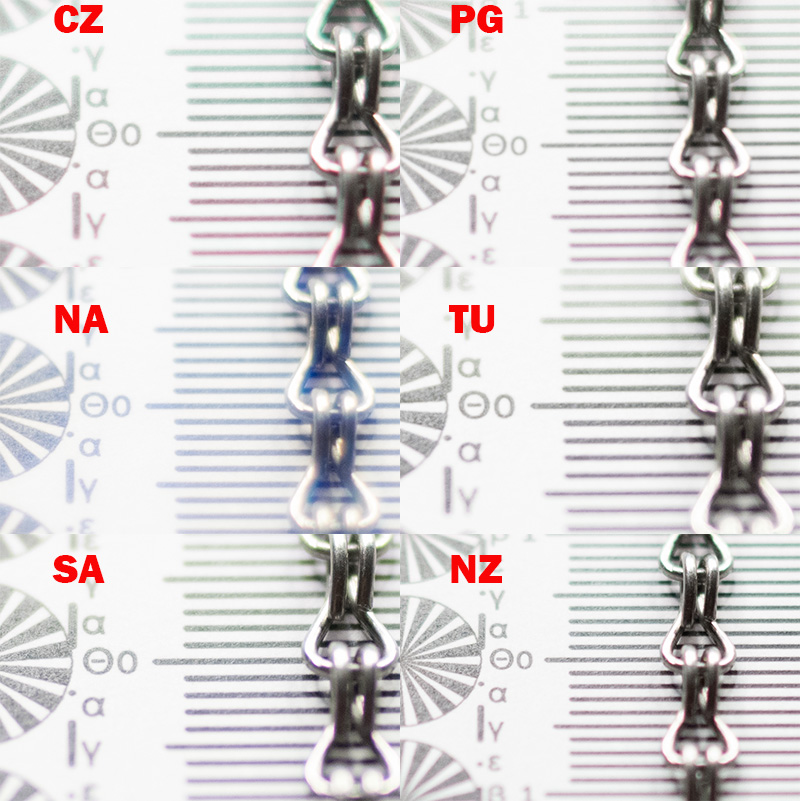
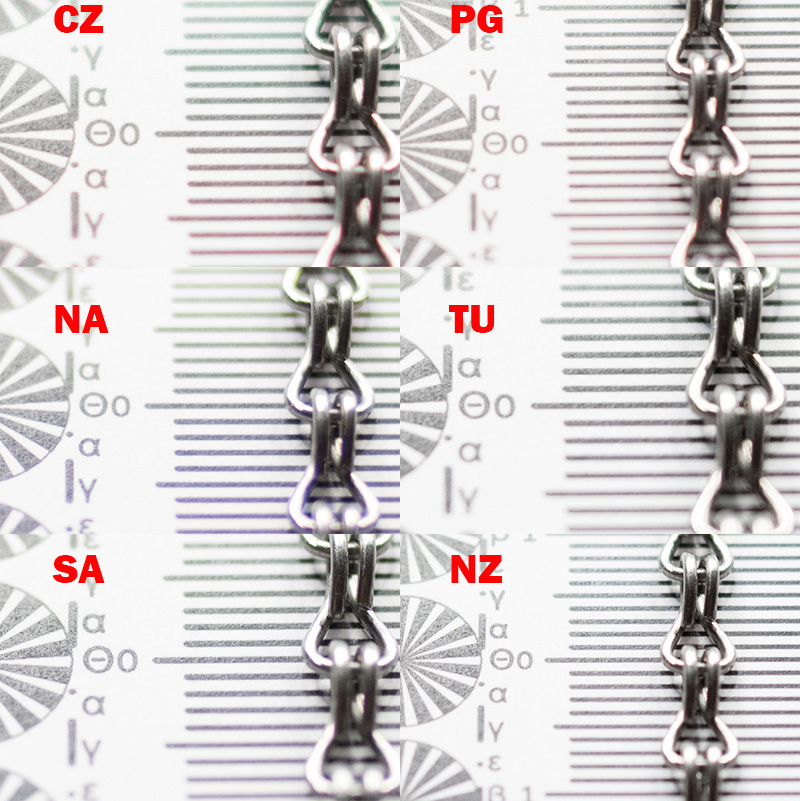
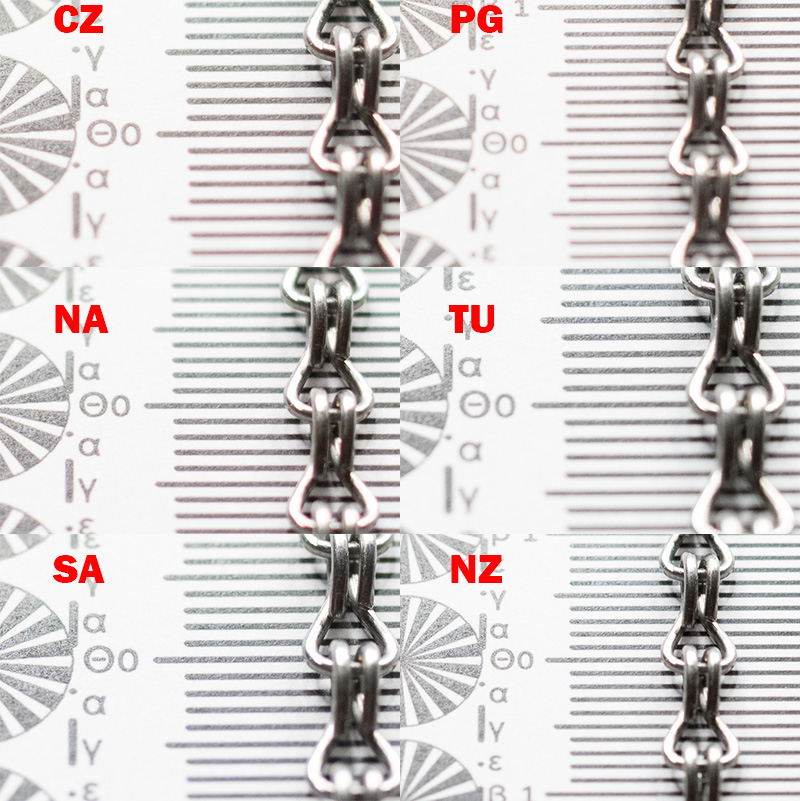
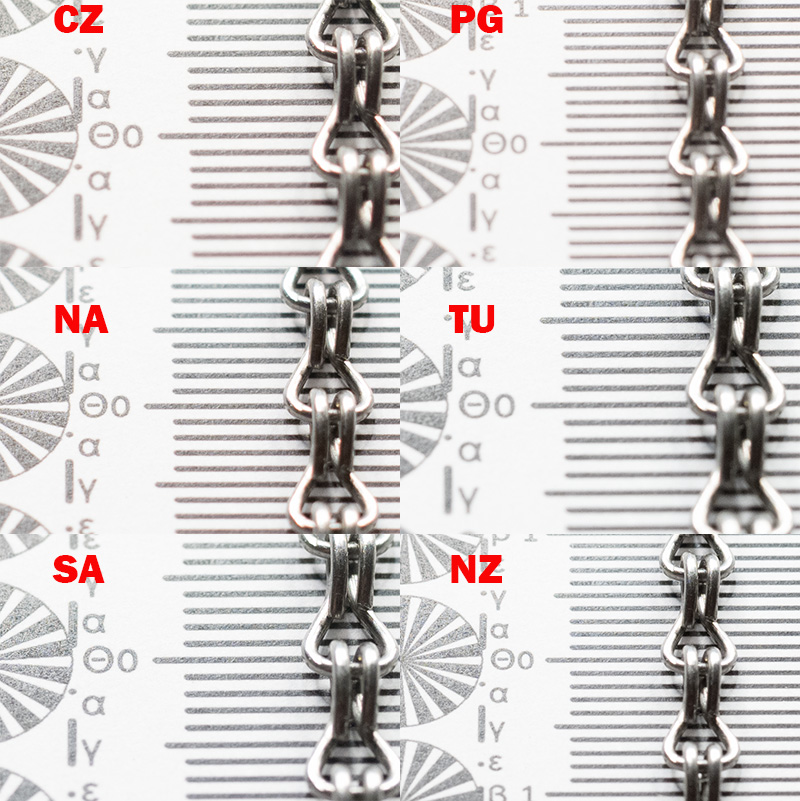
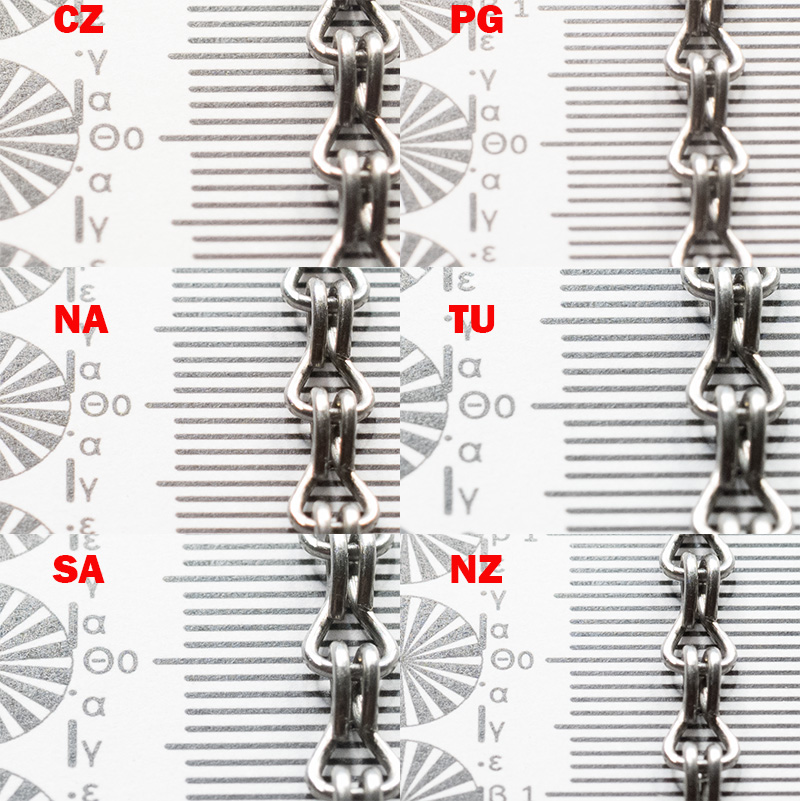
All of the tested lenses suffer from LoCA at their widest apertures. No ranking at max relative aperture as bad is bad and it looks like all of them are suffering as much as each other.
But if we stop down each lens just one stop, then interesting improvements happen. Now we can see clear differences, the ranking would be:
Ranking 1 stop: NZ, TU, SA, PG CZ, NA
By closing the aperture two stops some of the lenses have gotten rid of the LoCA completely
Ranking 2 stops: NZ, TU, SA, PG, CZ, NA
3 stops and almost all of them are free from LoCA except some small amounts in half of them.
Ranking 3 stops: NZ, TU, SA (without mutual ranking), PG, CZ, NA
4 stops improves the ones that were lagging with the same ranking as before
Overall ranking: NZ, TU, SA, PG, CZ, NA
Points: CZ(3), PG(3), NZ(4), SA(4), TU(4), NA(3).
Flare Resistance
I waited over two months to get the sun to test the flare resistance of these lenses, the sun came up a couple of times, each time, just a couple of hours. Those times either I was working, or I already was out (sometimes without the camera, sometimes with only one or two of the lenses), or it was in the middle of the day with the sun was higher than where it would be suitable for this kind of testing. At last, I decided to test during the night with some distinct powerful light.
In this section, you can make almost any lens look bad, if you try hard and long. I tried to show the worst sides of these lenses when it comes to flare resistance. Here they are:
From this section’s battle, two contenders emerged as victors and could hold their heads high, as they managed to control the flares in a praiseworthy manner. They are the NZ and TU. The NZ is just a tad better but this is nothing you would notice in normal usage as this can be seen only in extreme cases, in most cases you would not see any shortcomings from any of these two lenses. The CZ was surprisingly good for being so old, and the NA was not that bad. The big shock here was that the SA showed an unexpectedly weak performance, it takes the fifth place, while the PG showed the weakest resistance and came last.
Points: CZ(4), PG(1), NZ(5), SA(2), TU(5), NA(2).

Coma
For coma, we tested all lenses at their max relative aperture, then at every full stop up to f/5.6.
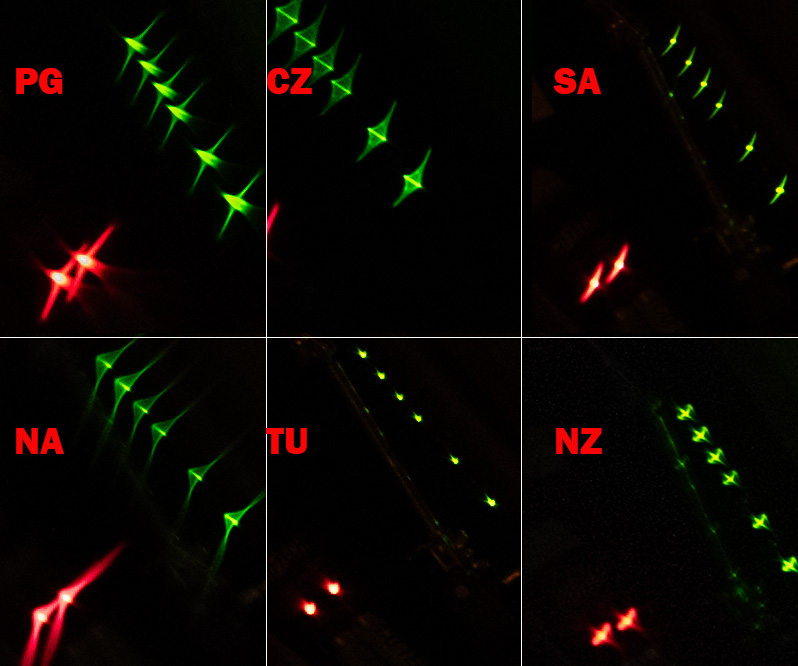
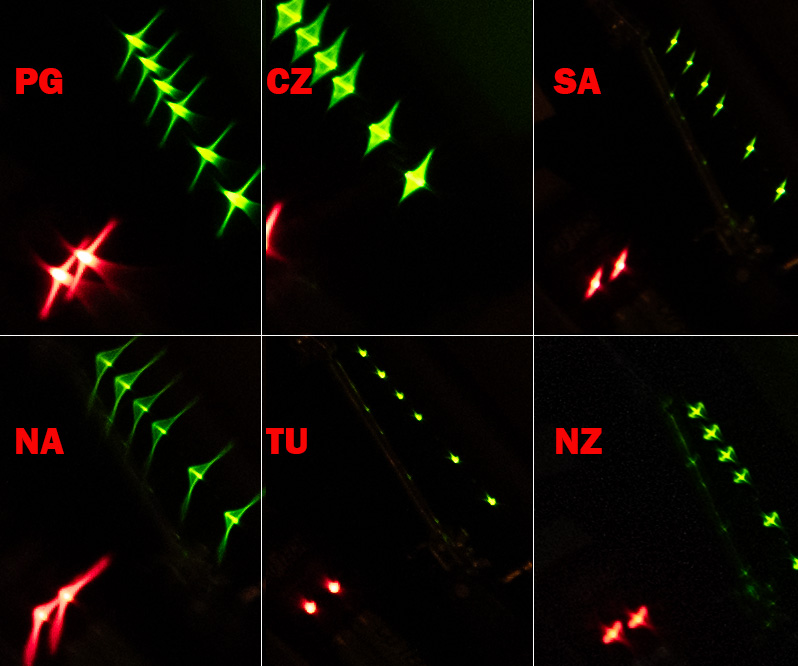
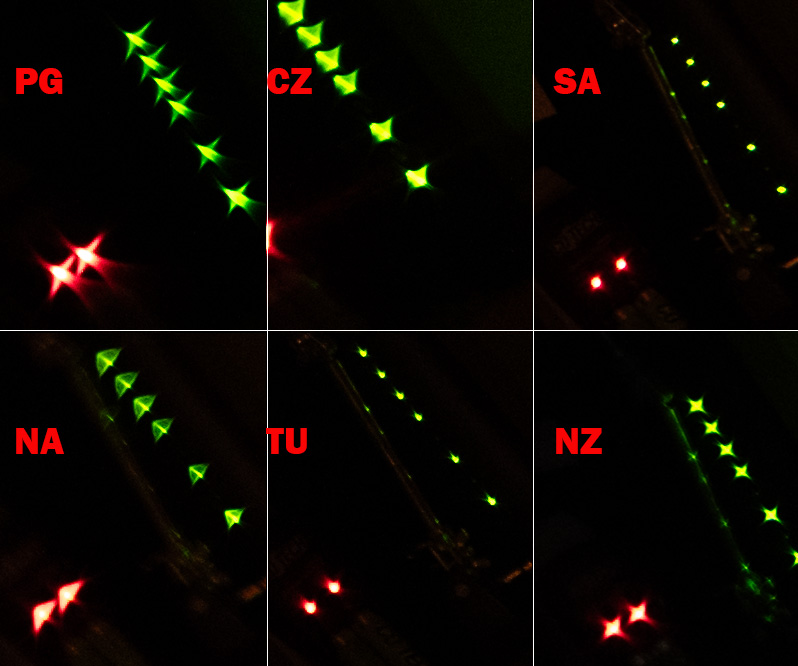
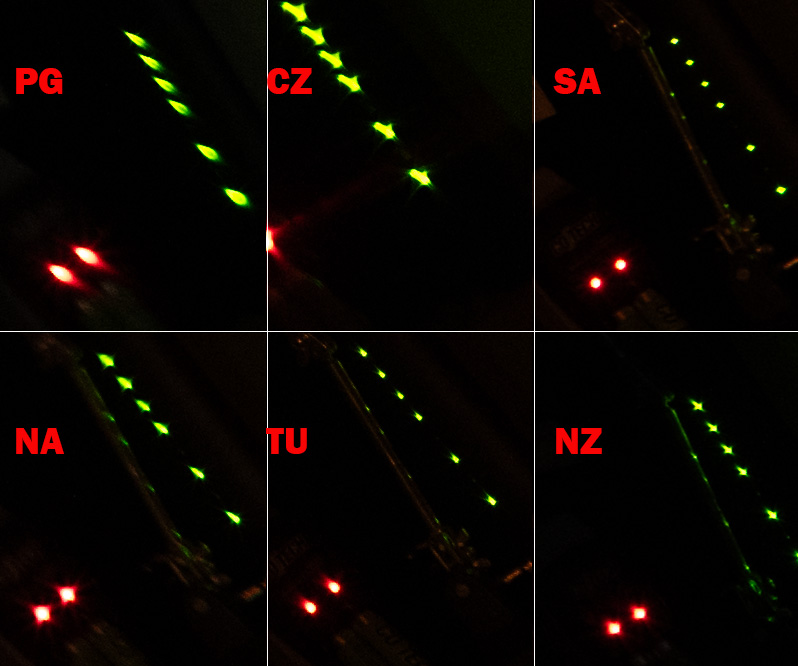
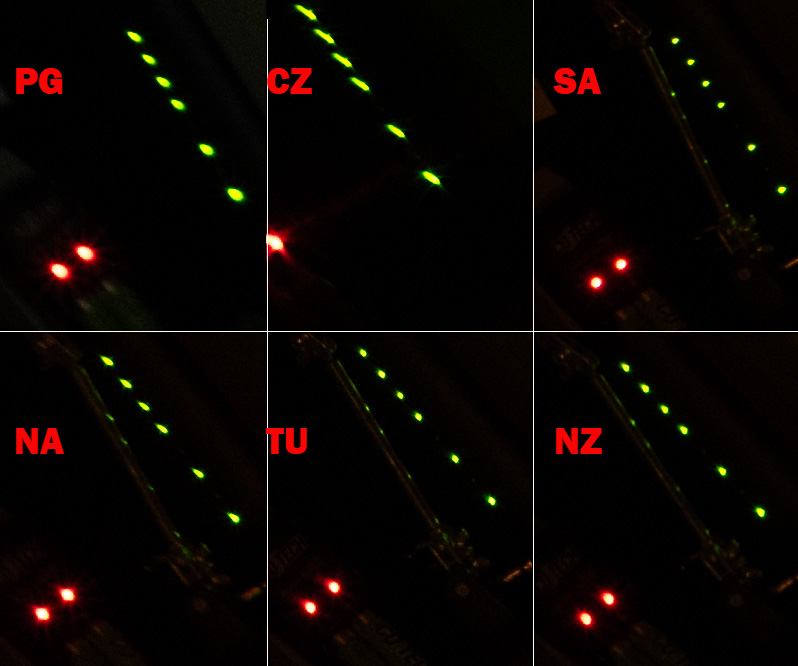
In this section we don’t need to analyze images in detail, the result is easily visible. TU is to be praised for its outstanding coma control. NZ did not come last but a disappointment for such a modern and expensive lens to fare so badly compared to older contestants.
Ranking: TU, SA, NZ, NA, PG, CZ
Points: CZ(1), PG(1), NZ(3.5), SA(4), TU(5), NA(2).
Sunstars
I took all the pictures (almost) at the same time from the same spot.
TU, SA, NZ, and NA all have 9 rounded aperture blades, which if well aligned should be able to produce 18 pointed stars at least at some f/stops. In the cases of these lenses all showed to be capable of producing 18 pointed stars from f/4 and some of them even at f/2.8. To get nice and distinct stars you should stop down to at least f/5.6 though. Pergear has 10 aperture blades and hence 10 pointed stars, which are some people’s favorite sunstars, but it has rounded blades and they are not very well aligned therefore the stars are not well defined. The Zeiss has only 3 blades, and cannot produce any beautiful sunstars at all.

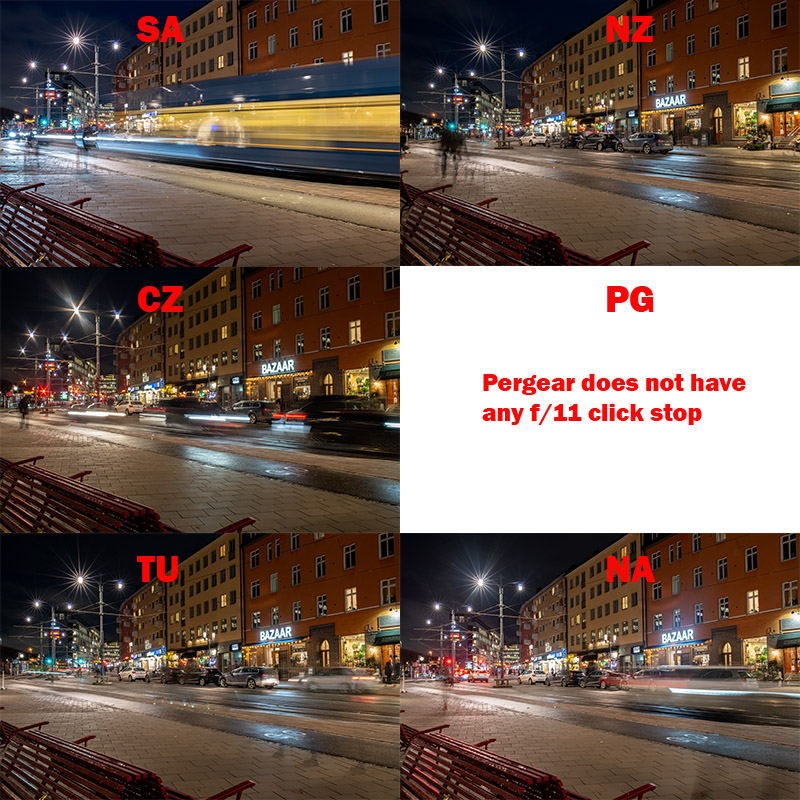
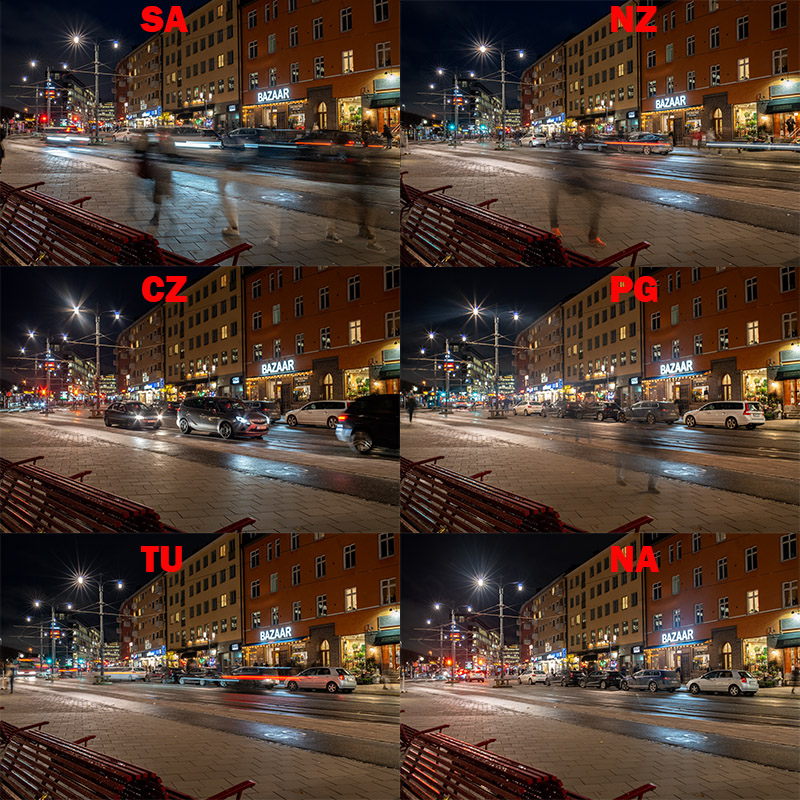
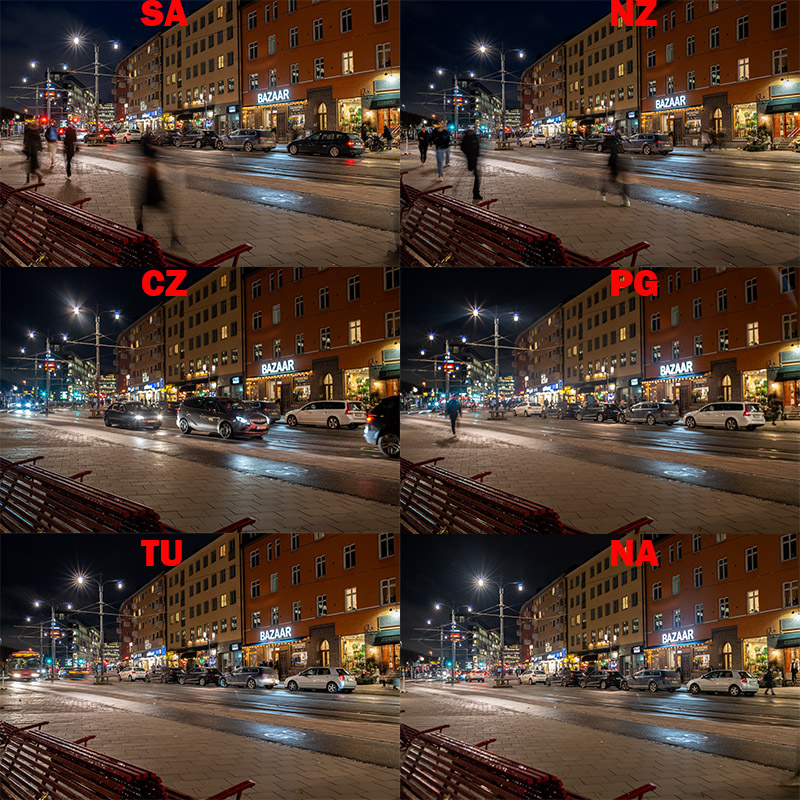
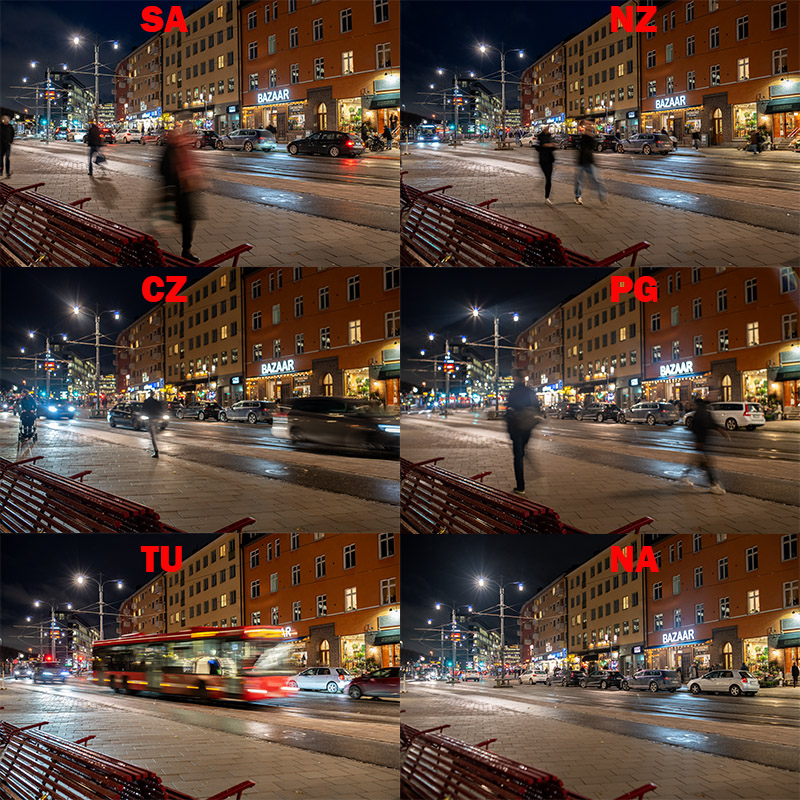
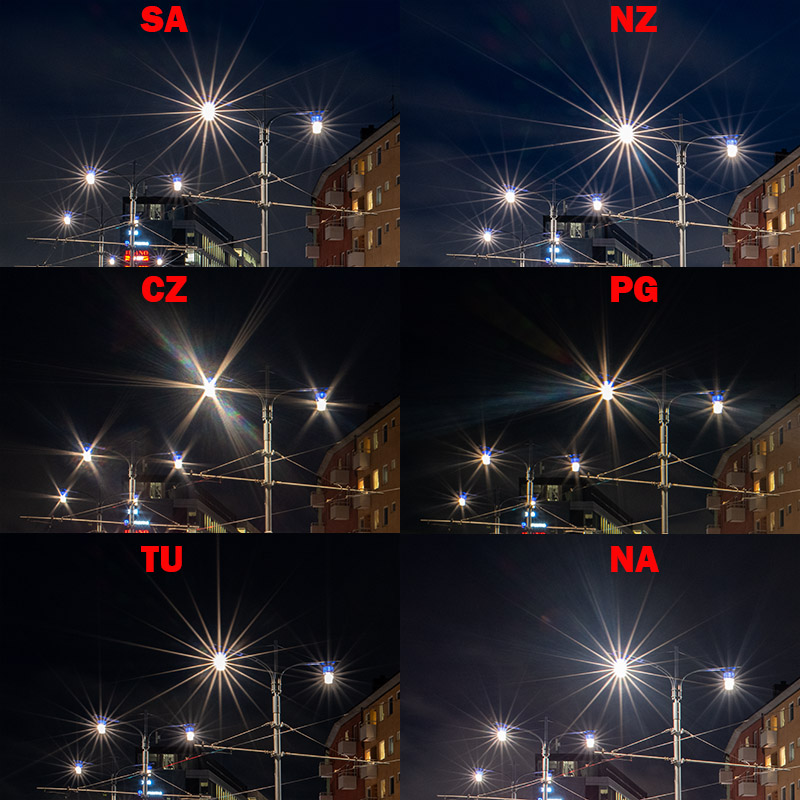
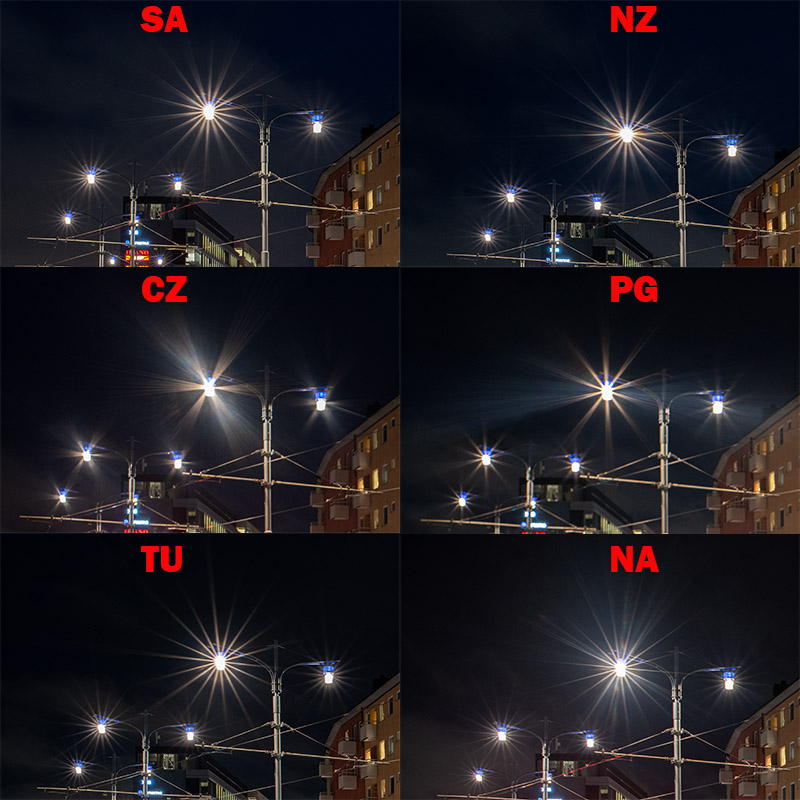
As sunstars’ beauty is a subjective matter I don’t rate them but I can tell, which ones I like best and why. I then make a ranking based on my liking, you are very welcome to have your opinion and like them differently.
NZ produces the longest rays and they are very well-defined, so I like that best. TU and SA both produce similar stars but the rays are shorter, TU’s rays are a little more well defined but they are very uneven, while SA has more uniform rays. So I like SA second best and then TU. NA can also produce very long rays that look distinct but there is a lot of light leak around the rays, which draws the overall quality down under the other three. After them, I like Pergear’s sunstars. CZ, I don’t it like it at all. I rank the sunstars in the following order:
Ranking: NZ, SA, TU, NA, PG, CZ.
Points: CZ(1), PG(2), NZ(5), SA(5), TU(4), NA(3).
Focus Breathing
In this category, NZ wins easily. TU takes the second place and NA the third. NZ shows zero focus breathing, while TU and NA almost zero. SA comes fourth but its focus breathing is not so bad. The last two places, CZ fifth and last PG, show a very strong focus breathing.
Ranking: NZ, TU, NA, SA, CZ, PG
Points: CZ(1), PG(1), NZ(5), SA(3), TU(4), NA(4).
Bokeh
Before we look closer at the bokeh quality/beauty, mind that we test it at the widest aperture most of the time, and as the Nikon Z has a smaller max relative aperture than those of all the other lenses, it will be a bit unfair as it is in a disadvantageous position. Nevertheless, if we want the softest bokeh, we use the widest available aperture on the lens and that is what each lens offers, so the Nikon Z has to accept that.
WO: Surprisingly the PG has the nicest bokeh balls but not the largest. The bokeh balls are evenly lit with no outlining or colored edges without any onion rings. Judging by the looks of the bokeh balls you can expect a nice bokeh from this lens. The only other lens that is free from onion rings is NA but it has colored outlining that can make some trouble. NZ and SA have about the same amount of onion rings but SA has larger bokeh balls, TU has the largest bokeh balls but the onion rings are more visible. The worst bokeh balls belong to the CZ.
Stopped down to f/2.8 PG still looks best in the center, NA has got rid of its colored outlining but now it shows very sharp corners of the polygon shape, SA NZ, and TU come after PG and CZ with its triangular bokeh balls looks worse. In the corner though stopped down to f/2.8, CZ looks best, then PG, after that NZ as it has less defined corners but about the same onion ring patterns, then TU and SA, and last NA, although NA does not have any onion rings or pattern inside the balls and that is nice.
Close Distance
MFD (≈0.3 m) indoors
At near MFD all of the lenses render a very soft background blur. The effect of the small difference in the FoV is obvious though, those with narrower FoV have more background compression and softer bokeh, the softest bokeh renderings belong to TU, SA, CZ (equally soft), then PG and NA, NZ comes last as it has the smallest aperture and widest FoV.
Near MFD (≈0.5 m) indoors
Let’s take a shot of something just a little further away, at about 50 cm!
Still, all the lenses produce soft bokeh, the NA has a little harsher transitions and that is certainly related to the outlining it showed in the bokeh balls, which in turn was an effect of high LoCA. The effect of the FoV is smaller now as the subject is just a little further away, but still vaguely visible. The softness of the bokeh is very close to each other (except NA) but the ranking order is the same as before.
Medium Distance, Indoors
Now let’s take a shot at the portrait distance, about 1 m away.
Here the effect of the small change of FoV can affect on our judgment, therefore I normalized the test shots to the same framing so that it would be easier to see the difference.
More or less, the same ranking anyway, but with a tiny little difference between the first three, TU, SA, CZ, NZ, PG, NA.
Medium Distance (1 m) Outdoors
Long Distance (2 m) Outdoors
The images are small here and therefore it might be difficult to see how the out-of-focus blur actually is. Therefore, let’s also look at a crop of the upper left corner of these images.
Medium Distance 1.1 m
Long Distance 2.1 m
Long Distance 3.5 m
All in all, I find the bokeh of TU the most pleasant, NZ coming next, followed by SA, as first, second, and third. Then CZ, PG, NA.
Points: CZ(3), PG(3), NZ(4.5), SA(4), TU(5), NA(3).
Color Rendition
Some people like to see if the different lenses render colors differently. Well, they can do that. Let’s have a look at the colors that these lenses produce.
Test 1
Here are images as they came out from the camera in raw format, to PS for normalizing the framing and saved as Jpeg. Before taking the shots, I used the neutral gray card that is behind the coloring pencil set and one of the lenses to calibrate the white balance (manual preset). I manually set the neutral gray temp for the light I was using and photographed all the shots.
Some people like more saturated colors and others more muted ones. As mentioned, some lenses render the colors in a way that some people like it more. But after all, a lens should render the colors as close to reality as possible. Then you can change the temp and tint to your liking afterwards. If we want to rate the color rendering, we look at how close they are to what we had set them to. Here is the difference between the set colors and the rendered colors:
| Lens | CZ | PG | NZ | SA | Tu | NA |
|---|---|---|---|---|---|---|
| Temp | 200 | 300 | 50 | 50 | 150 | 0 |
| Tint | −6 | −10 | −2 | −2 | −4 | −1 |
Nearest to the calibrated lens colors, which should be the true colors, belongs to NA. Then NZ and SA in a shared second place, followed by TU in third place, then CZ, and last PG. Can you guess which lens I used to calibrate the neutral gray? Right, it was the NA. This showed how much off, the others were from the calibrated lens, which should have the correct colors.
It does not show though, which one has the colors nearest to reality.
Test 2
Let’s do another test, we take a shot with the same light source (a speedlight this time) with all the lenses. We set the camera to auto white balance. We also put the reference gray card in the image. The result will be as follows:
Although I had set the WB to auto, there are some visible differences in the colors. Now we use LR’s white balance eyedropper on the gray card, behind the fruits, on every image. The result will be as follows:
Now all of the images have almost the same colors, and it is very difficult (if not impossible) to see any differences. The colors should also be the real colors as the neutral gray should be neutral gray in this set of pictures. I checked the temp and tint before and after using the eyedropper to see how much off, each one was. This is the result:
| Lens | CZ | PG | NZ | SA | TU | NA |
| Temp | −850 | −800 | −250 | −300 | −250 | −1650 |
| Tint | 13 | 5 | 14 | 12 | 10 | 22 |
If we ignore the NA that in the first round was used to calibrate the colors, in this round TU, NZ, and SA came in the three first places with very small differences between them. Then PG, followed by CZ, and now worst of all is the NA.
Ranking: TU, NZ, SA, PG, CZ, NA
Points: CZ(4), PG(4), NZ(5), SA(5), TU(5), NA(3).
Adapters
Before jumping to the Conclusion, it is in place to briefly mention the adapters used in this review.
Nikon FTZ
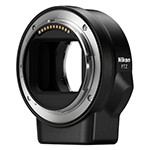 We tested Tamron 35/1.4 USD (Nikon F-mount) with this adapter. This is Nikon’s own AF adapter for using Nikon’s older F-mount lenses on Nikon Z cameras. AF works only with AF-S Type G, E, and D; AF-P Type G and E; AF-I Type D. With all the other/older types of Nikon F, you have to use manual focusing. It worked satisfactorily in all tested situations but was not quite as fast as a native Nikon Z 35/1.8. This would be difficult to judge though if I did not have both lenses side by side. The focal length used for IBIS and the working aperture are registered correctly, while the file name was registered as “35mm f/1.4E”, Although the focal length and max aperture of the lens name are correct, the name itself is hardly right)
We tested Tamron 35/1.4 USD (Nikon F-mount) with this adapter. This is Nikon’s own AF adapter for using Nikon’s older F-mount lenses on Nikon Z cameras. AF works only with AF-S Type G, E, and D; AF-P Type G and E; AF-I Type D. With all the other/older types of Nikon F, you have to use manual focusing. It worked satisfactorily in all tested situations but was not quite as fast as a native Nikon Z 35/1.8. This would be difficult to judge though if I did not have both lenses side by side. The focal length used for IBIS and the working aperture are registered correctly, while the file name was registered as “35mm f/1.4E”, Although the focal length and max aperture of the lens name are correct, the name itself is hardly right)
Buy new: amazon.com, amazon.de, amazon.co.uk, for $ (Affiliate links)
Buy it from: ebay.com, ebay.de, ebay.co.uk $120-$160 (Affiliate link)
Viltrox EF-Z
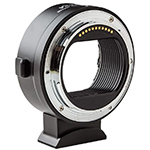 For the Sigma 35/1.4 HSM Art (Canon EF mount) we used this adapter. It is only fair to compare it with Nikon’s FTZ adapter, as in both cases a third-party lens was attached via the adapters to the Nikon cameras. AF speed and hit rate were on par with the Nikon FTZ in most cases, but not quite in all of them. When Pin-point AF was used, the Viltrox did a lot more chasing and missed nailing focus in many cases, especially when the subject was positioned in the corner of the frame. Chasing and occasional miss focus were also the case with this adapter in other modes when the subject was in the corners, but to a much lesser extent than in Pin-point focus mode.
For the Sigma 35/1.4 HSM Art (Canon EF mount) we used this adapter. It is only fair to compare it with Nikon’s FTZ adapter, as in both cases a third-party lens was attached via the adapters to the Nikon cameras. AF speed and hit rate were on par with the Nikon FTZ in most cases, but not quite in all of them. When Pin-point AF was used, the Viltrox did a lot more chasing and missed nailing focus in many cases, especially when the subject was positioned in the corner of the frame. Chasing and occasional miss focus were also the case with this adapter in other modes when the subject was in the corners, but to a much lesser extent than in Pin-point focus mode.
Otherwise, Single-point AF, Wide-area (S/L), Wide-area (people), AF-S, and AF-C for continuous AF, and even Video AAF (All-time AF) were working more or less like Nikon’s FTZ. The focal length used for IBIS and the working aperture are registered correctly with this adapter too, while the lens name was registered as “NIKKOR Z 24-70 f/4 S”, here nothing is right, not the name, not the focal length and not the max aperture in the name. A smaller issue with no impact on the functionality though. (The adapter has the same issue with Canon’s original lenses)
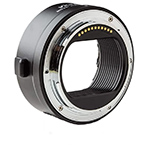 A nice feature with the Viltrox is that you can detach the tripod hump with an included Allen key and save some space and also ease of use, as you can attach/detach it from the camera even if the camera is mounted on a tripod, something you cannot do otherwise, an annoying detail even with Nikon’s FTZ.
A nice feature with the Viltrox is that you can detach the tripod hump with an included Allen key and save some space and also ease of use, as you can attach/detach it from the camera even if the camera is mounted on a tripod, something you cannot do otherwise, an annoying detail even with Nikon’s FTZ.
Buy it from Viltrox Store (Affiliate link)
K&F Concept QBM-Z
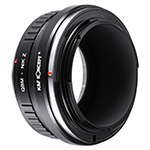 For testing Carl Zeiss Distagon 35/1.4 HFT we used this adapter. This is a dumb mount adapter with no contacts. No data is transmitted with this adapter, K&F makes all kinds of adapters of this type, almost from every possible lens mount to every possible camera body mount. It worked as expected without any remarks.
For testing Carl Zeiss Distagon 35/1.4 HFT we used this adapter. This is a dumb mount adapter with no contacts. No data is transmitted with this adapter, K&F makes all kinds of adapters of this type, almost from every possible lens mount to every possible camera body mount. It worked as expected without any remarks.
Buy it from: amazon.com, amazon.de, amazon.co.uk, (Affiliate link)
ebay.com, ebay.de, ebay.co.uk
Megadap ETZ-21 Pro
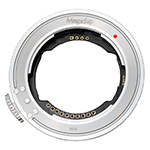 We tested the Pergear 35/1.4 with this adapter. The Pergear is a completely manual lens without any electric contacts, so this adapter was used just to mount the lens on the camera without any other electric connections for data transmission. I could just as well use a dumb adapter from K&F for a much lower cost, but I had this one in my hands. No remarks.
We tested the Pergear 35/1.4 with this adapter. The Pergear is a completely manual lens without any electric contacts, so this adapter was used just to mount the lens on the camera without any other electric connections for data transmission. I could just as well use a dumb adapter from K&F for a much lower cost, but I had this one in my hands. No remarks.
Buy it from: amazon.com, amazon.de, amazon.co.uk for $249 (Affiliate links)
Buy at eBay: ebay.com, ebay.de, ebay.co.uk (Affiliate links)

Conclusion
First of all, please keep in mind that it is above all a comparison. The lens that comes in the last place does not necessarily need to be bad, it is just not as good as the others. The better ones need only to be just a little better to come higher up on the medal stool. Also, there is no perfect lens, some are stronger in some categories and others in other categories. You should have it clear what is important for you.
Looking at these six lenses and their optical strengths, two winners come up over the others and they are the Nikkor Z 35/1.8 S and the Tamron 35/1.4 USD. They are almost in all categories better than the others. The differences between these two are minimal, in some categories the Nikkor is better just a little, and in others the Tamron. Of course, if you need a lens at f/1.4 the Tamron wins by knockout, as the Nikkor’s max relative aperture is f/1.8. But the best lens on a mirrorless is the Nikkor Z and the best lens on a DSLR is the Tamron.
The Sigma was a little bit of a shock as I had very high thoughts about it being from Sigma’s Art series. Although it is a very good and capable lens, in some categories it showed signs of its age and could not come up to the same level as the best ones in this list. It has a small size and weight advantage over the Tamron. If that feature is highest on your priority list, go for it, but I would go for the Tamron if I had a DSLR as they are sold for almost the same price.
The two vintage lenses were also very capable lenses and if you are into manual focusing or vintage rendering, they are very good lenses. How fantastic those lenses may be, to think that they can come up to the level of modern lenses is a little naive. In some categories, they were better the modern lenses. The Nikkor Ai-s sample I had, was in very poor condition, it had a lot of stains inside the barrel, balsam separation, some visible but mild scratches on both front and rear lens elements, and the barrel had loads of dents, and signs of both wear and repair. So, its result may or may not be fair for that lens in general. Anyhow the Zeiss lens showed better optical results in general, except for sunstars, coma, and focus breathing. Maybe if I had a Nikon Ai-s in a better shape it could beat the Zeiss in some more categories. Also don’t forget the very specific triangular bokeh balls of the Zeiss, if you like it, that is a rare feature that you cannot find with many lenses, if you don’t like it, just avoid it.
Pergear: Incredibly compact and light, just enough sharpness for any application, metal build quality, and it’s only $129. Minus points: confusing aperture, softer than the others, high vignetting, huge barrel distortion, mediocre sunstars, coma. Do not dismiss this lens just because it has come last in this comparison, it is capable of delivering great pictures. Our reviewer Bastian has won prizes in international photography competitions for a picture he has taken using this lens.
Just for fun sake, I gathered the ratings in two categories; optical and practical, and for each category made a sum up of the lenses’ first places (Gold medal), second places (silver medal), and third places (bronze medal).
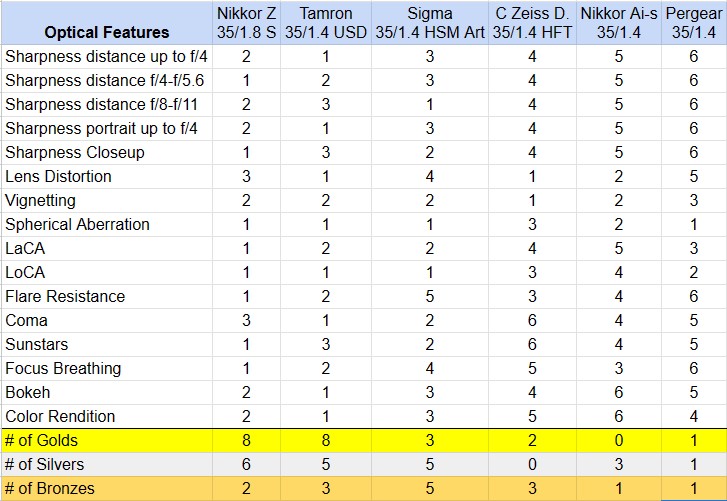
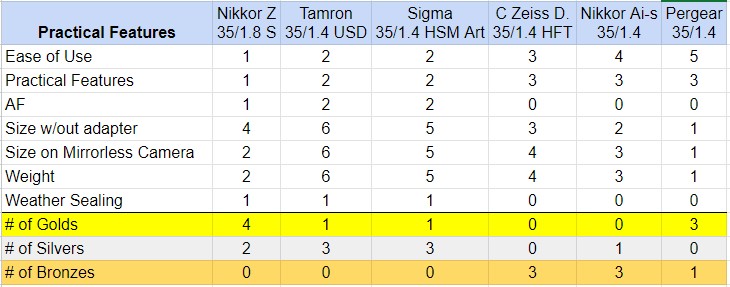
Well, this only shows the ranking among these six lenses, not how bad or good the lenses are. Bastian thought it would show the ones at the bottom of the list worse than what they actually are. So, I also introduced a points rating, as I normally do when I review single lenses; Bad (1), OK/Mediocre (2), Good (3), Very Good (4), and Excellent (5). Here is the result for the optical characteristics of the lenses according to points rating. Note that the maximum possible points that a lens can get in this system is 80.
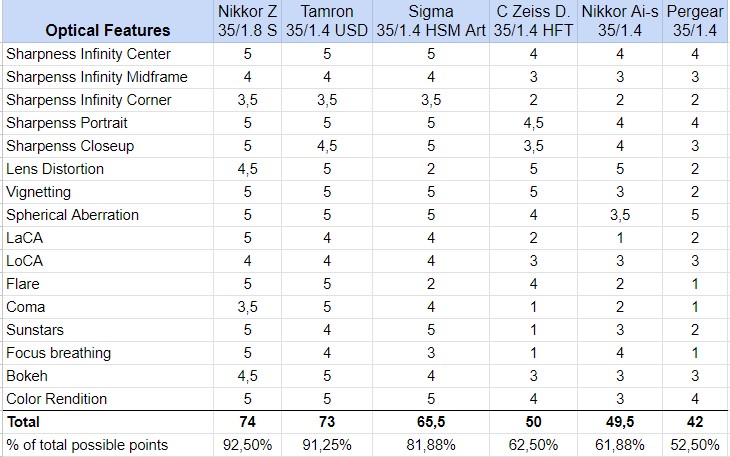
If we want to roughly rate the lenses according to the same criteria as in the individual categories (1-5), the three first lenses (Nikkor Z, Tamron, and Sigma) will be rated excellent, Zeiss and Nikkor Ai-s will be rated very good, and the Pergear will be rated as good.

If you are interested in buying this lens or any of the lenses in the Alternatives section, you can support our efforts by using the links below or given under each lens. It won’t cost you a penny and it won’t affect the price, but it will help us a little.
Writing articles like this one is both time-consuming and costs us a lot of money. If you found this article helpful and decided to buy one of these lenses, please consider using one of the affiliate links.
If you are not interested in buying any of the lenses, but you still found this article useful, interesting, or it saved you a lot of money, treat us to a coffee!
Alternatives
Nikon AF-S 35mm f/1.8G ED
The predecessor of the Nikon Z 35/1.8 in Nikon F mount, you need an FTZ adapter to use on Nikon Z cameras. It performs very well, but not in the same league as Nikon Z 35/1.8. Wide open sharpness in the center is comparable but in the corners or stopped down in the center, the Z version is far sharper. It is less expensive though at about $530 new.
Buy new: amazoncom, amazon.de, amazon.co.uk, amazon.fr, amazon.com.au $520 (Affiliate links)
Buy used: ebay.com, ebay.de, ebay.co.uk, ebay.fr, ebay.com.au ≈$250-$350 (Affiliate links)
Viltrox 35mm f/1.8 Z-mount
The Viltrox is also autofocus and available in native Z mount. Not as sharp as the Nikkor Z 35/1.8 and has no weather sealing, nor the fancy coatings of the Nikkor lens but it is half the price. If you’d like to have a native mount lens with similar features and handling to the Nikon Z lenses but are on a budget, this is the lens for you.
Buy new: Viltrox online store and get a discount with coupon code MARTINMH or
Buy new: amazon.com, amazon.de, amazon.co.uk, amazon.fr, amazon.com.au for $380 (Affiliate links)
Buy used: ebay.com, ebay.de, ebay.co.uk, ebay.fr, ebay.com.au ≈$320 (Affiliate links)
Voigtlander APO-LANTHAR 35mm f/2 Aspherical
This lens is available in Nikon Z mount, manual focus, it has better LoCA control but is beaten by Nikkor Z 35/1.8 in all the other categories. This Voigtländer is 1/3 stop slower but even more expensive than the Nikkor Z 35/1.8. Some people prefer manual focus lenses and some people adore Voigtländer lenses, are you one of them, then this is the lens for you.
Buy new: amazon.com, amazon.de, amazon.co.uk, amazon.fr, amazon.com.au $999 (Affiliate links)
Buy used: ebay.com, ebay.de, ebay.co.uk, ebay.fr, ebay.com.au ≈$850 (Affiliate links)
Nikon AF-S 35mm f/1.4G
Nikon’s 35mm flagship in F mount at $1166 (new), the price has dramatically gone down on Amazon. If you have a DSLR, maybe it is something for you, especially if you can imagine buying a used one.
Buy New: amazon.com, amazon.de, amazon.co.uk, for $1166 (Affiliate links)
Buy used: ebay.com, ebay.de, ebay.co.uk, from $500 (Affiliate links)
Sigma 35mm f/1.4 DG DN Art
The Sigma 35mm F1.4 DG DN Art is a designed-for-mirrorless successor to the 35mm F1.4 DG HSM Art in this comparison. It’s available for both the L-mount and Sony E-mount. I don’t dare to say if it is better or worse than the one in the comparison as I have not used it at all.
Buy new: amazon.com, amazon.de, amazon.co.uk, for $800 (Affiliate links)
Buy used: ebay.com, ebay.de, ebay.co.uk ~$600 (Affiliate links)
More Sample Images






Nikon Z6 | Pergear 35/1.4 | ETZ-21 PRO | f/1.4
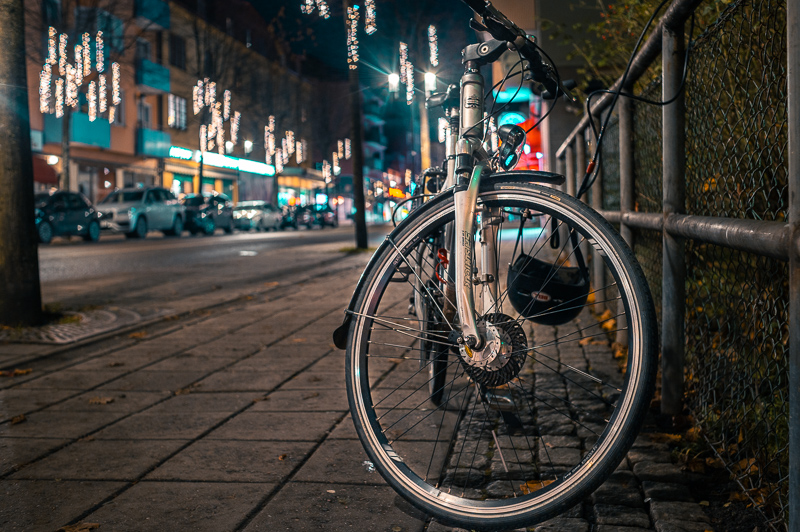

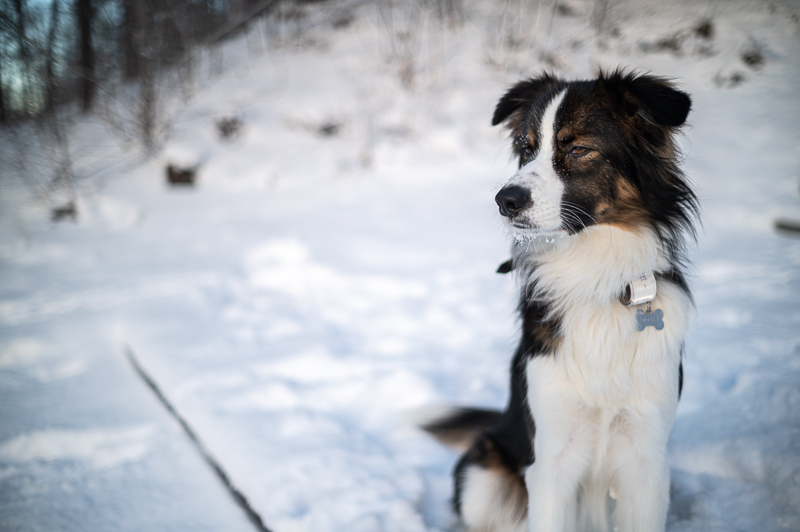



Most of the sample images in this review and many more can be found in higher resolution on the following links: Zeiss 35/14 HFT, Pergear 35/1.4, Tamron 3571.4 USD, Sigma 35/1.4 HSM Art, Nikon 35/1.4 Ai-s, Nikon Z 35/1.8 S.
Further Reading
- NIKKOR – The Thousand and One Nights No.27 (Ai Nikkor 35mm F1.4S)
- REVIEW: ZEISS ZM 35MM 1.4 T* DISTAGON
- REVIEW: PERGEAR 35MM 1.4 – THE CHEAPEST 35MM FULLFRAME LENS
- VOIGTLANDER 35MM 2.0 E APO-LANTHAR REVIEW
Support Us
If you found this article helpful and you decide to buy one of these lenses, please consider using one of the affiliate links.
If you are not interested in buying any of these lenses, but you still found this article useful, just liked reading it or it saved you a lot of money: treat us to a coffee!
![]()

(Donations via Paypal)
Martin
Latest posts by Martin (see all)
- REVIEW: 7Artisans AF 35mm f/1.8 - October 15, 2025
- REVIEW: Nikon AI Nikkor 24mm f/2 - October 12, 2025
- REVIEW: Viltrox Spark Z3 Flash - October 10, 2025


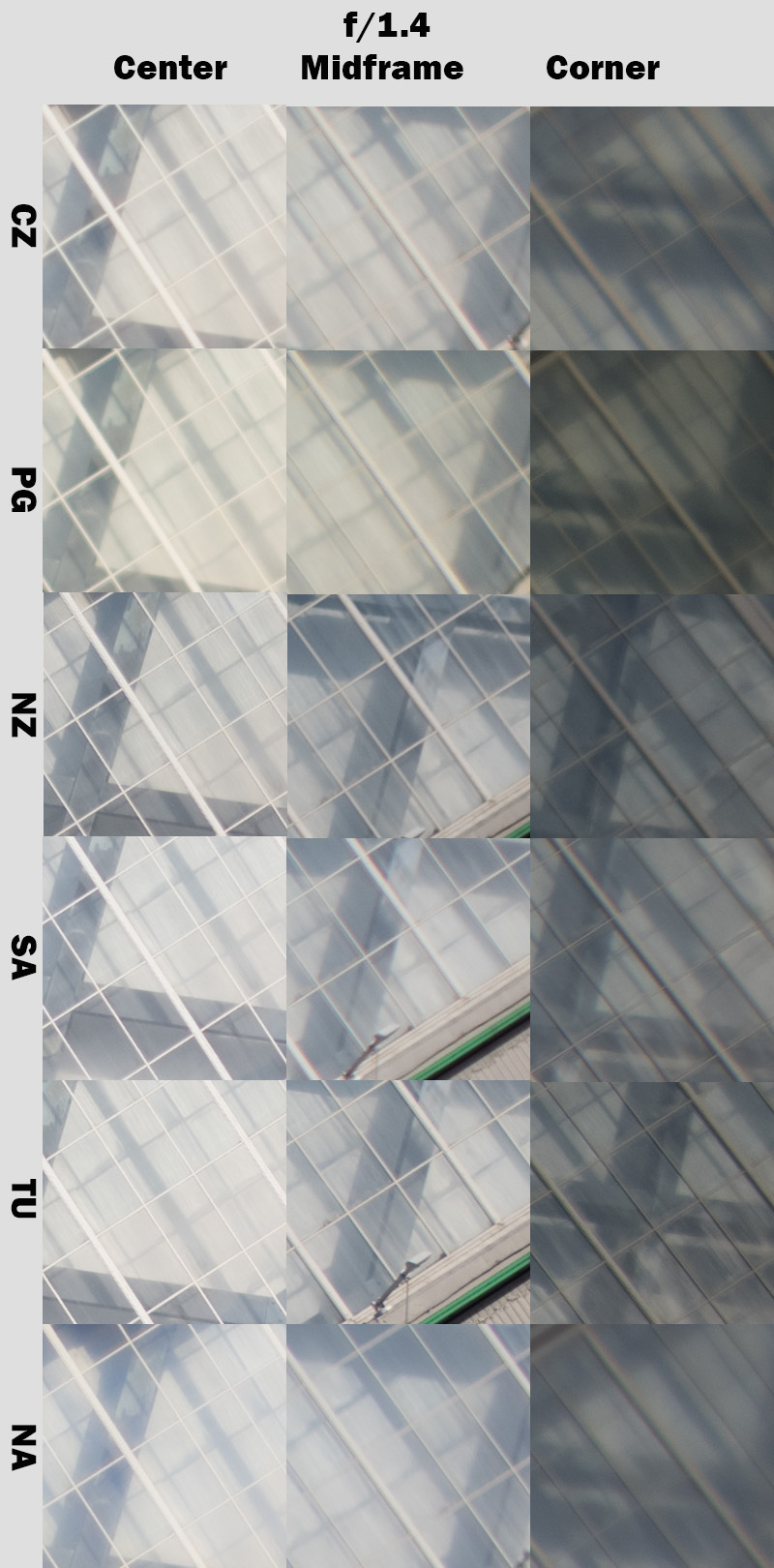
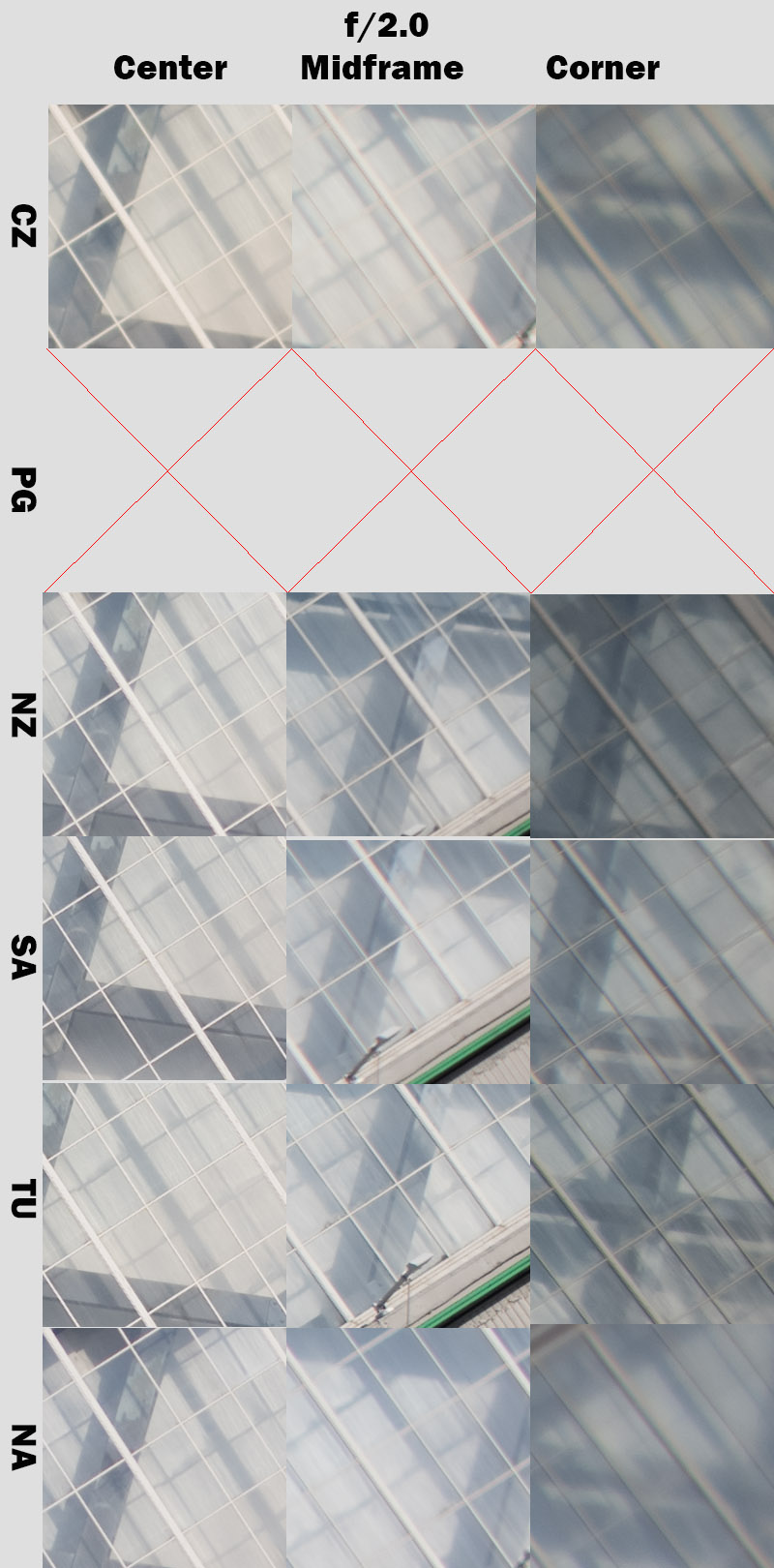
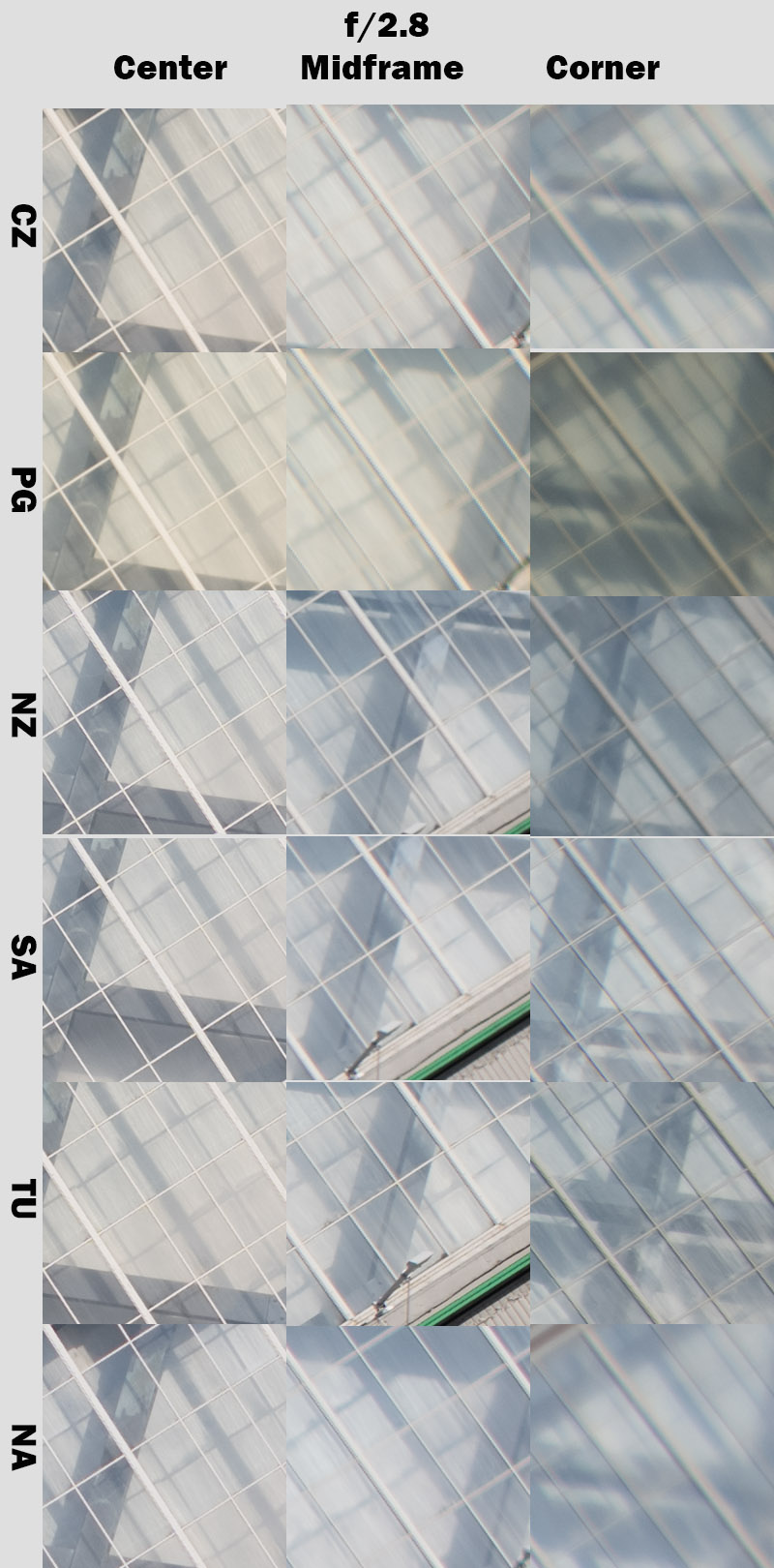
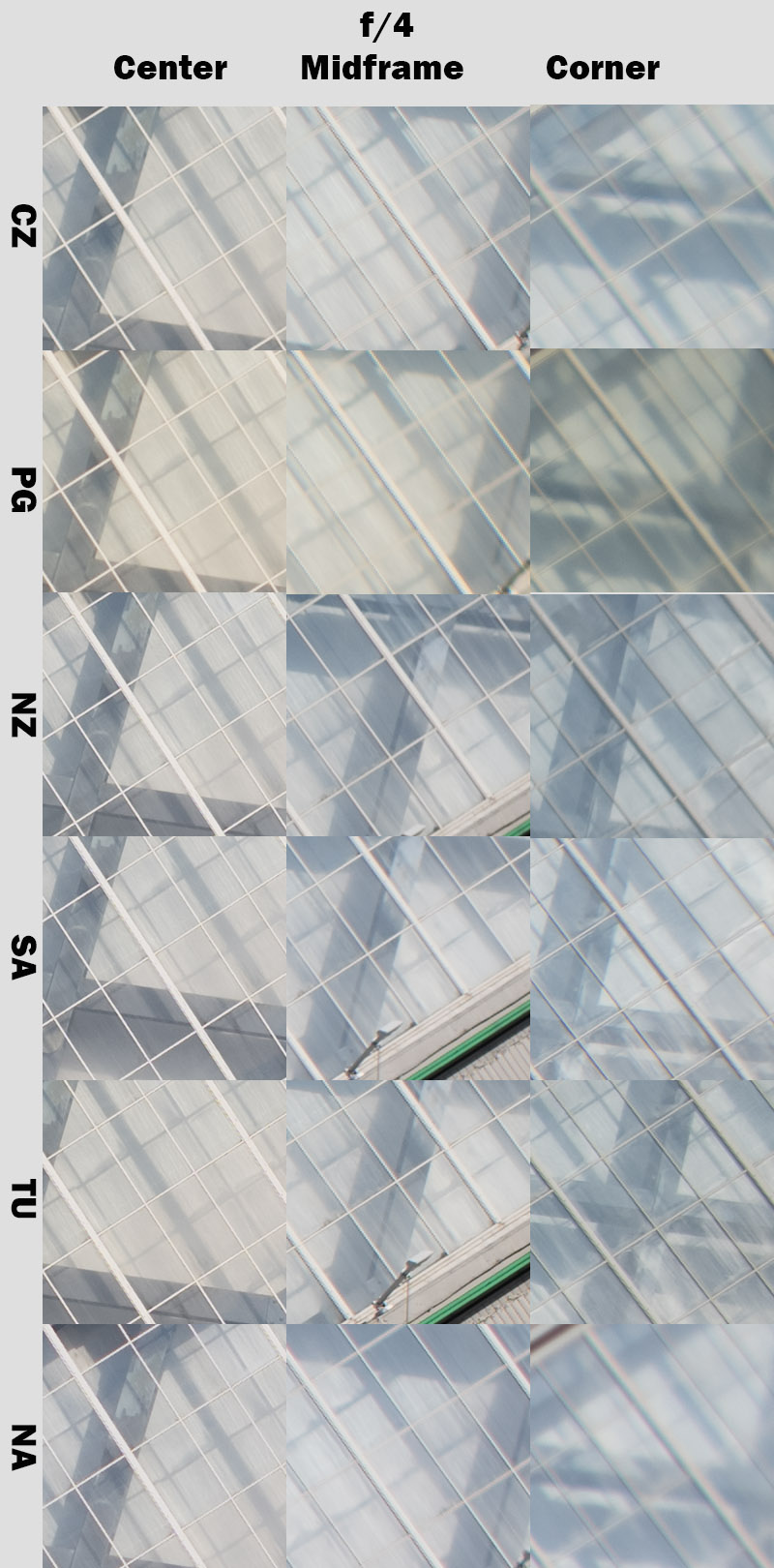
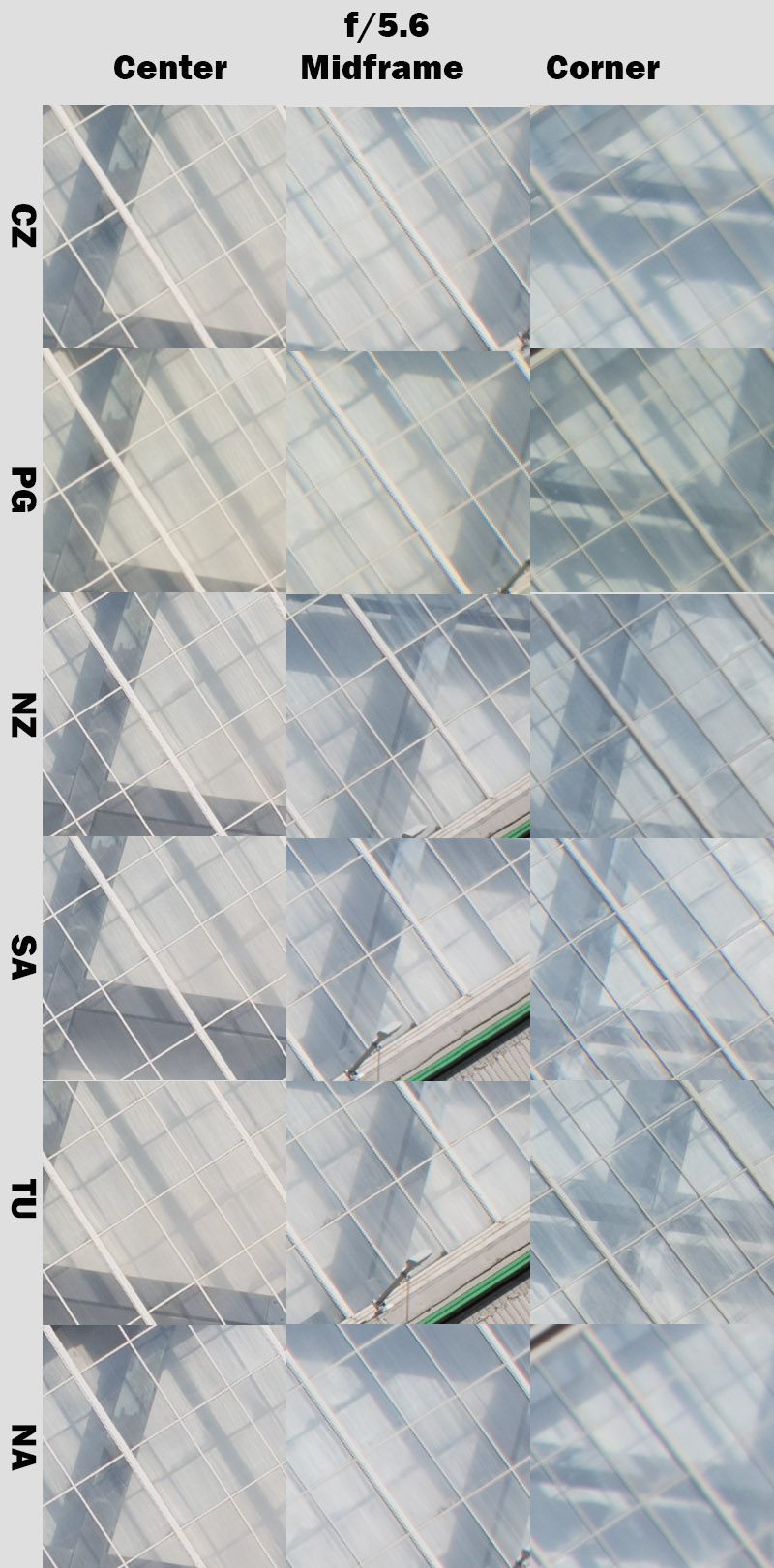
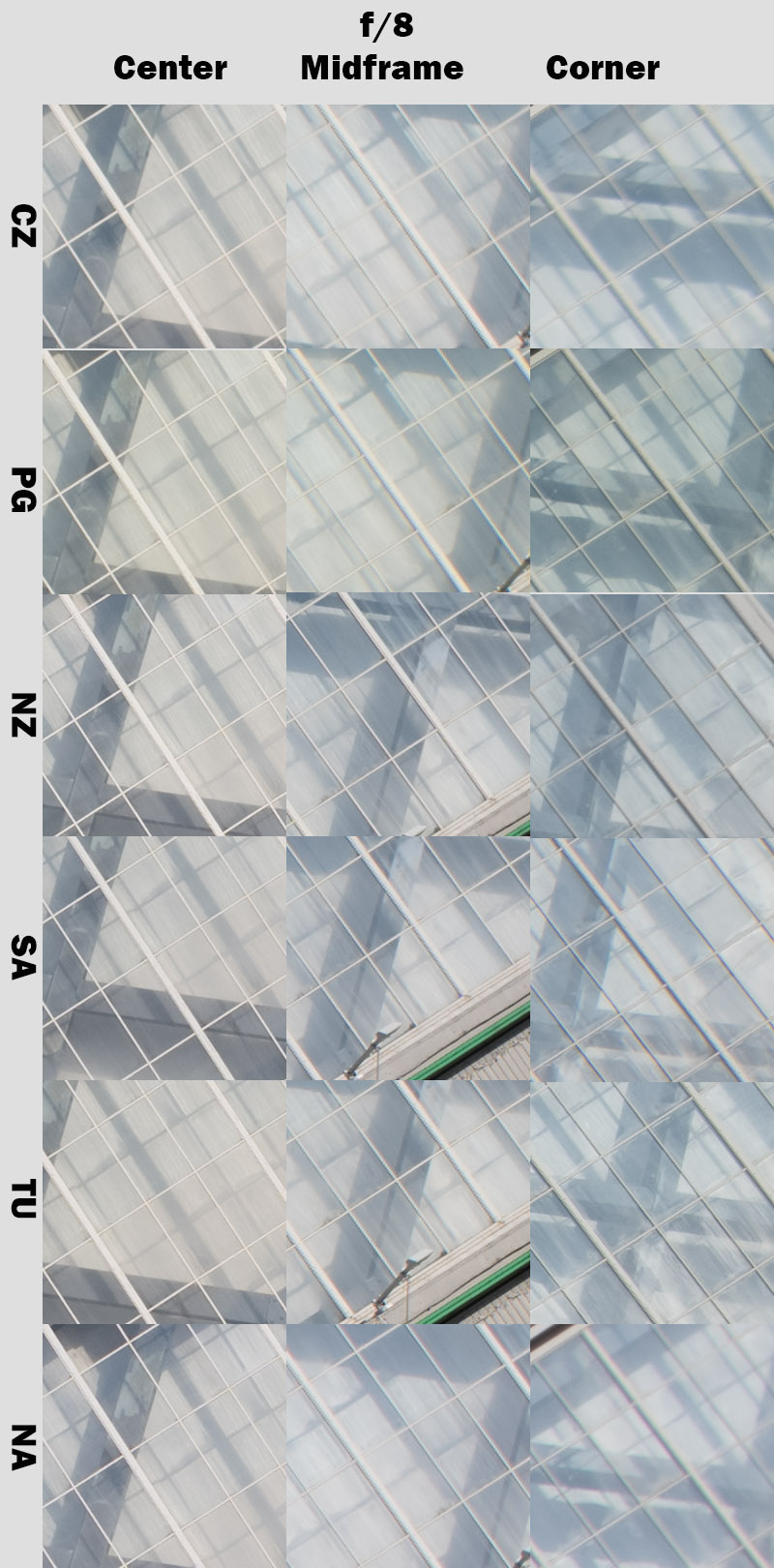
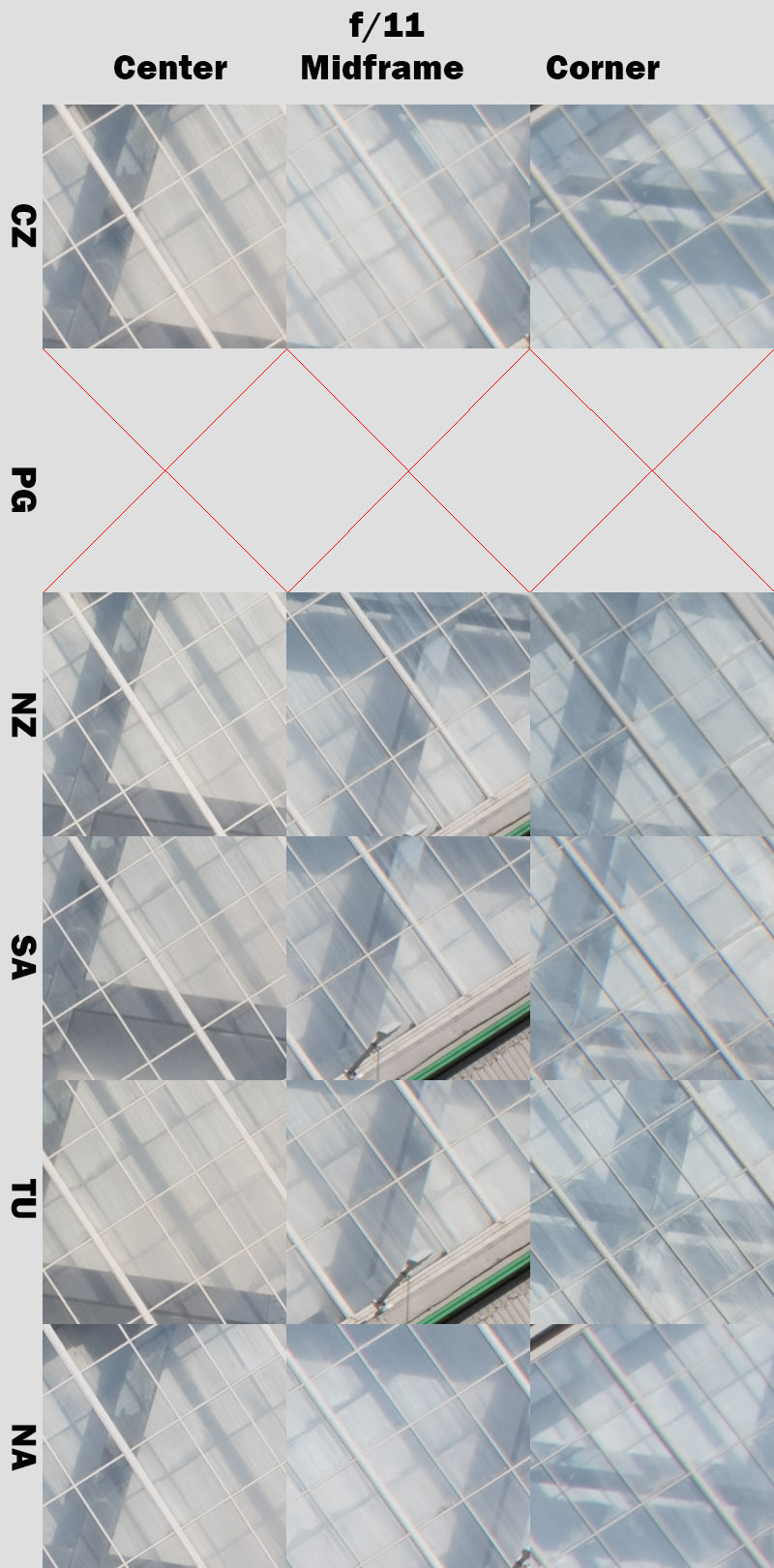
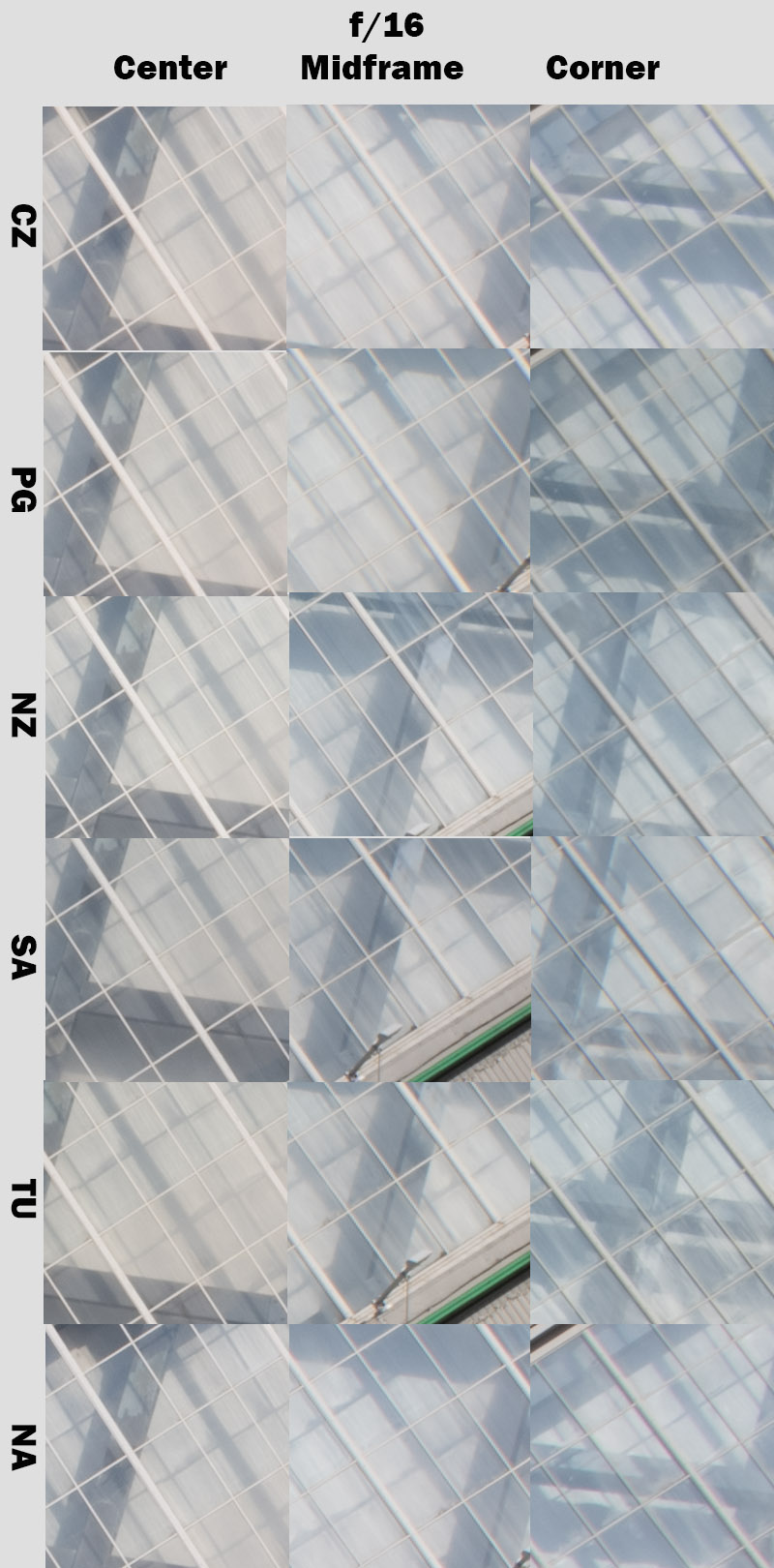

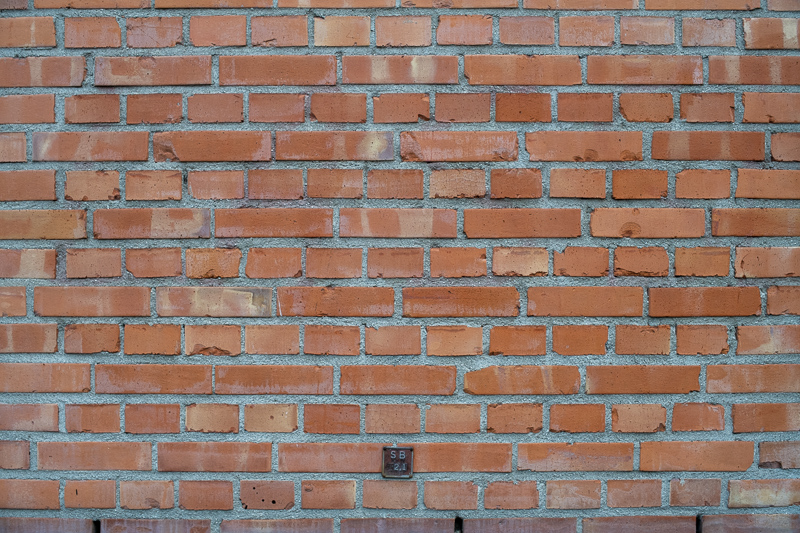


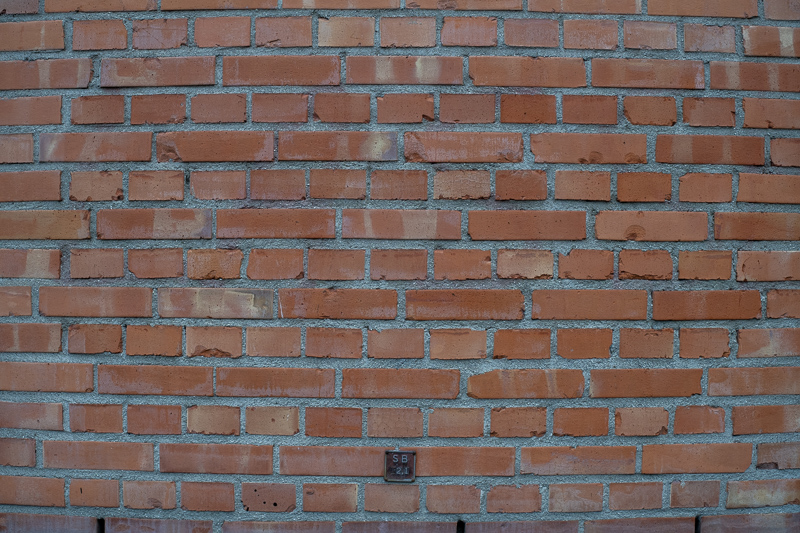
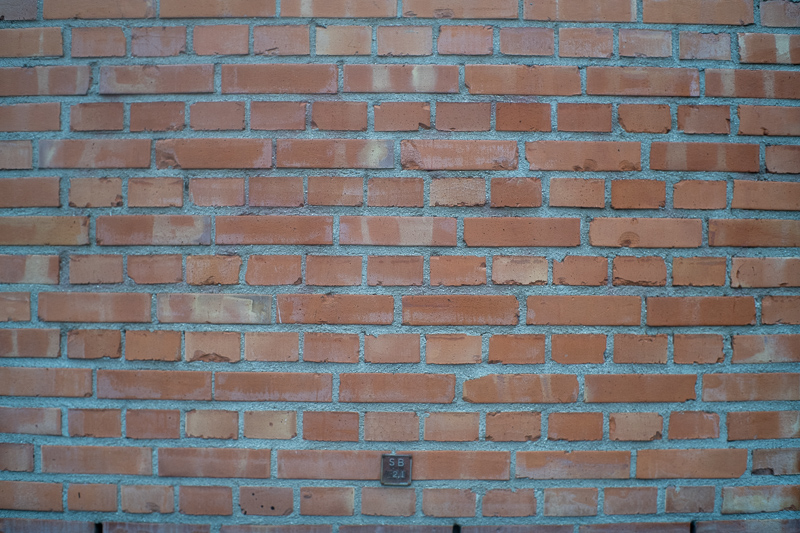
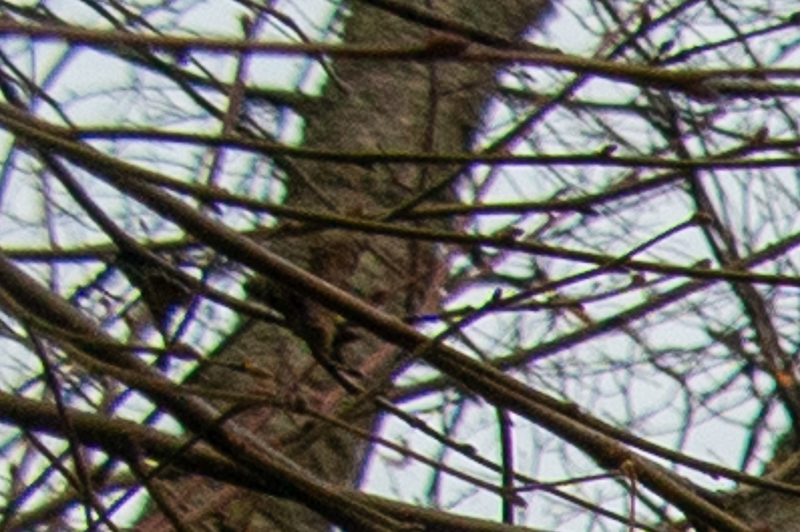
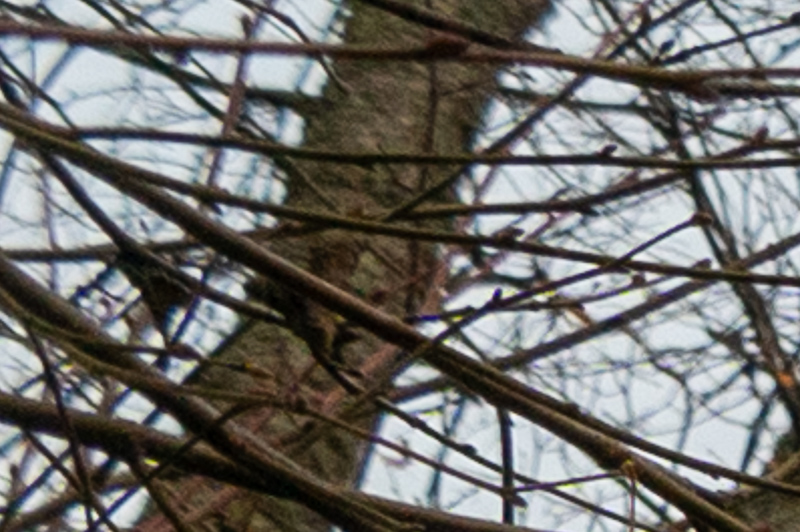
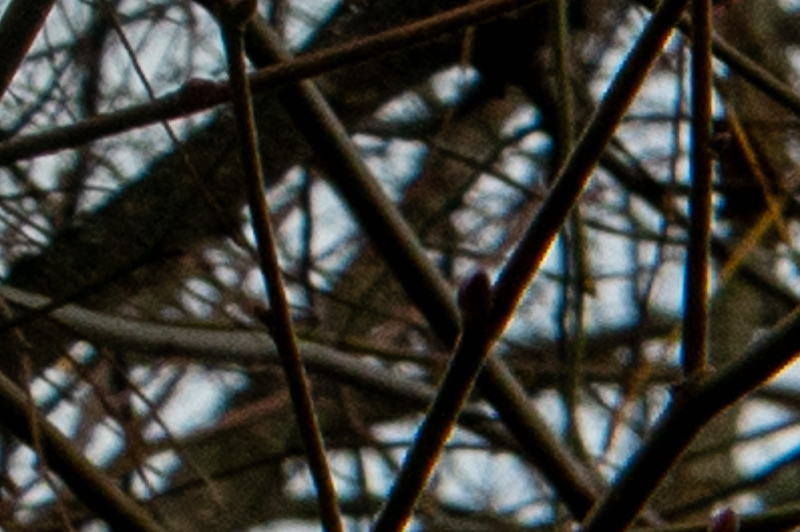
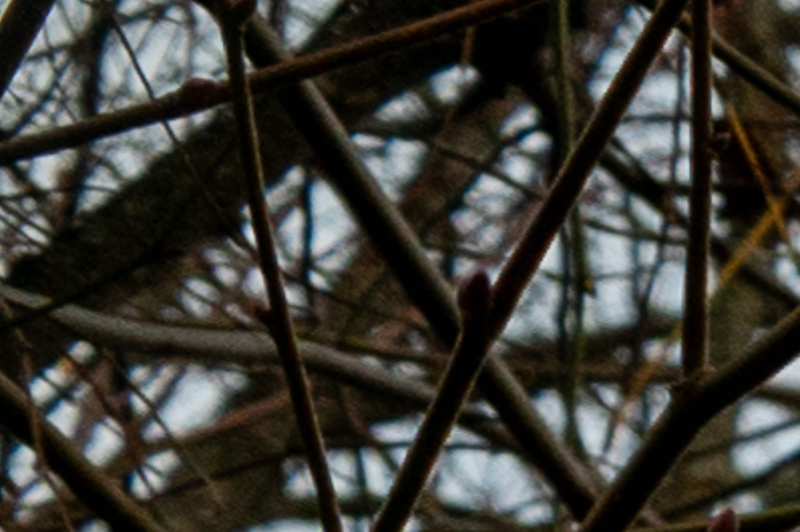
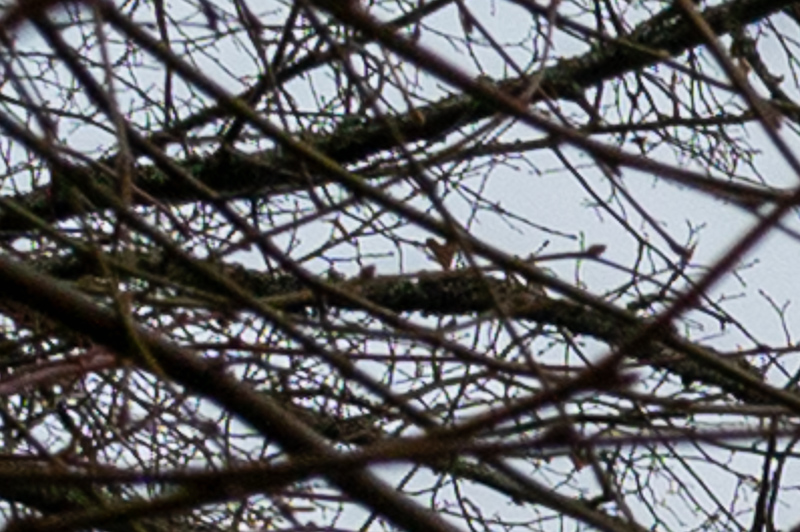
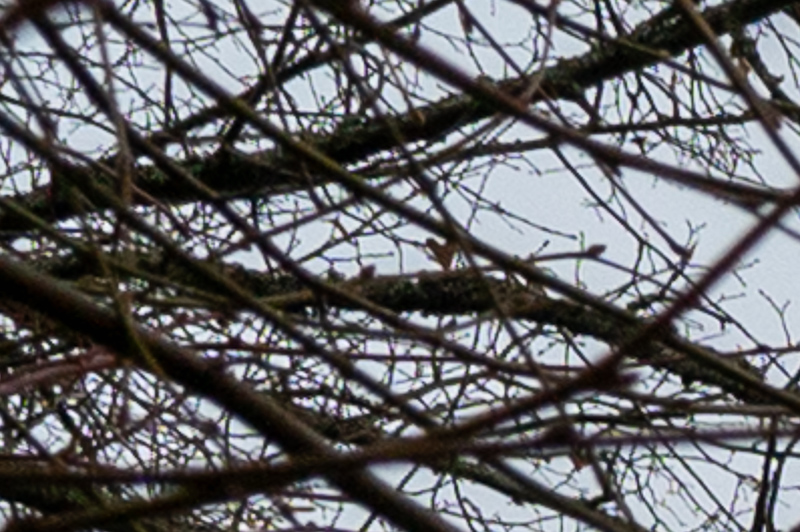
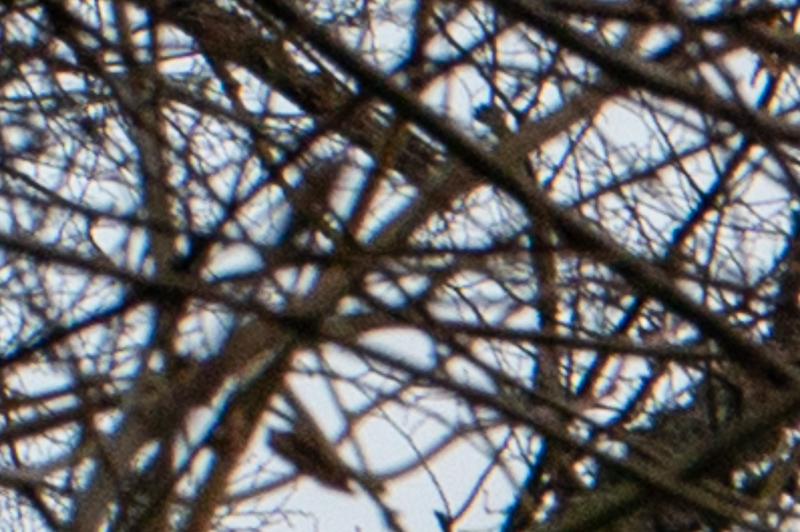
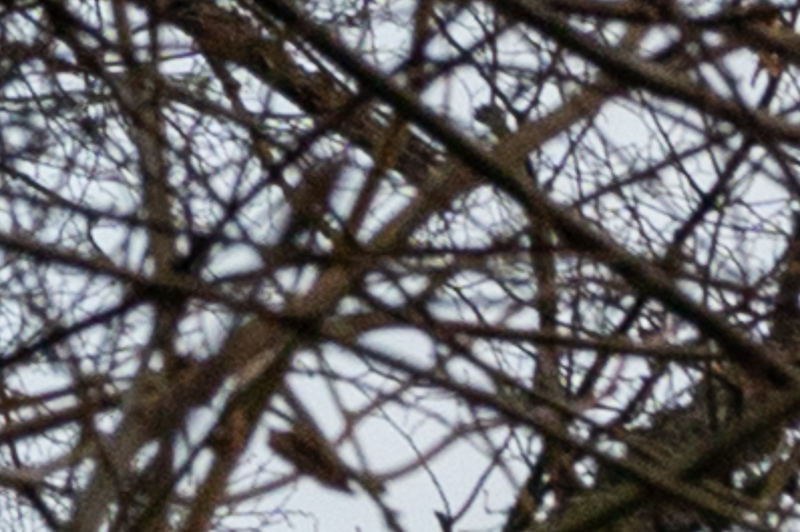
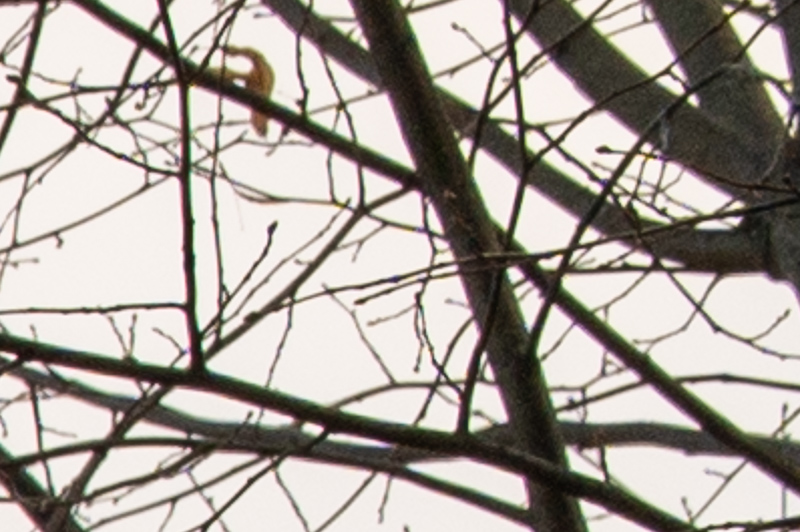
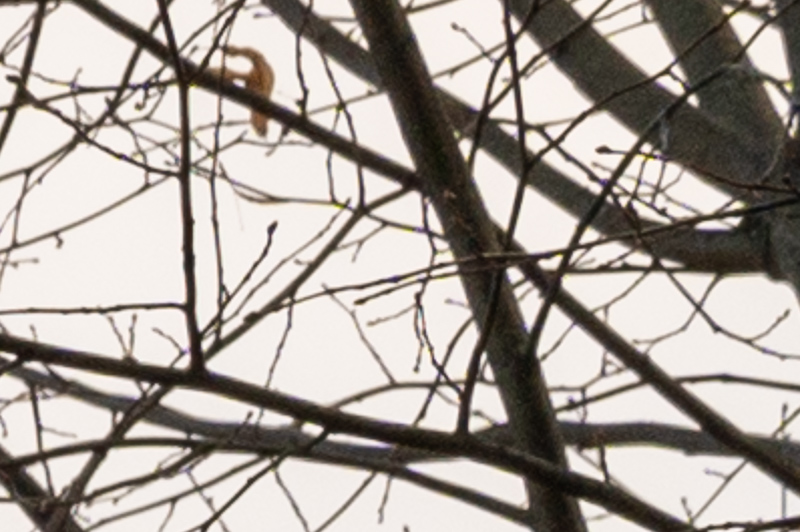
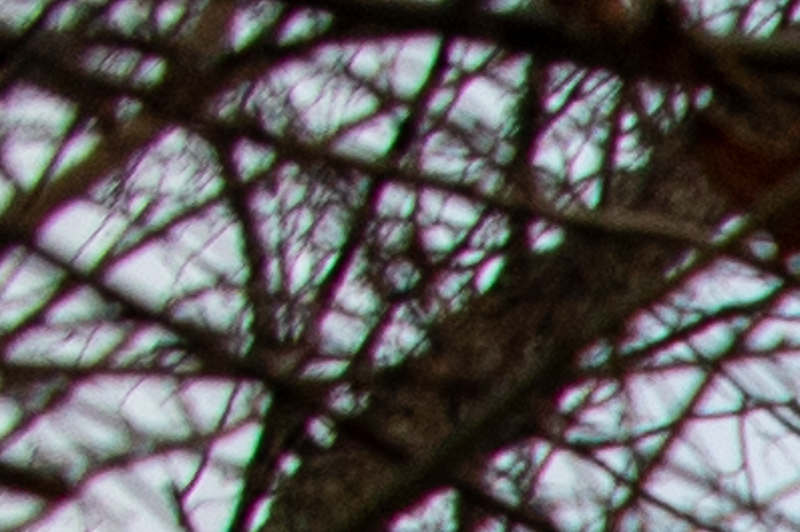
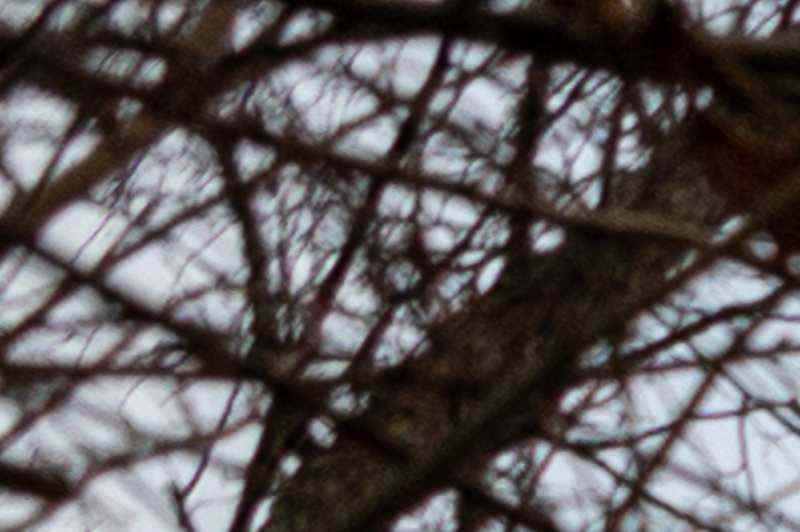

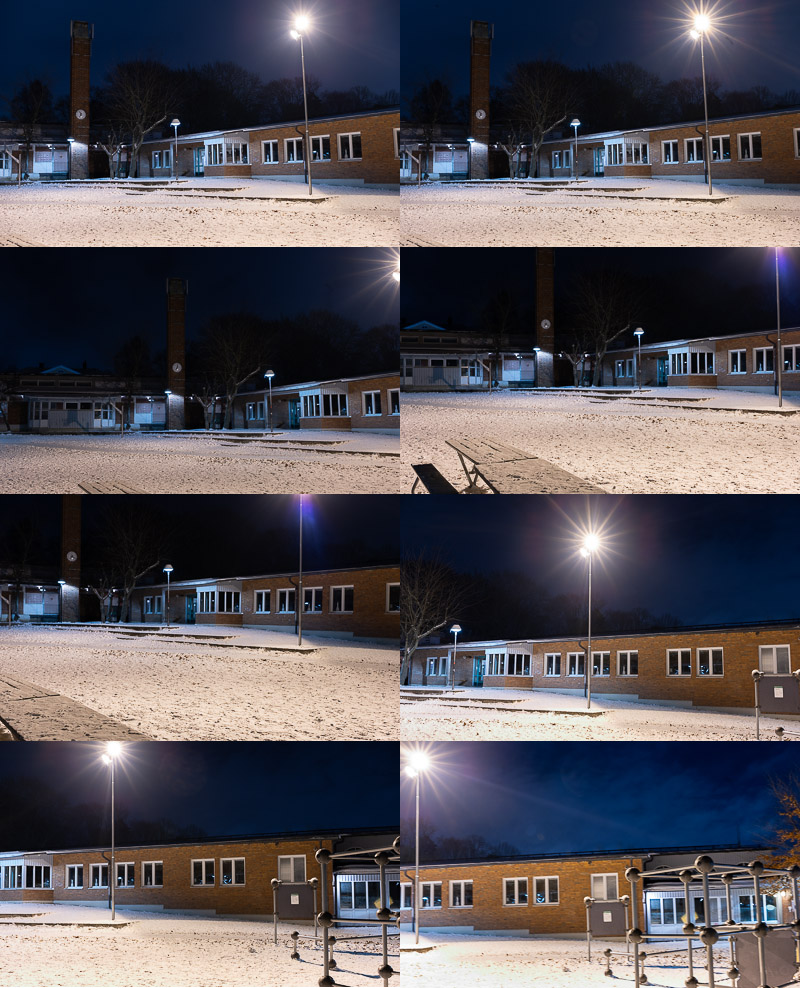
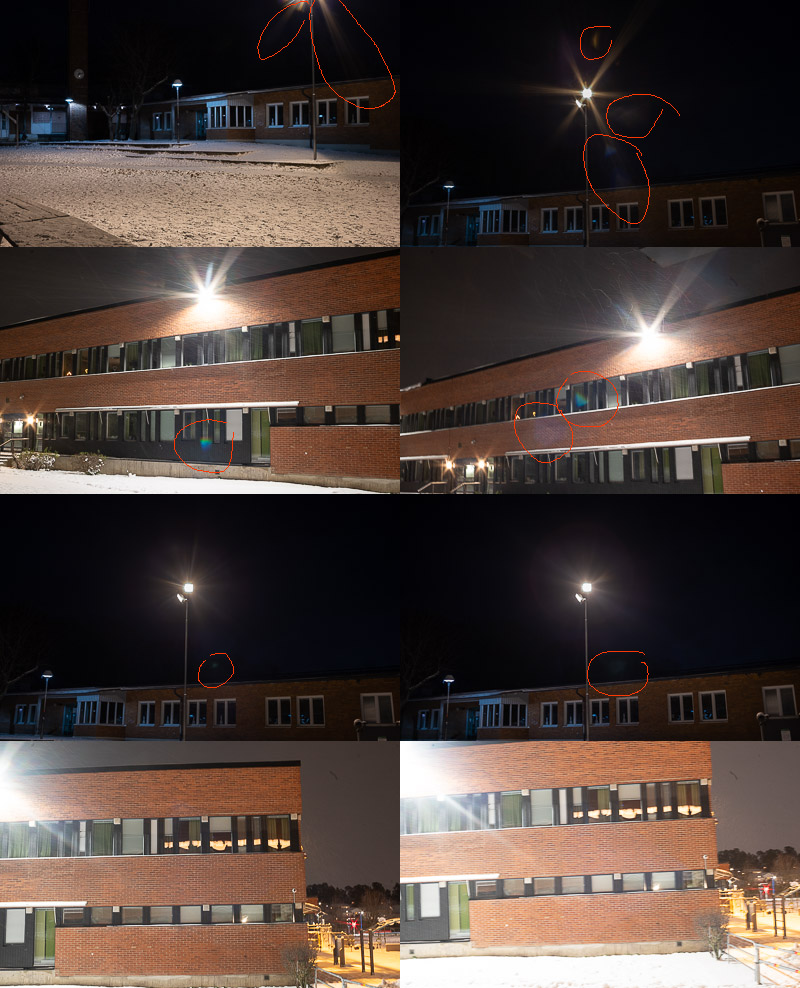
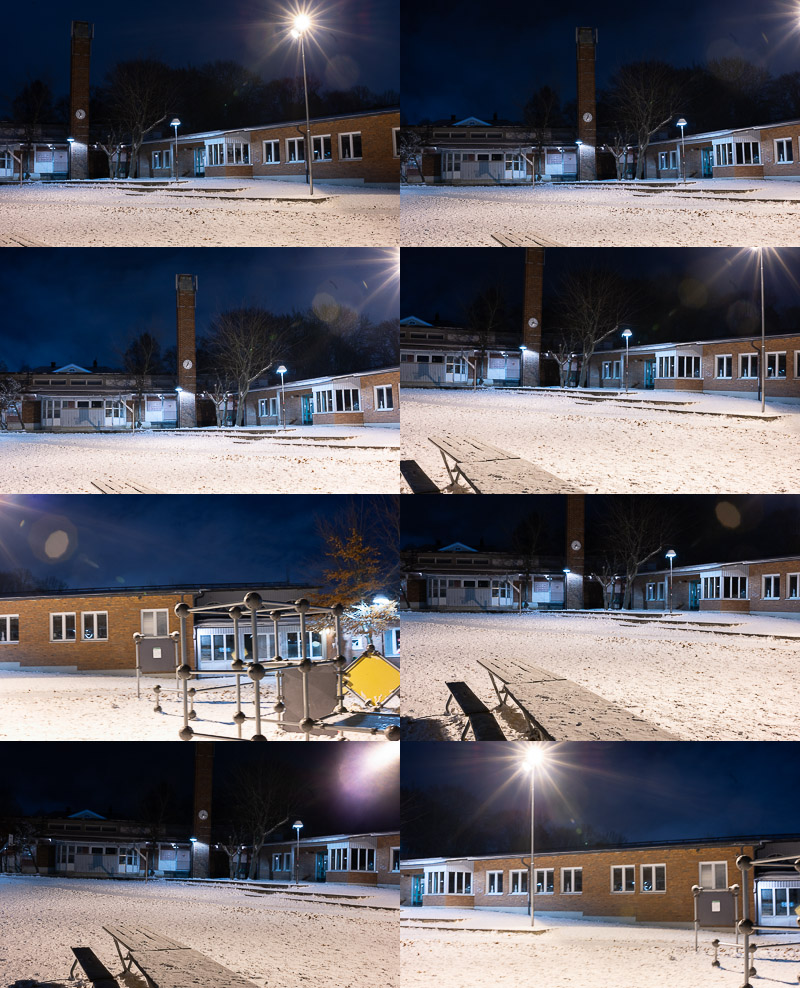
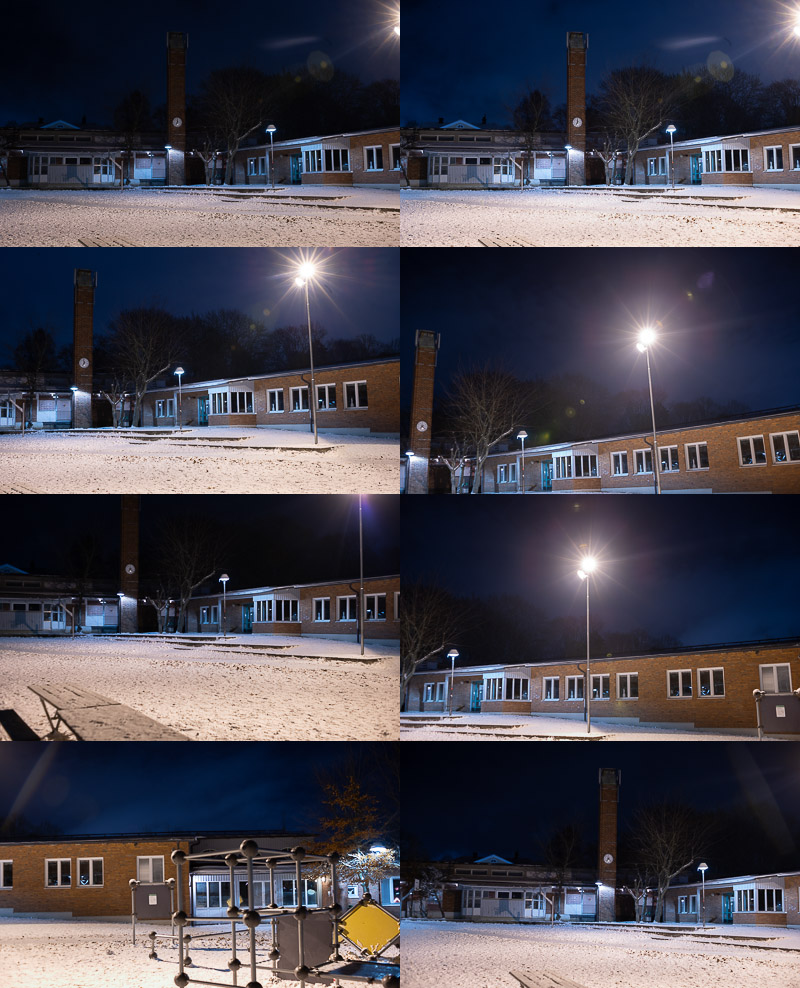
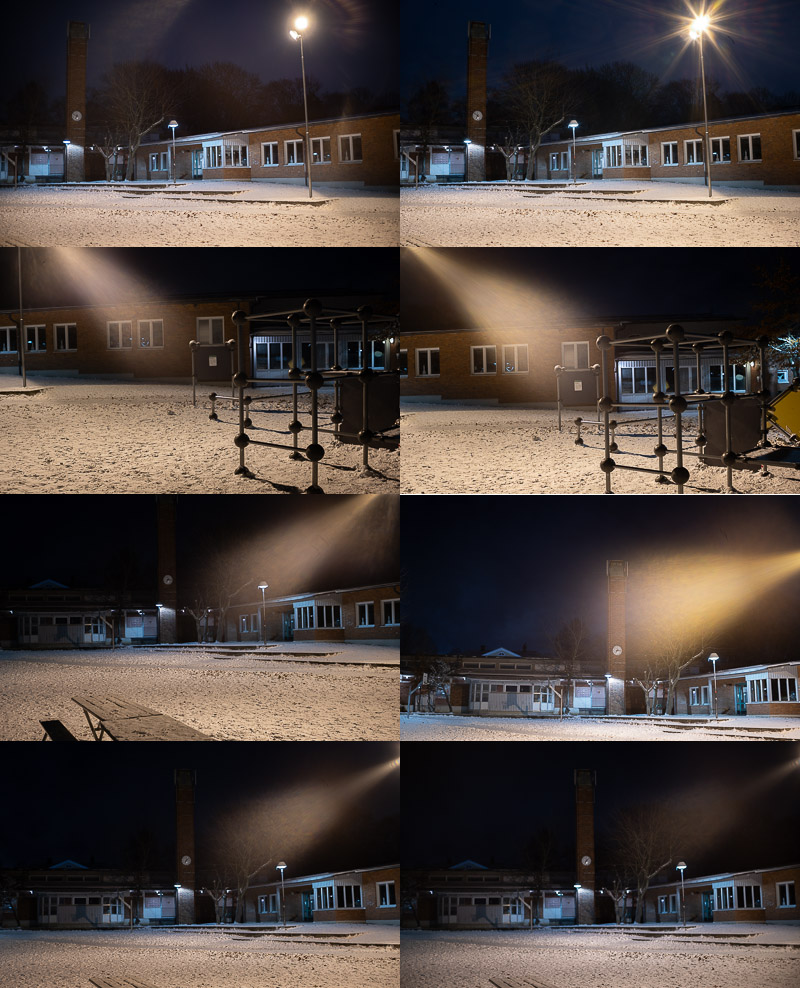







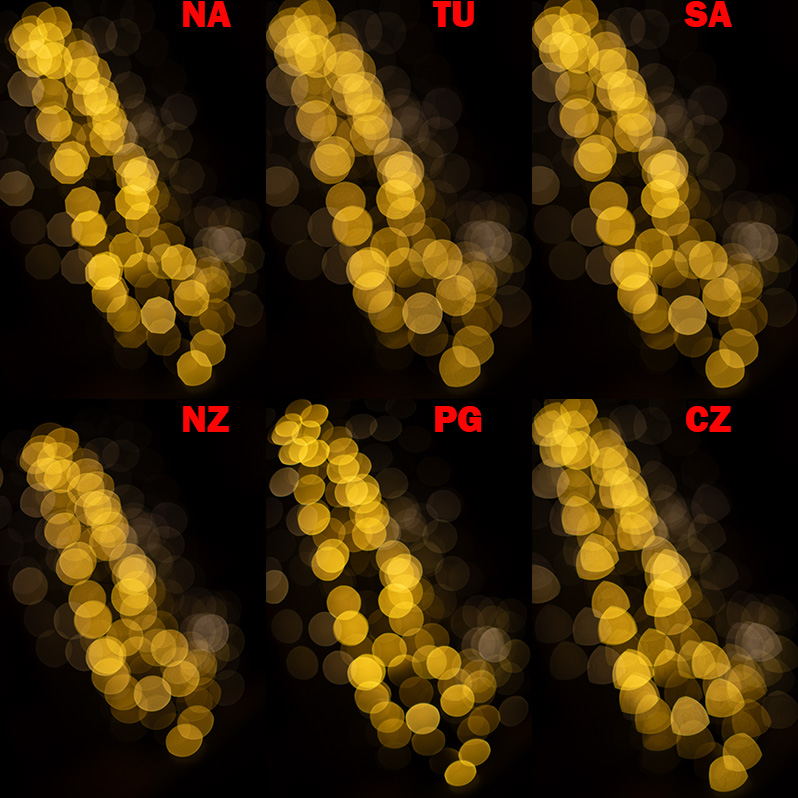
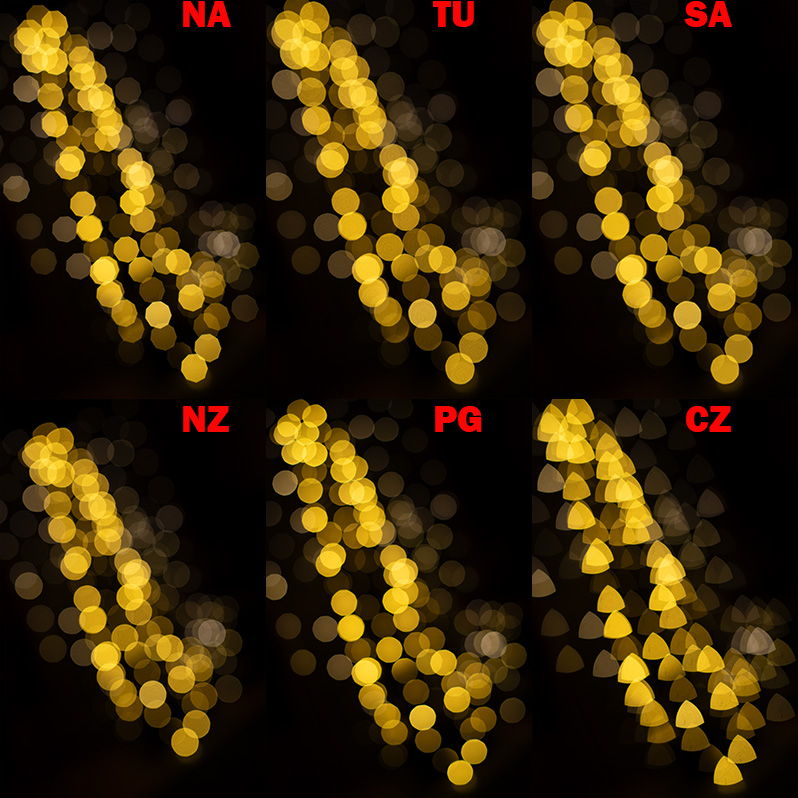
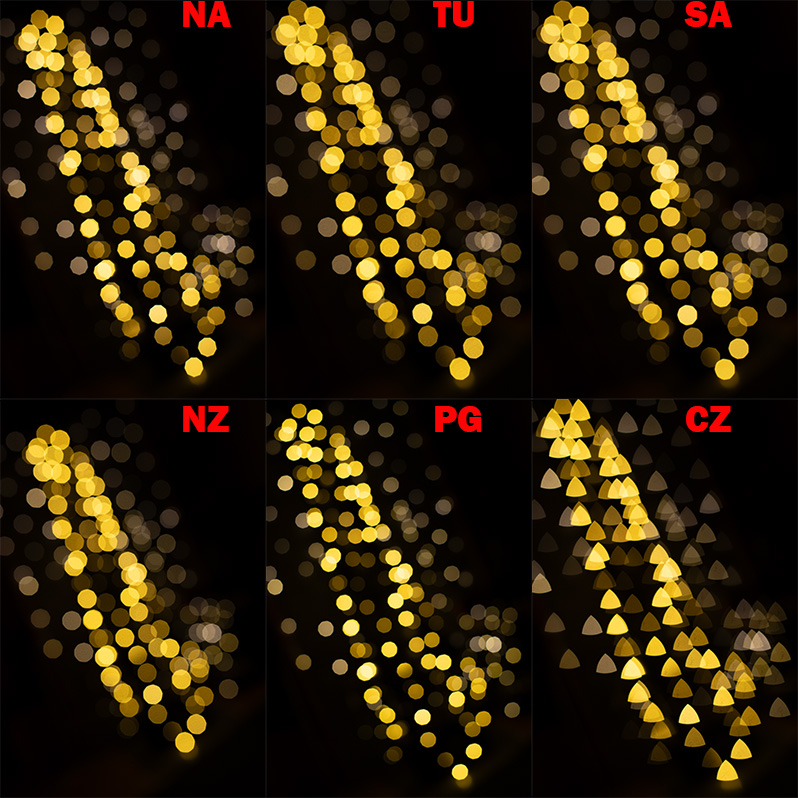
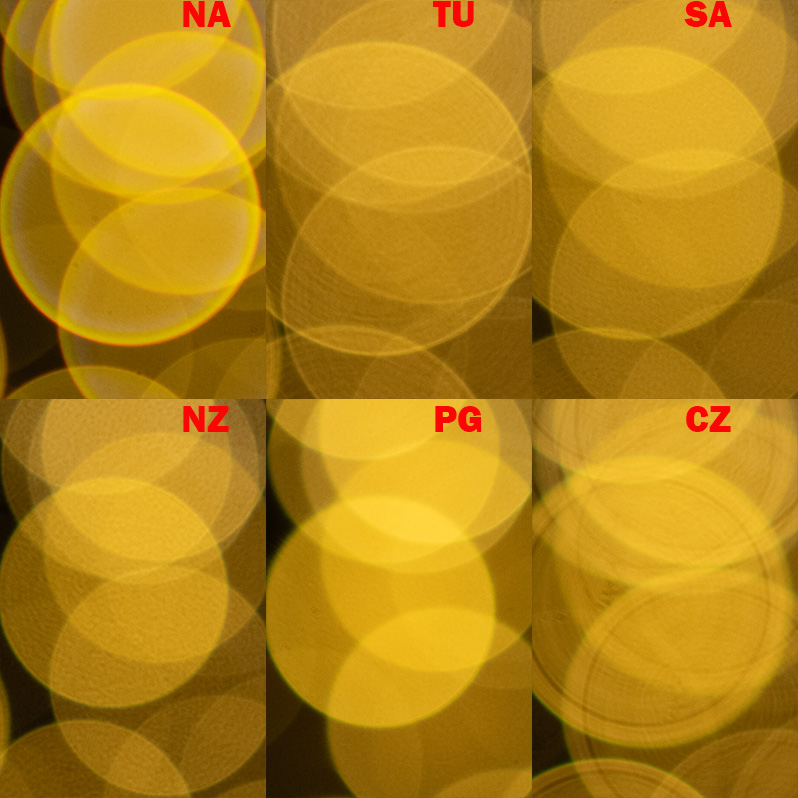
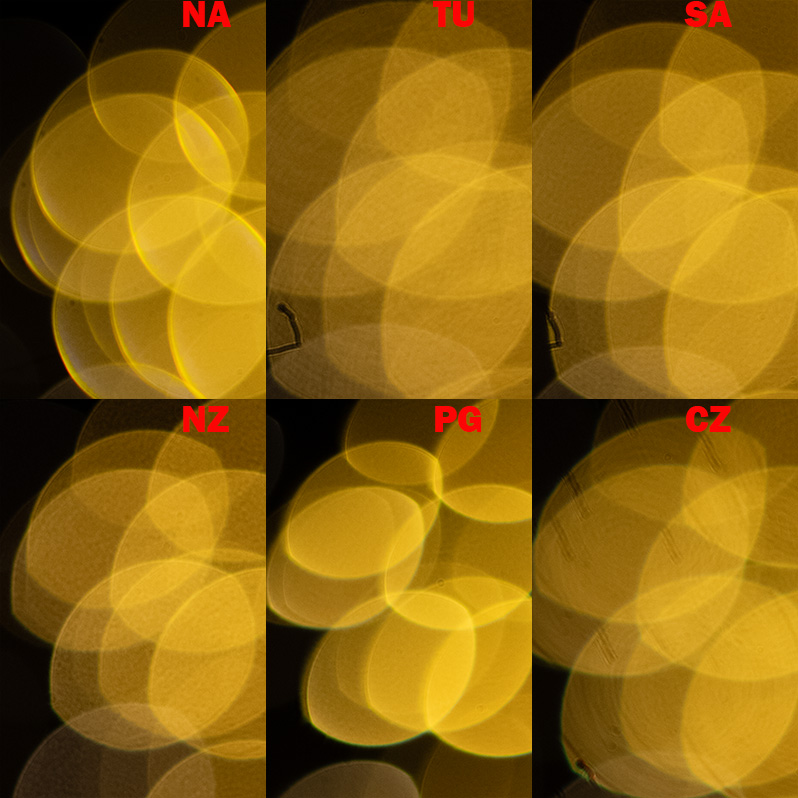
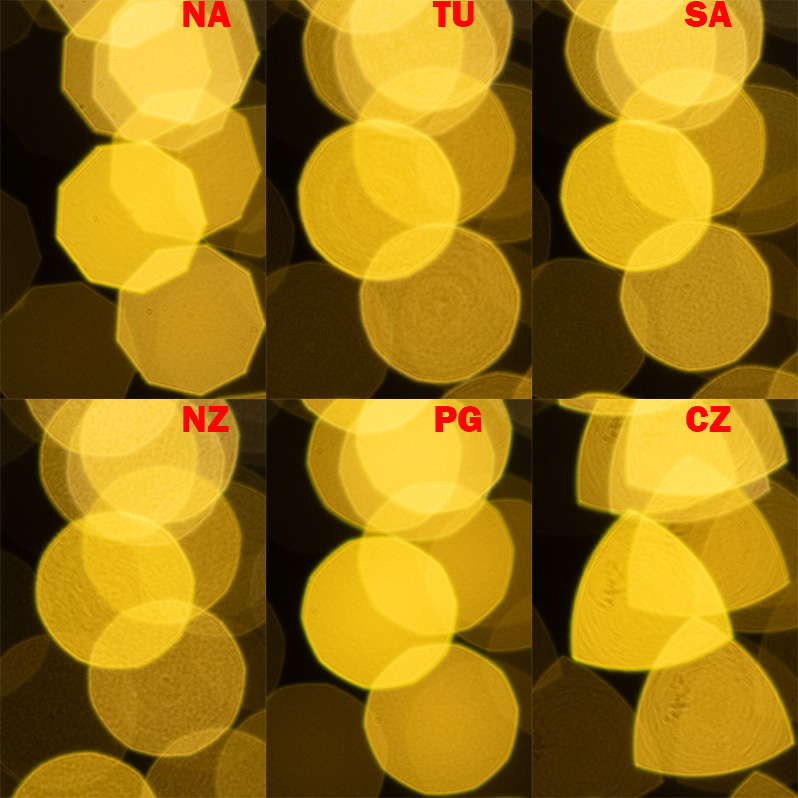
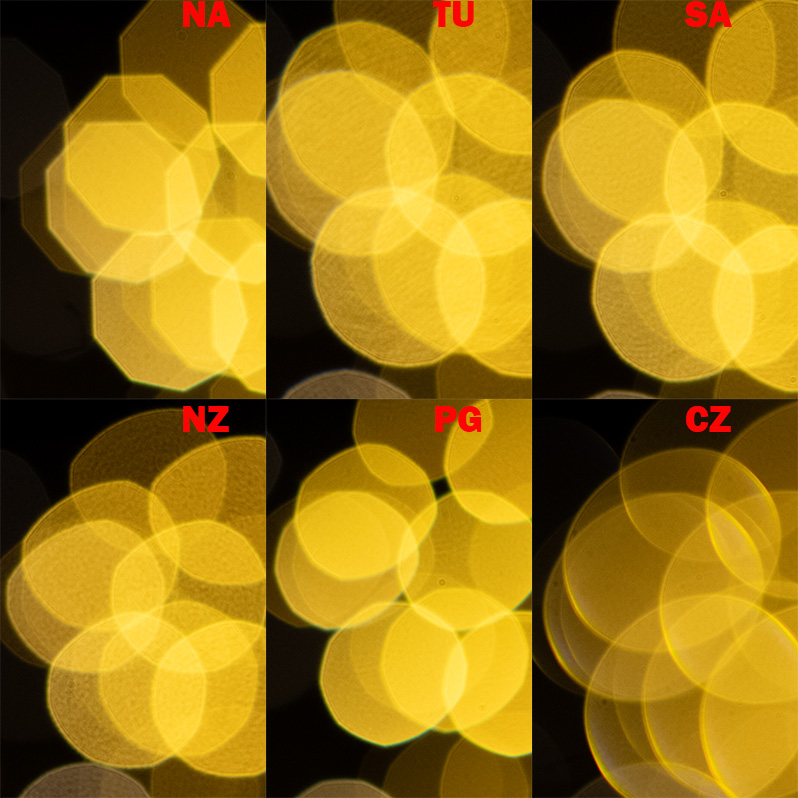


















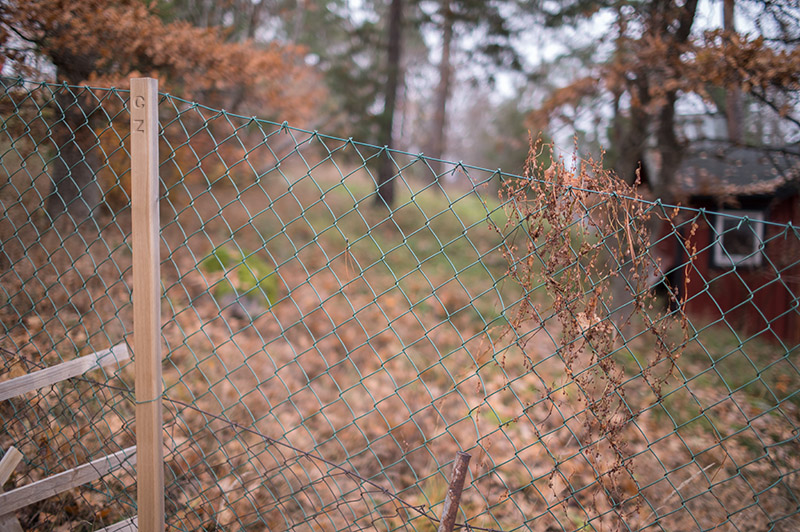

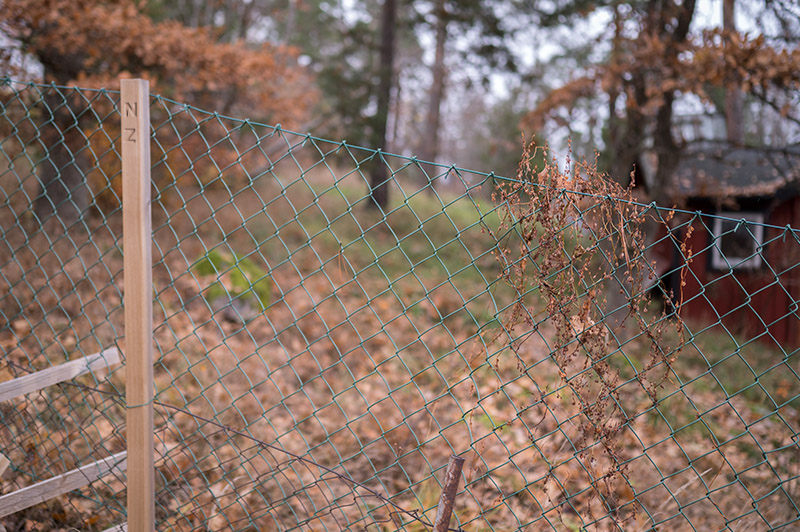


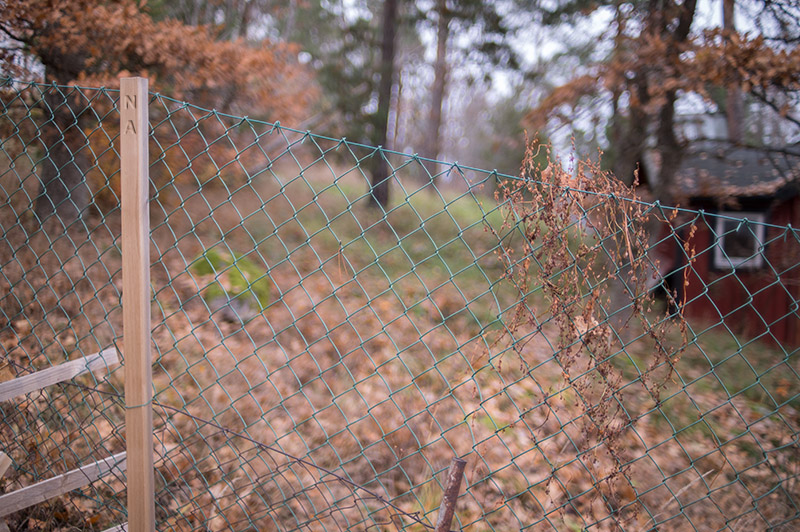






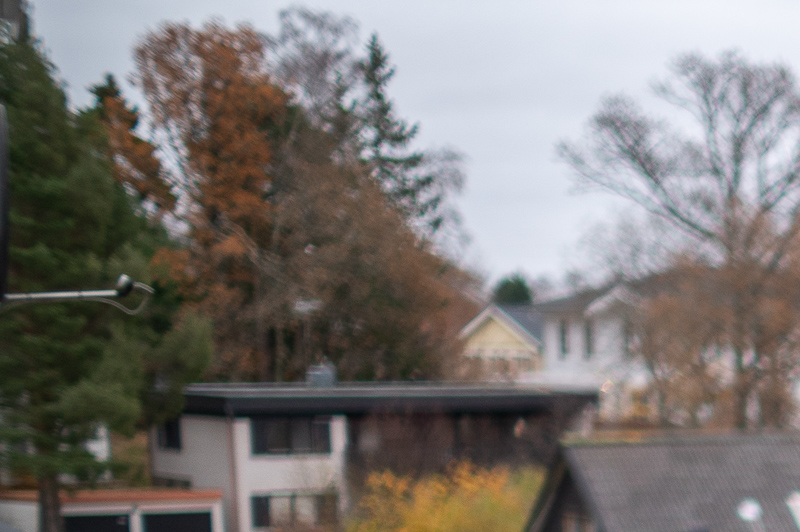




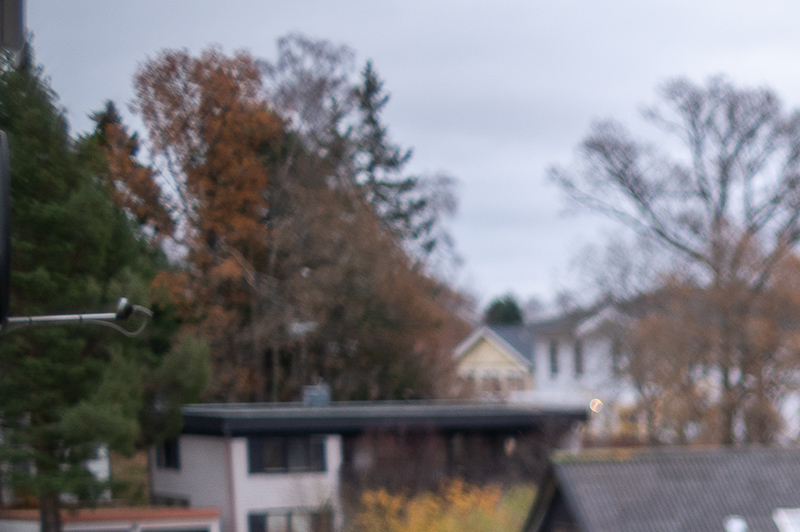
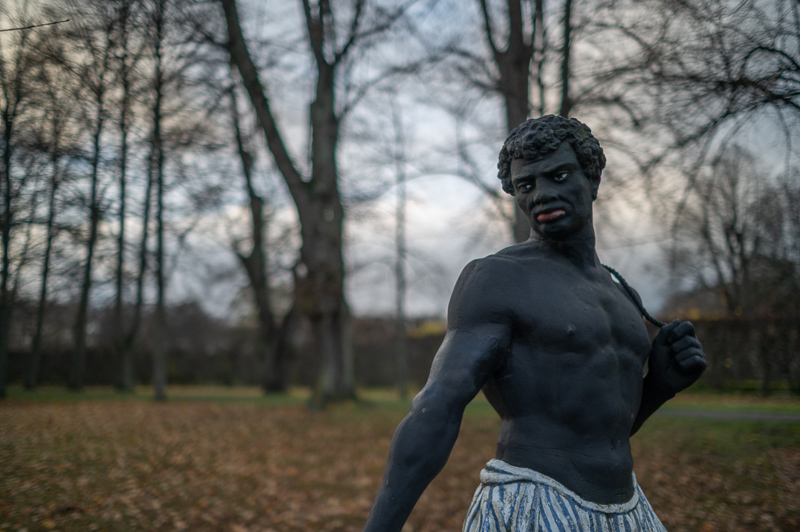
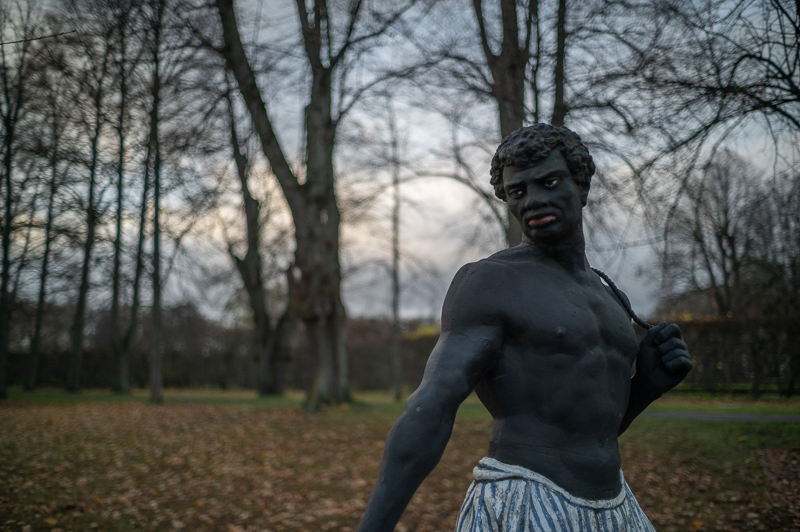
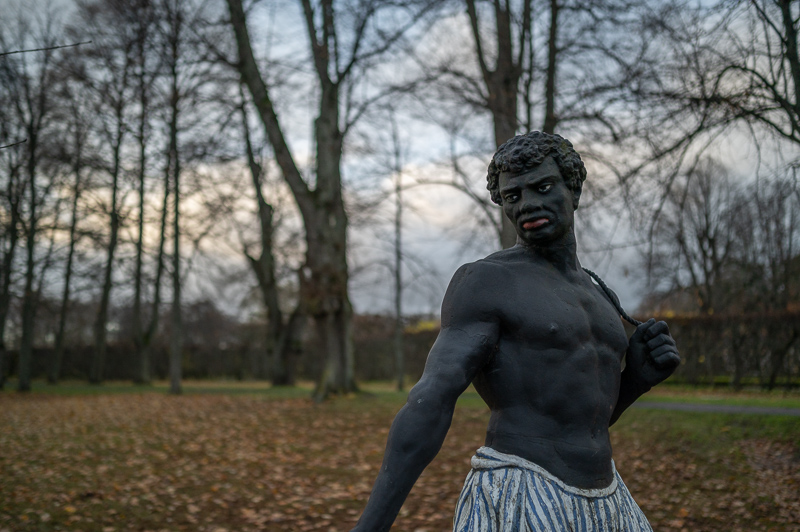
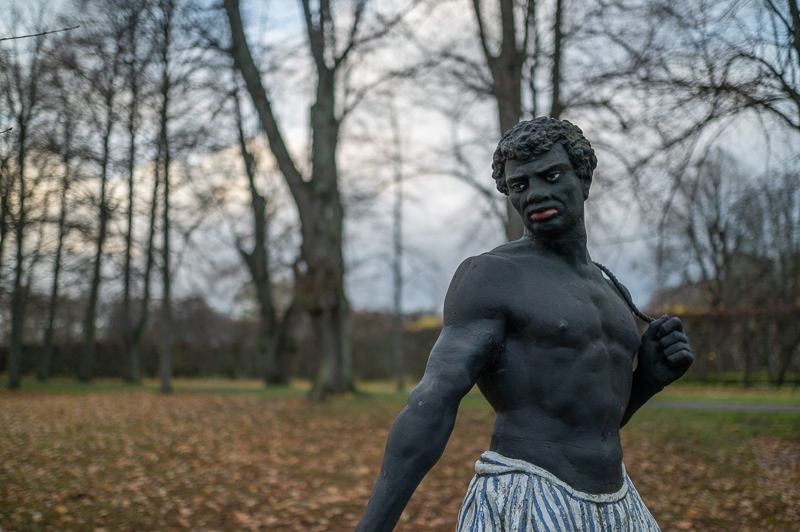
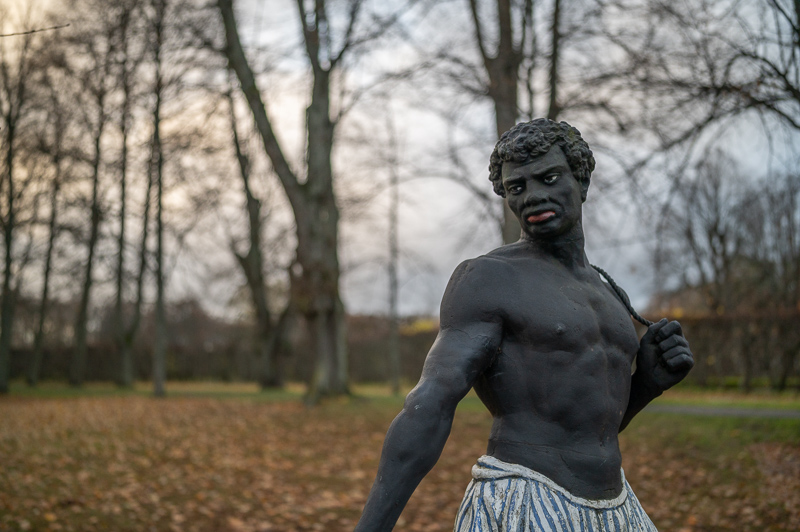
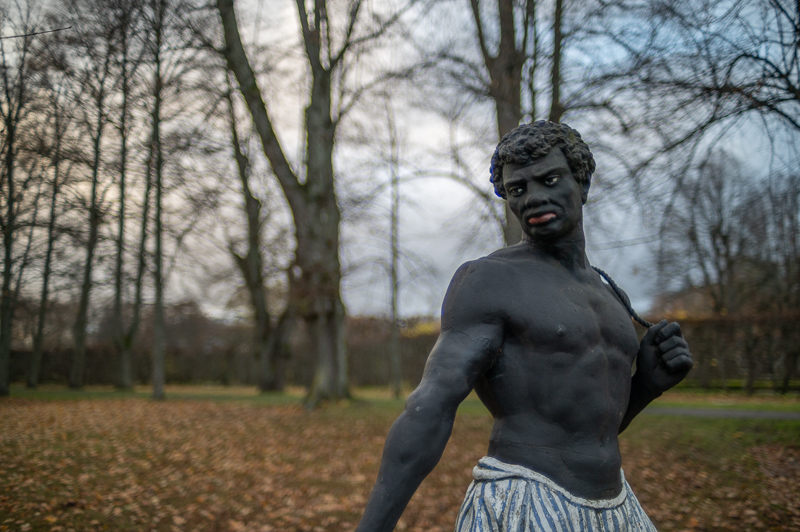


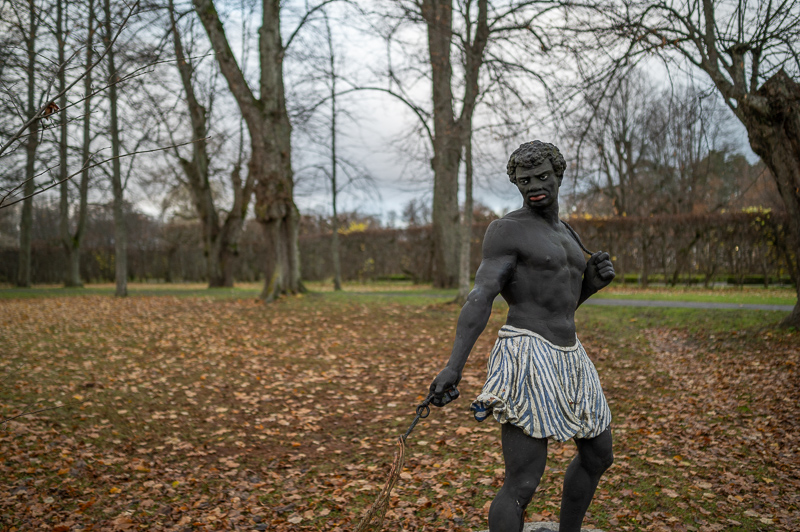





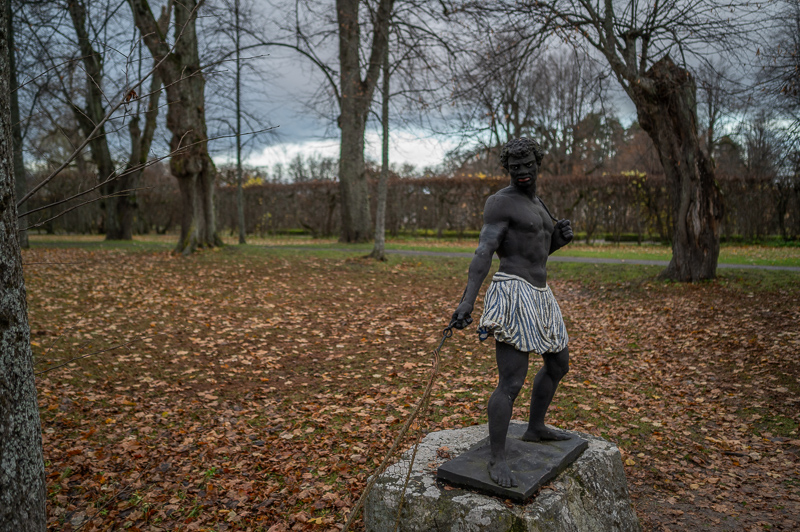

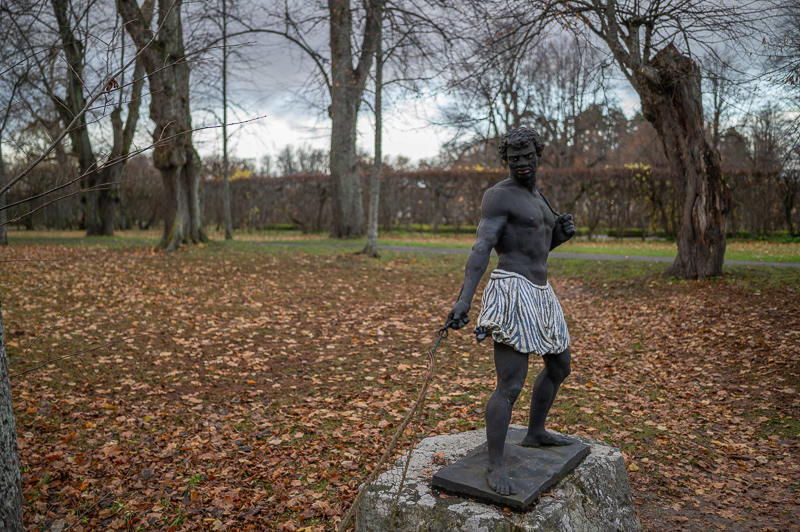
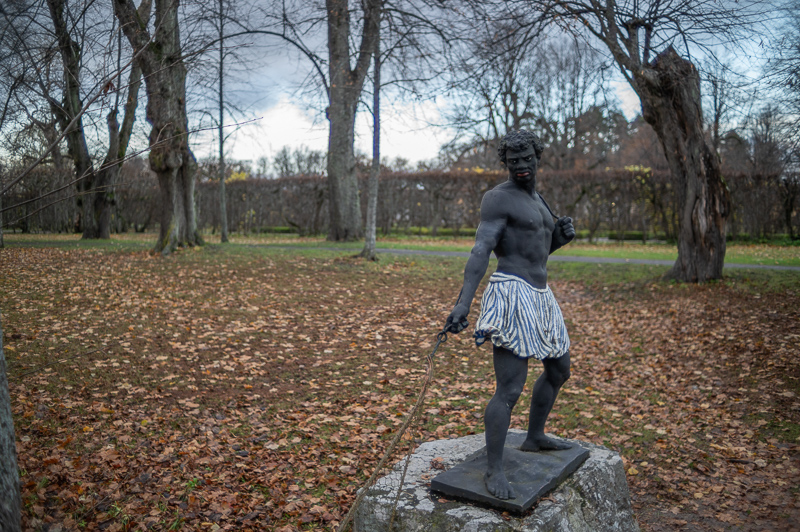


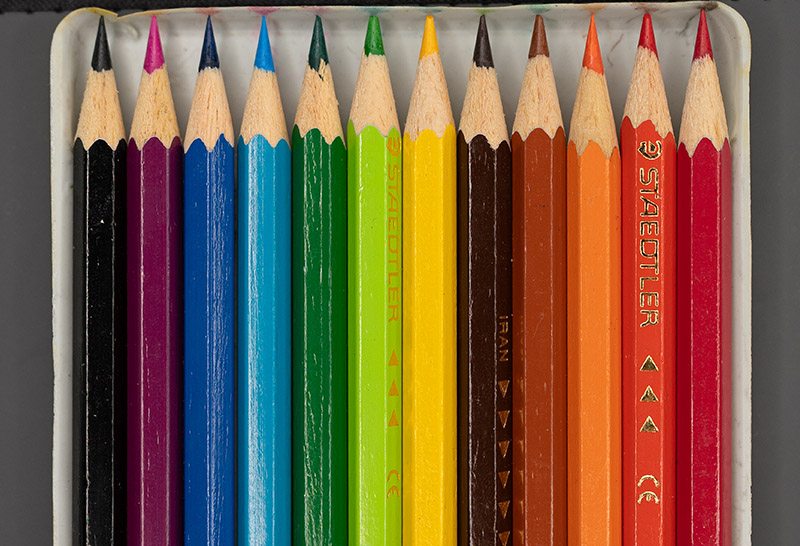











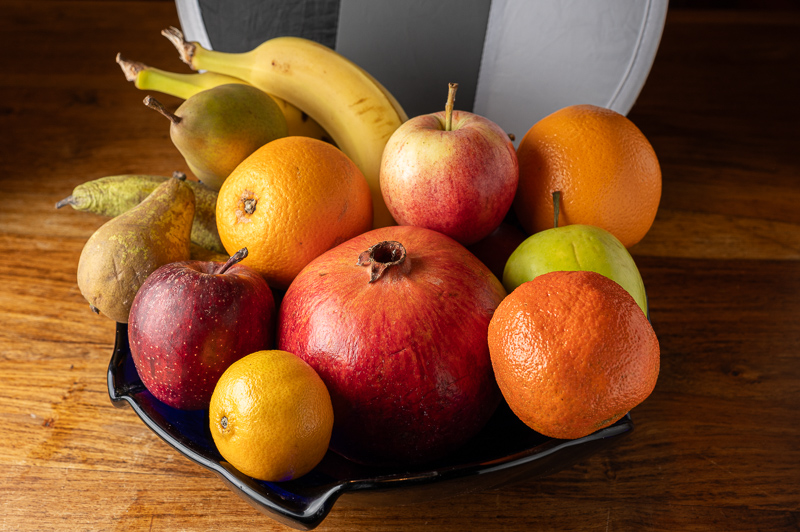



What a great comparison review, Martin! Thanks for going to all this work. The Tamron is a superb lens, no doubt (and the Nikon is also great if you have a Nikon body, which I do not).
Thanks Matthew.
nice comparison Martin. as a Z6 full spectrum, Z7, Z8 and former D800/D750 user. I sold my 35mm Art which I liked a lot except for the coma smearing. I do a lot of astro lapsing as well. Found a cheap excellent 2nd hand Sigma 28mm f1.4 art which is in a different league and has no coma, astimatism in the extreme corners. Since 3 weeks I own a Z35 S f1.8 for hiking, did a astro time lapse with it. It is a bit better than the Sigma A 35mm but doesn’t reach the level of the 28mm f1.4 Art. My Z35mm sample apperently shows less coma than yours and my former Art showed more which might be related to sample variation. All those 3 lenses perform very good in infrared. If you you are looking for a nice bokeh 35mm the ai/ais 35mm f2 Nikkor is very interesting, sold that one…. but kind of regretted it. thanks a lot for testing you guys do awesome work.
Thanks Björn, right now I’m fine with the Z 35, If I change it for better bokeh, I possibly change it with Voigtländer 40/1.2 though.
the voigt 40 1.2 is superb
Great review and test to show the characteristics of each of these lenses. I think character or not so perfect sometimes peoples eyes like better than perfection. I know many many folks lived the Sigma Arts rendering for years. The Tamron is one I loved its bokeh rendering but never got the lens . Instead I bought the Sigma Art 28 and 40mm f/1.4s . The 40 having almost no character at all it’s seems sterile and too perfect. The Sigma 28 mm Art is so sharp on my sample even beating out the 40mm Art . But it has a character when shot wide open up to f/5.6 I love . Now I shoot the Voigtlander 40mm f/1.2 mostly. But I have a sleeper lens I absolutely love and wish you’d have tested. The Nikkor O 35mm f/2.0 non ai lens . Where your Nikkor 35mm ais f/1.4 lens sharpened up at f/2.0 this Nikkor O is about the same at its wide open point . This lens has a beautiful rendering of its oof areas . Beautiful Bokeh and very sharp in the center. My next lens is going to be the Voigtlander 28mm f/2.0 Vintage ii.
Somehow I dance around that 35mm fov and I like it a lot . It is truly a workhorse focal length .
Thanks for this insightful review.
Oh one more thing you forgot to mention. The color was so far off on the 1969 Nikon ais because it was right at the point people were changing from black and white film to color . It probably rendered more towards the blue spectrum for black and white film .
Thanks again
Thanks Troy. None of the test shots are sharpened or have any Texture/Clarity improvement.
Sample images have about 10-14 Texture/clarity though.
One of the best reviews I ever read! Great job!
Thank you.
“If you ask all the photographers” EXCEPT the ones who shoot with large-format sheet-film cameras, medium-format cameras (either film or digital), Micro Four Thirds cameras, cinema cameras…
What about APS-C users?
Thank you Martin, an absolute great review! May I ask about the Zeiss lens you used? There are newer iterations of the CZ 35mm lens like the ZF/ZE and the Milvus. Are there different in character? Or is the same trait? Has the optical qualities improved? Thx so much! Really appreciate your work! Happy New Year, Michael
Thanks Michael.
I have not used the newer Zeiss lenses myself but the answer to your question is yes, there have been improvements to the optical qualities in the newer generations. Among other things, lens construction in newer lenses is more complex and advanced, and the coating technology is improved. They should have less spherical aberration, be less flare-prone, and have better wide-open sharpness, but they don’t give you the triangular bokeh or the vintage mood that the old one gives.
What I used on my Z7II was Sony 35mm GM on a Megadap ETZ21 adapter. I have a feeling that a normal copy of 35mm GM would be quite far ahead when you add up all points. It would have made this test boring, and indeed 35mm GM is a boring lens 🙂 It just performs though
It ticks all boxes except price, focus breathing and bokeh compared Sigma bigma 35mm 1.2 lens.
On Zeiss 35mm lenses, the old classic 35mm F2 is a decent and also a small lens. For mirrorless it’s not comfortable on a long adapter but best performance/size/speed imho.
Milvus series are in my opinion not worth it at all in mirrorless unless one has a very specific use case. They have Otus size but not the performance of Otus or even today’s ultramodern optics produced. There has been a leap on manufacturing tech and sadly Milvus lenses belong in an older era for me. They are beautifully made, really heavy (I prefer classic lenses with metal focus rings but Milvus rings smoother)
There are exceptions to this. Otus lenses(but not all), Zeiss 135mm etc all perform brilliantly
Great review, great job!
I have two 35mm Lens, Nikon 35 1,8Z and Takumar 35 2,3
Nikon is great to landscape, childrens photograpy, events, The second just have a soul!
We like both 🙂
hi Martin,
forgot to say about the Sigma Art 35mm, I found it out while doing astroshots, my sample was actually close to 33mm so 6% wider than 35mm. Its easy to measure every star has a coordinate. To conquer coma I closed it down to f2.2 , f2.5. My Sigma 50mm EX had the same ‘issue’ and about 47mm focal length at long distances. Sold that in 2014. Had to close that lens down to f2.8. Had very low vignetting and suberb bokeh. The 28 Art is 28mm.
Interesting method of measuring the focal length. Thanks for the input
Thanks for this very interesting review.
I own the Pergear lens. In order to figure out what those aperture markings really mean, I “tested” the lens against Sony 28mm f2 as follows.
I took a picture of an uniform surface with the Sony lens at f2 and then with the Pergear lens trying different aperture settings. The result was that the same shutter speed and iso was achieved at the position one click before f2.8 marking. Frome there reducing the aperture by two clicks resulted in 1 f-stop (i.e. the “real” f2.8 would be one click after the 2.8 marking). F4 and f5.6 markings seem to be correct.
Between open wide and “measured f2” (i.e. one click before 2.8 marking) isn’t 1 full stop but probably 1/2 or 2/3. This means that if Sony is f2 lens wide open then Pergear is probably f1.7. Of course, I know that my method isn’t by any means scientific or reliable and I am actually talking about t-stops and ignore differences between t-stops and f-stops. This means that the Pergear can actually, physically be an f1.4 lens. I just wanted to see how it behaved compared to an other much more expensive lens.
Apart from this, there is no noticable reduction of the aperture by the first click from wide open. I wonder what this first step is for.
As for the lens itself as a tool, it’s fun to use, very small and good enough for many applications. I like it.
Thanks for the info, the Pergear’s real strength is its size/weight, and it is “good enough” for most applications but possible not in all situations.
impressive review for nikon Z 35mm lens,it will be more persuasive if the 35 1.4GM (King in the Sony 35mm)and 35 L ii (King in the DSLR’s 35mm)were included(after all adapters were used),but still a great review with reference value.
Agreed about the Sony 35 1.4GM, however the Tamron dethroned the 35 L ii.
I own the Tamron. It is a superb lens on Dslr (D850) or mirrorless (Z9 with FTZ).
That is a great lens.
What does the phrase “You can only rely on AF while your subject is in the center area of the frame. On DSLR it is quite reliable and quick like native lenses though.” is supposed to mean?
The Tamron lens in question can actually utilize any focus point, even in the corner (tested it right now on Z6II with FTZII). Also the focus confirmation works without problems in the manual override mode.